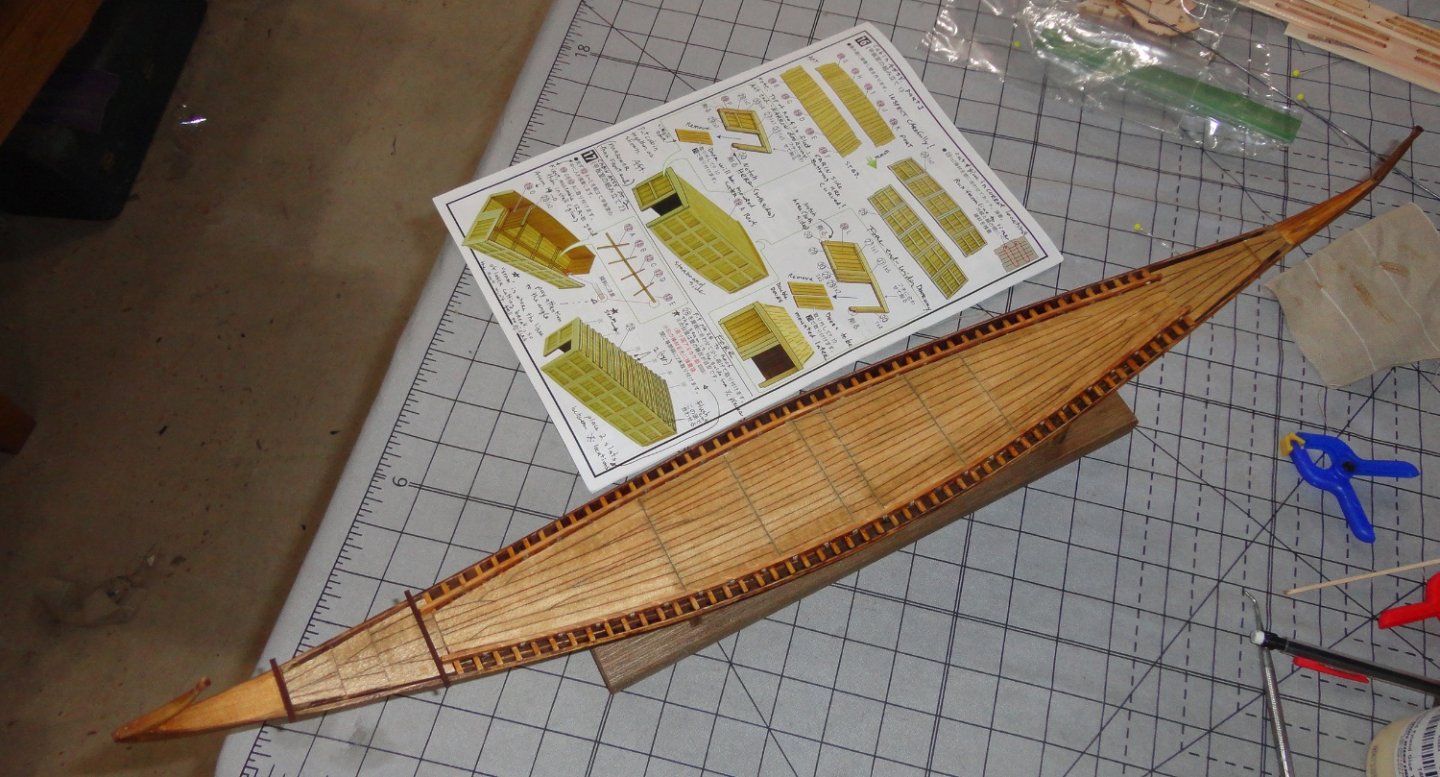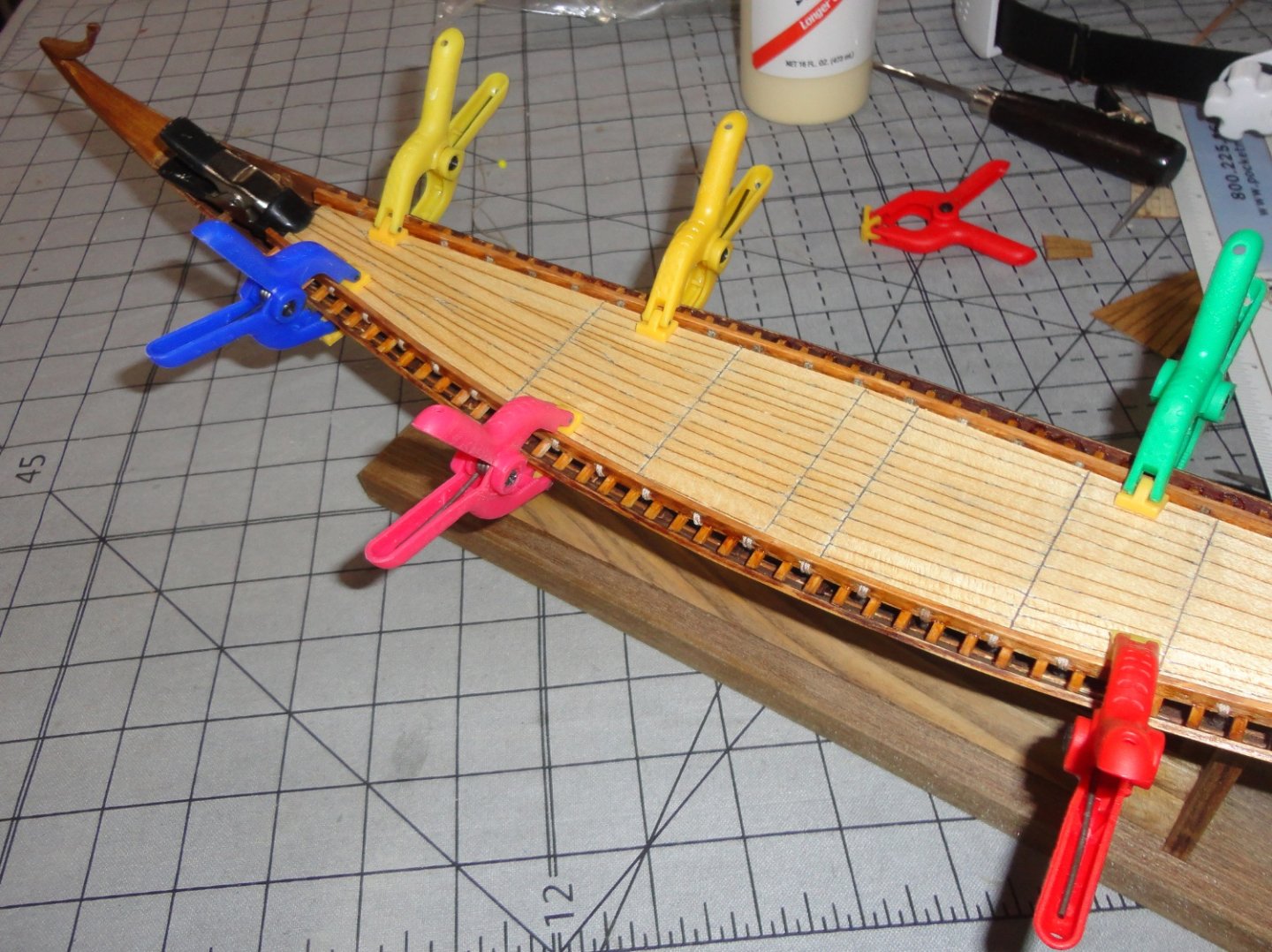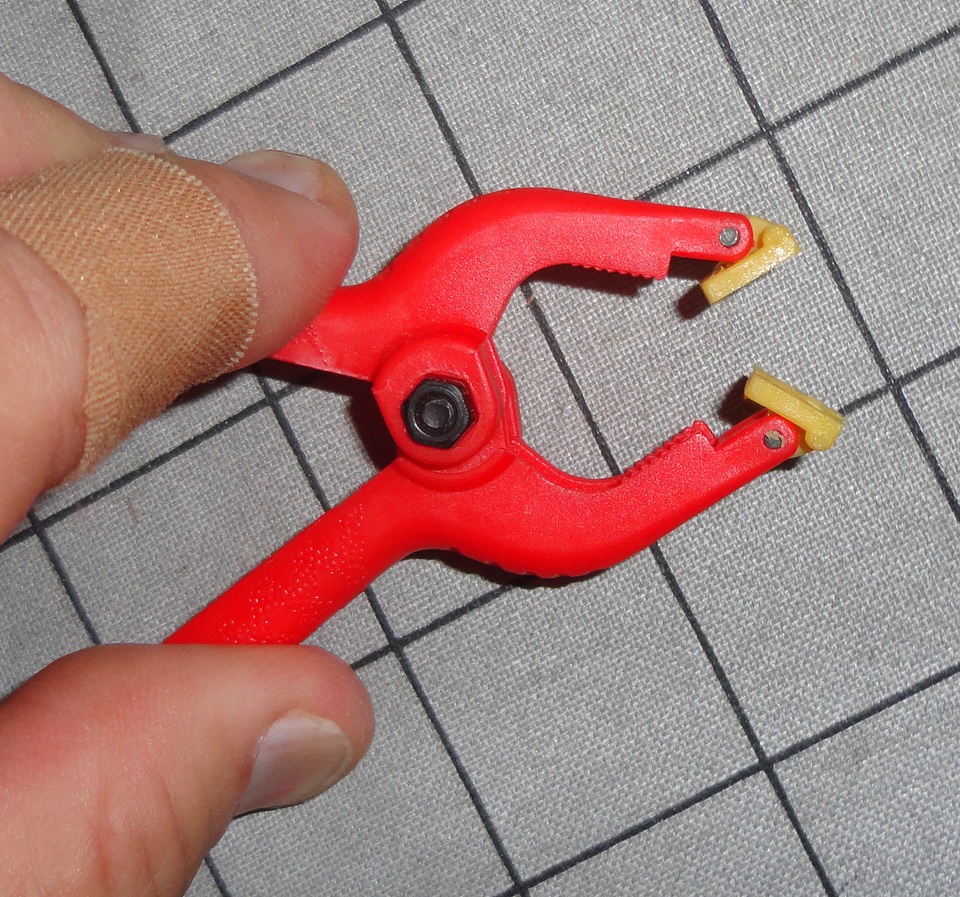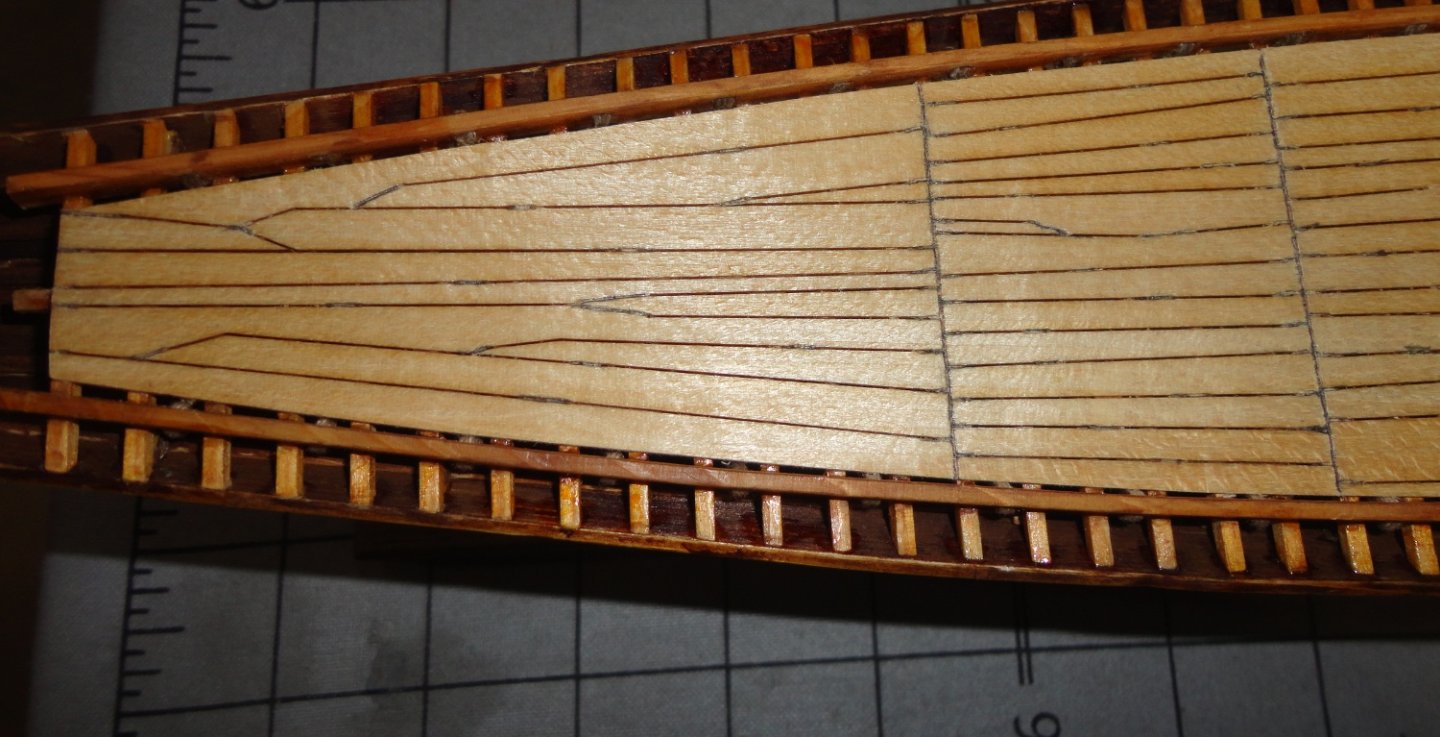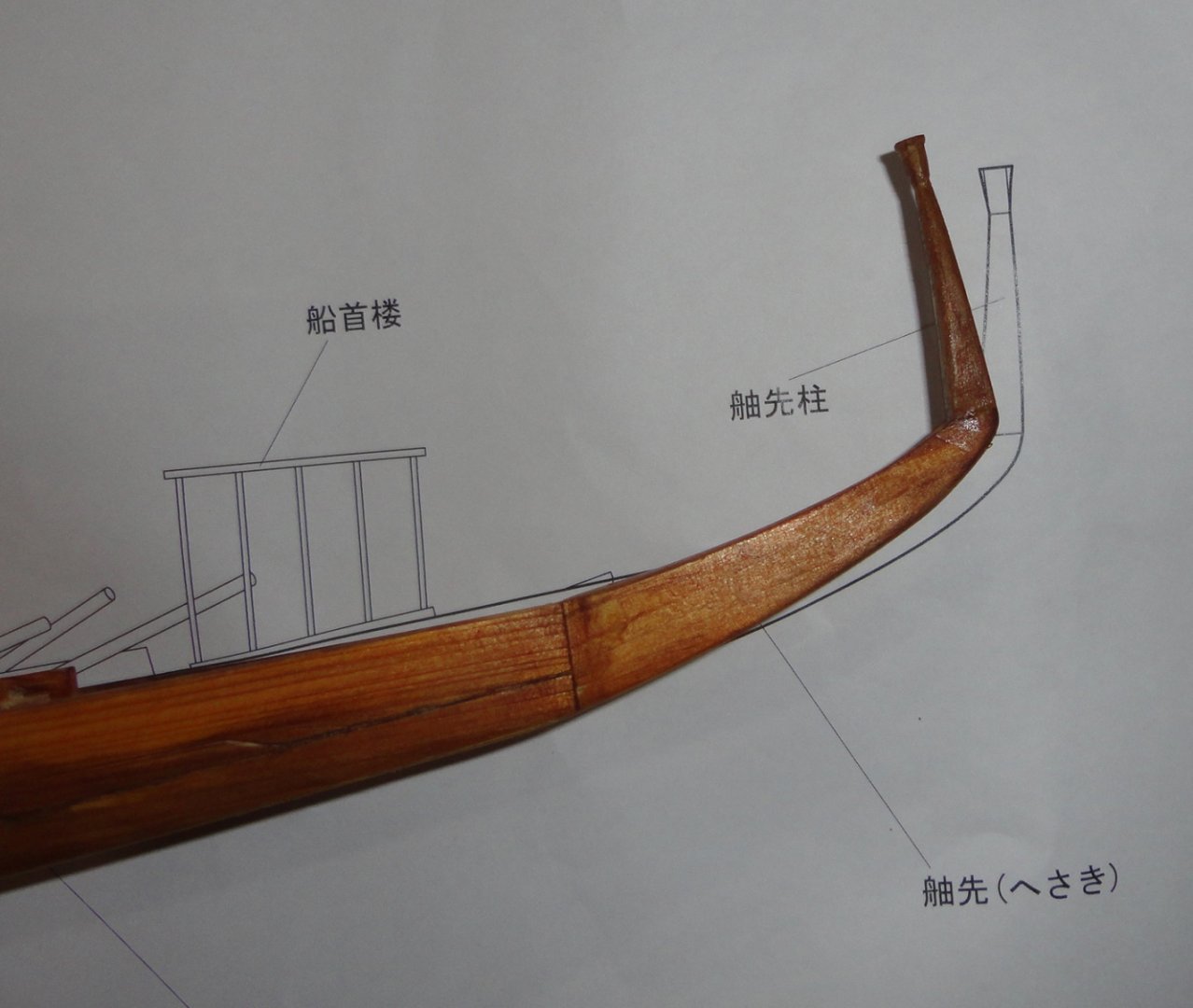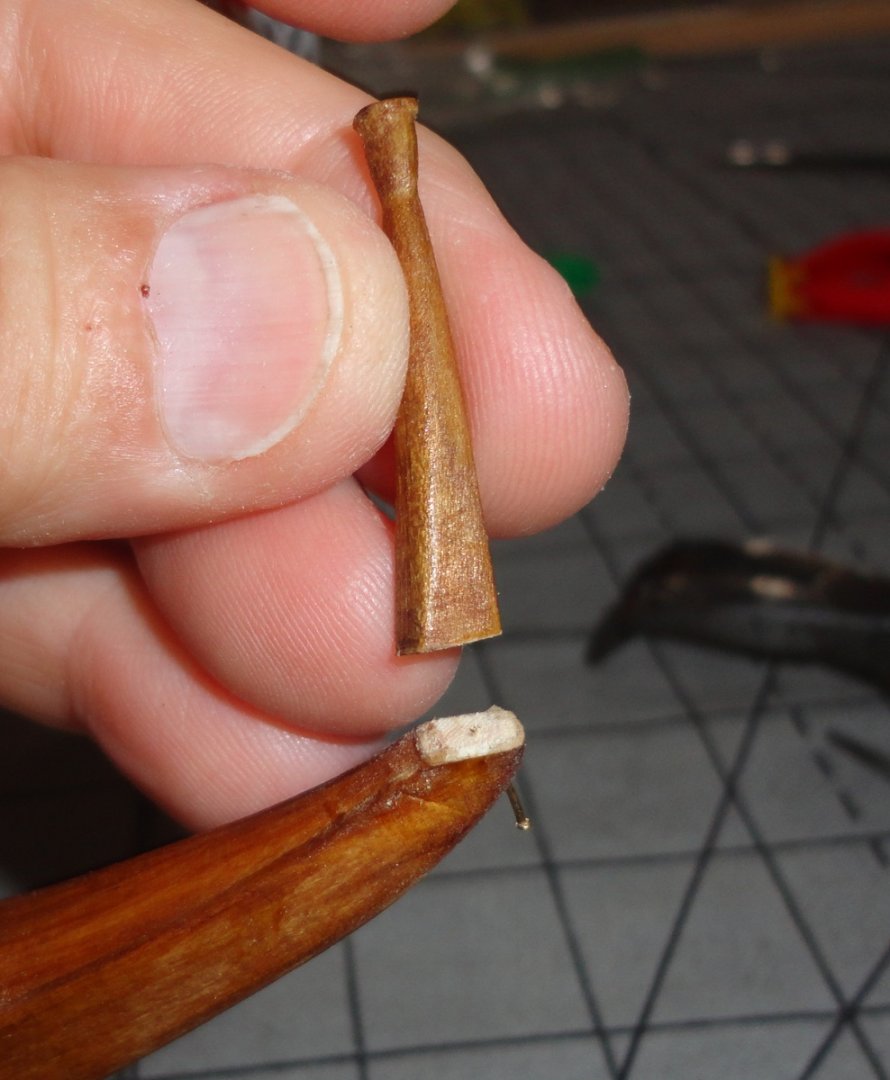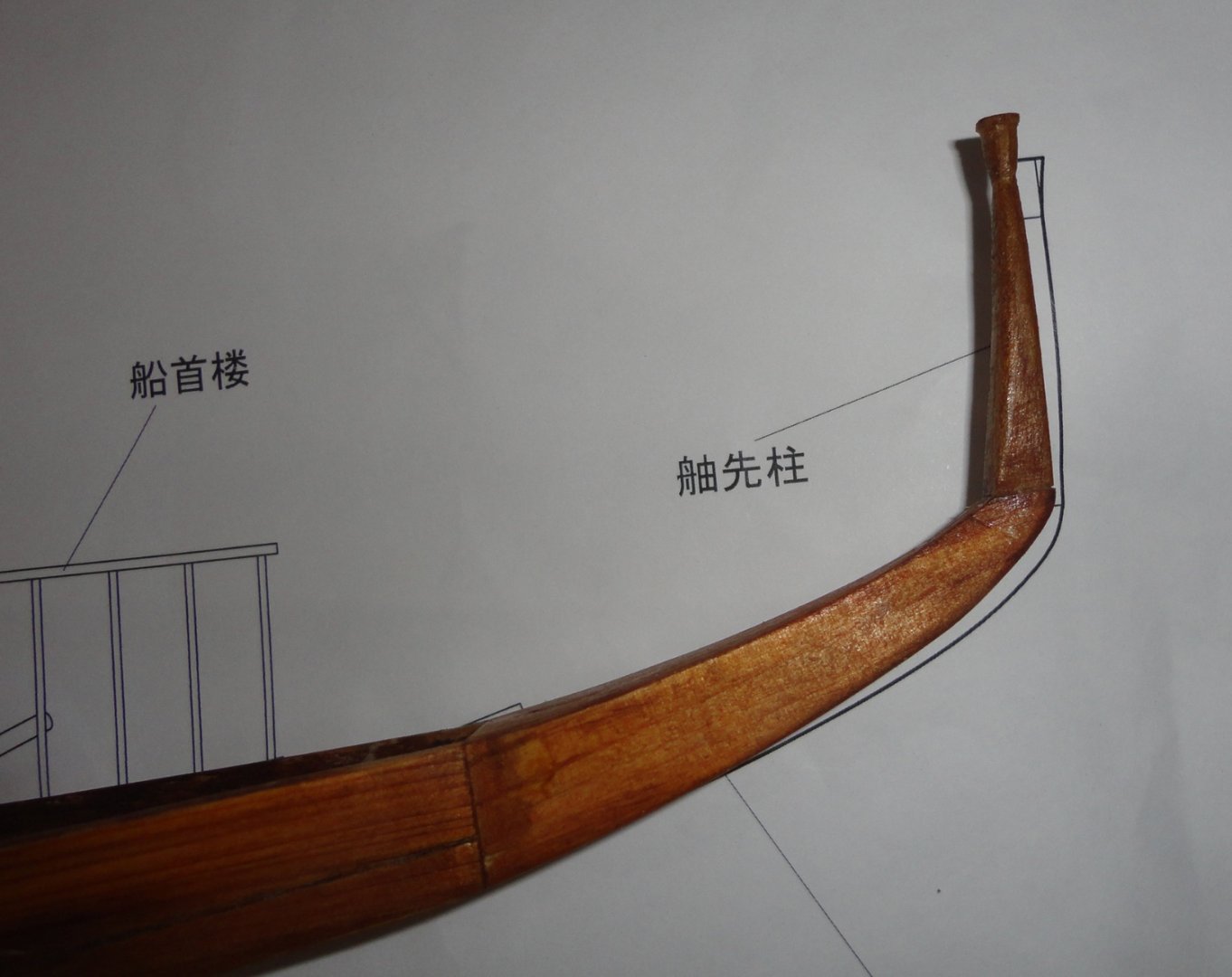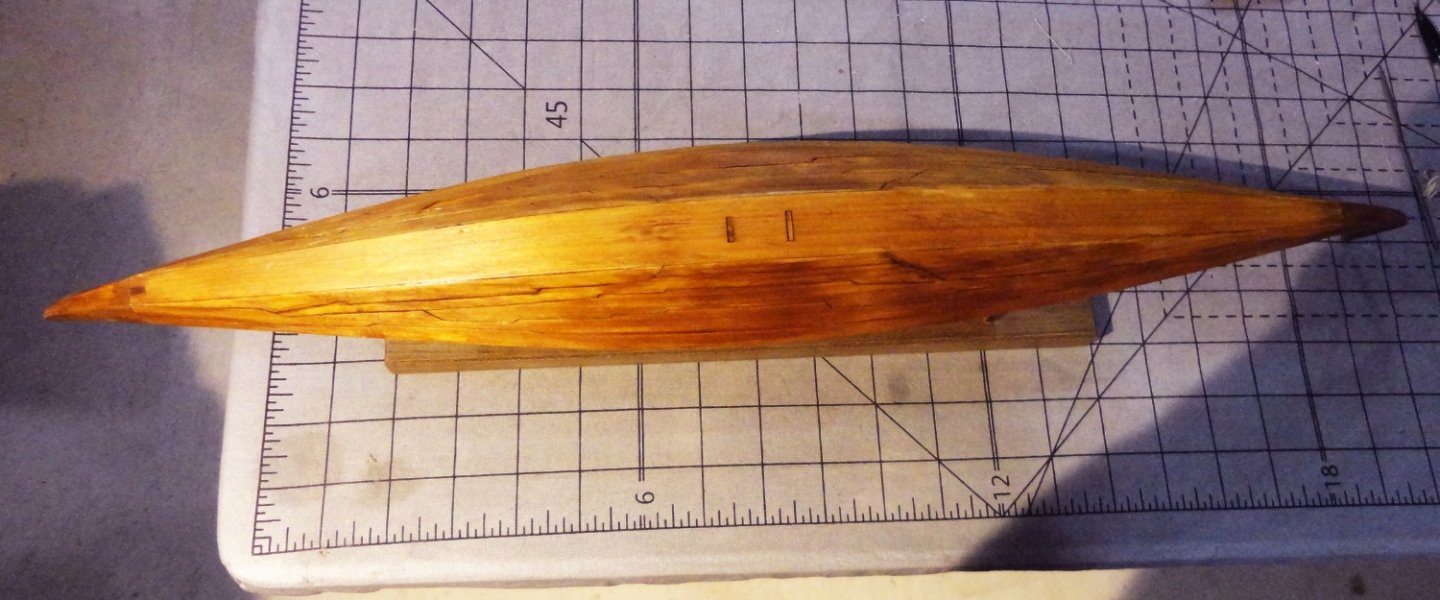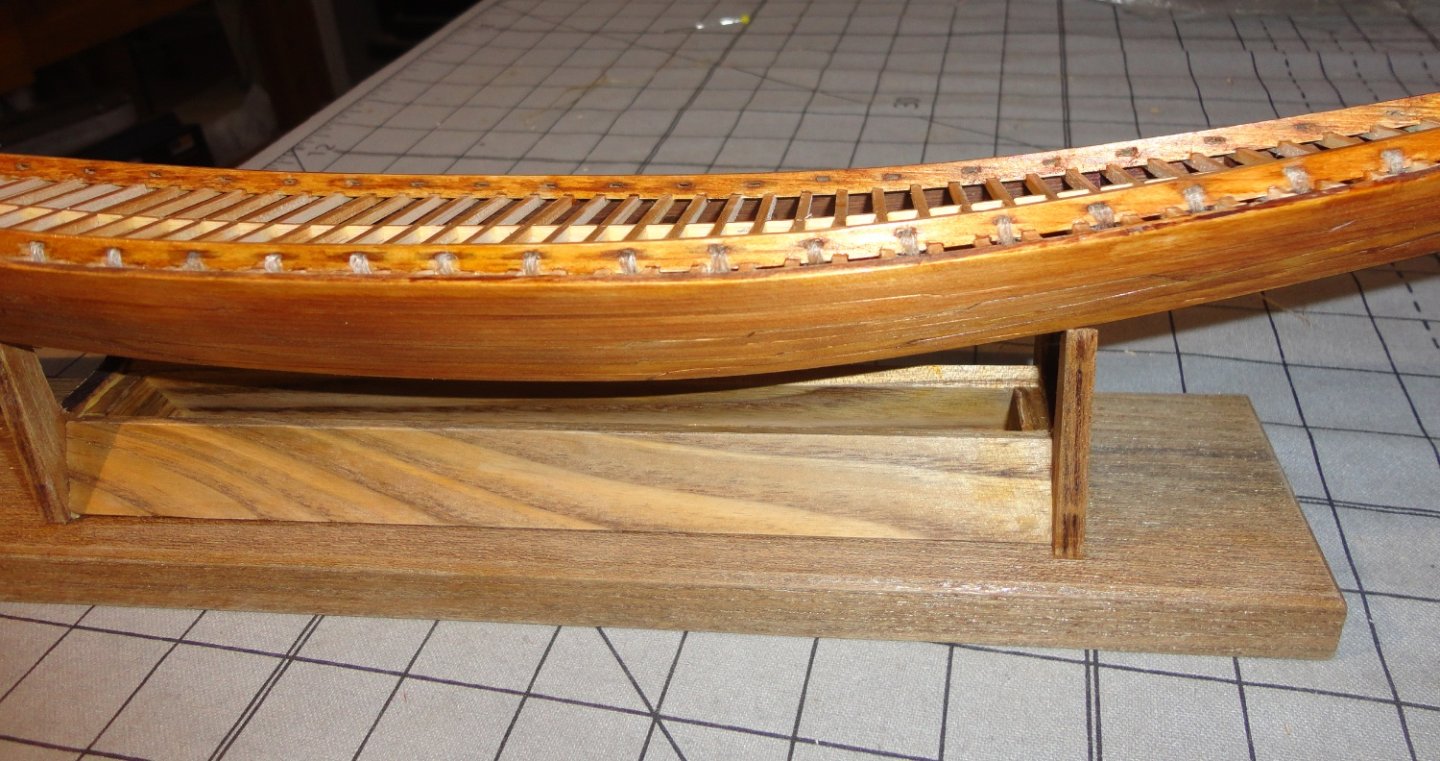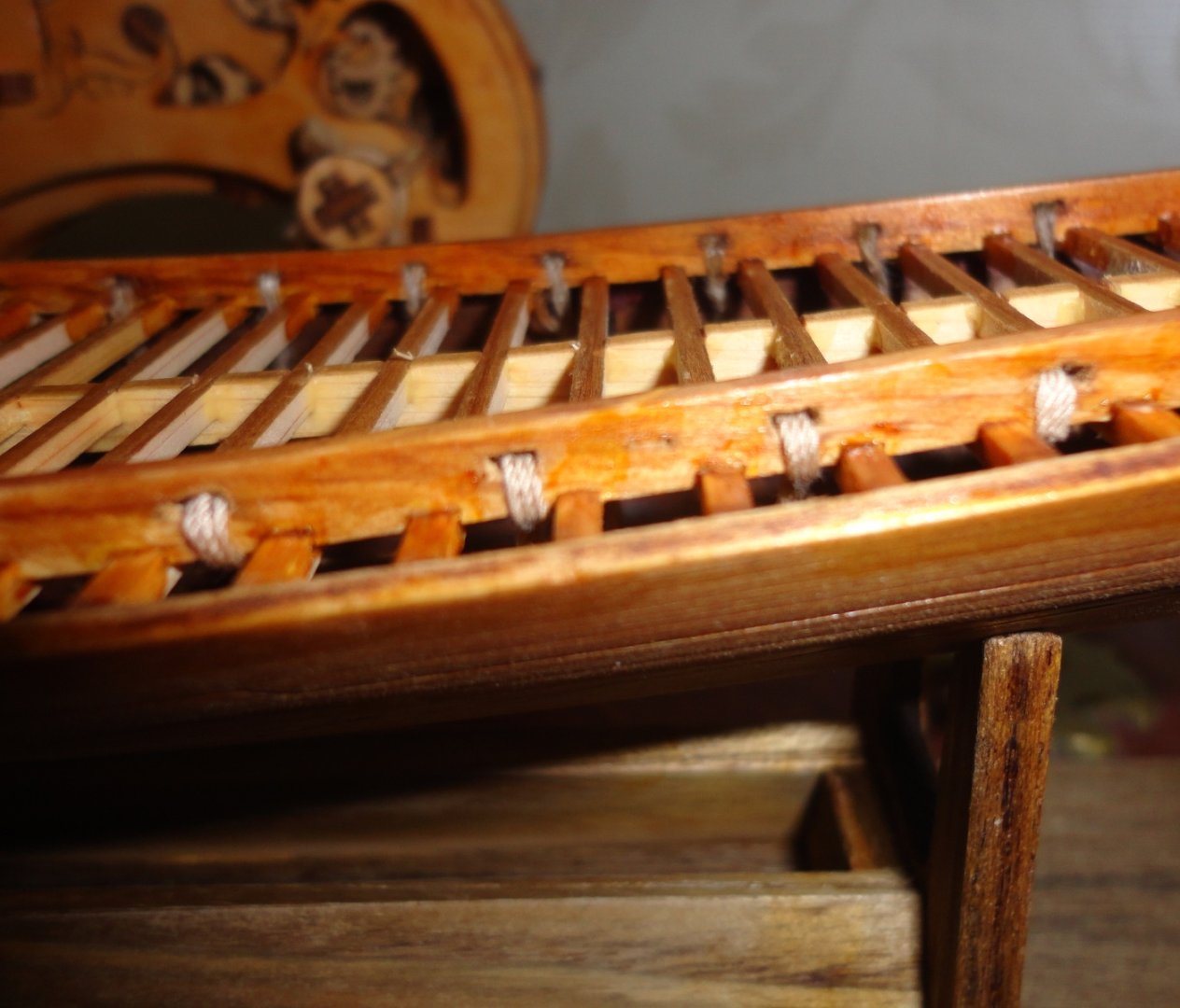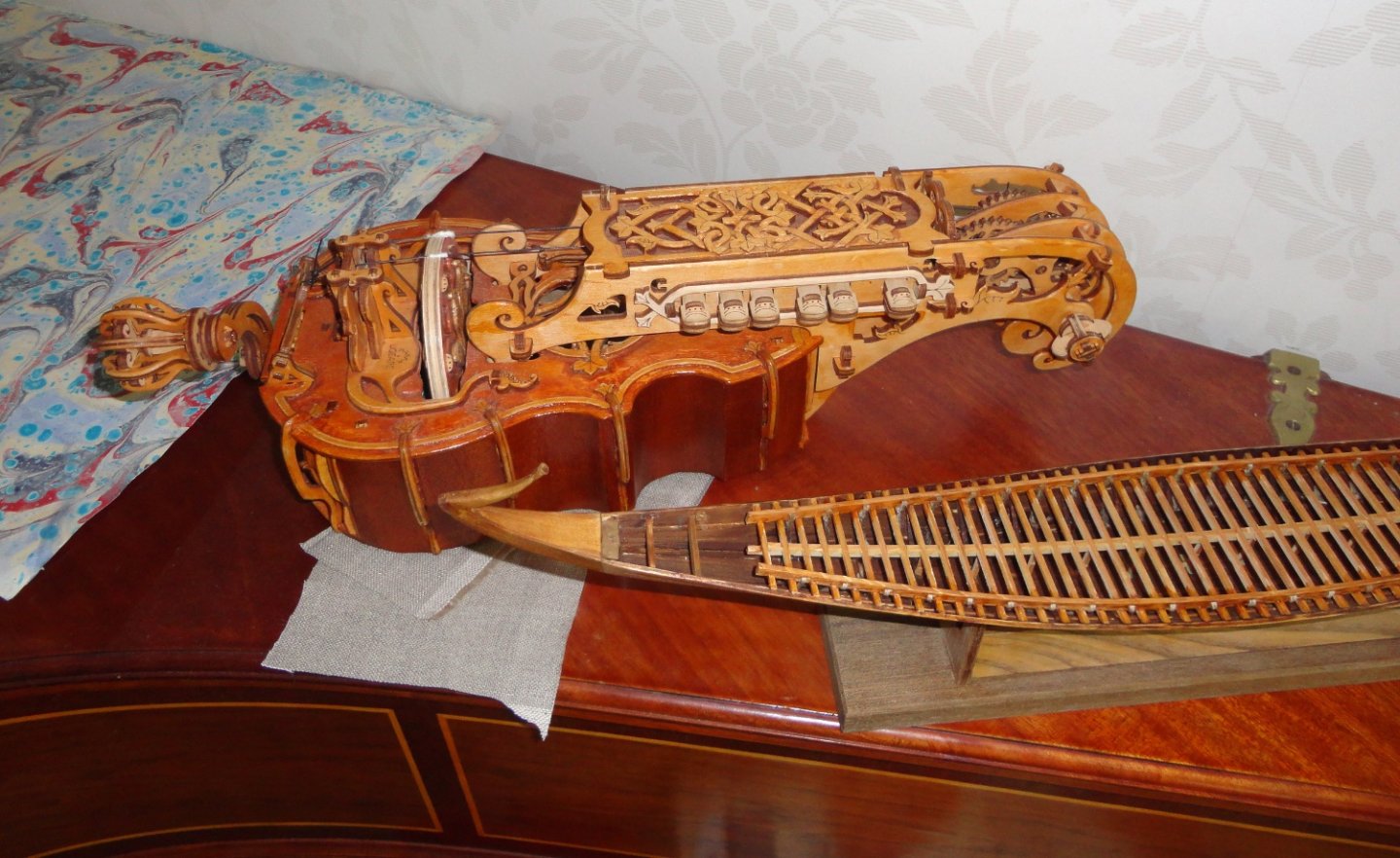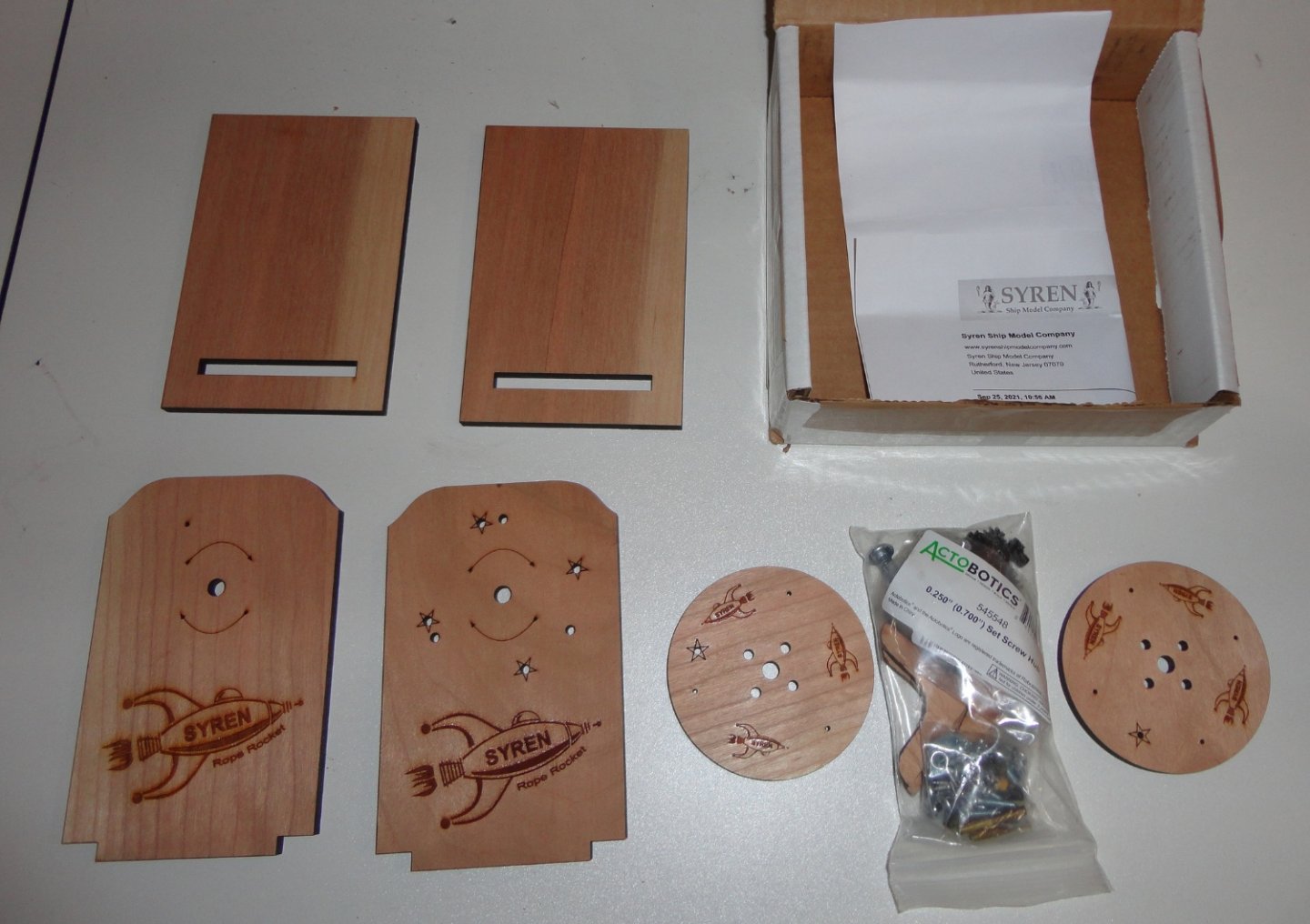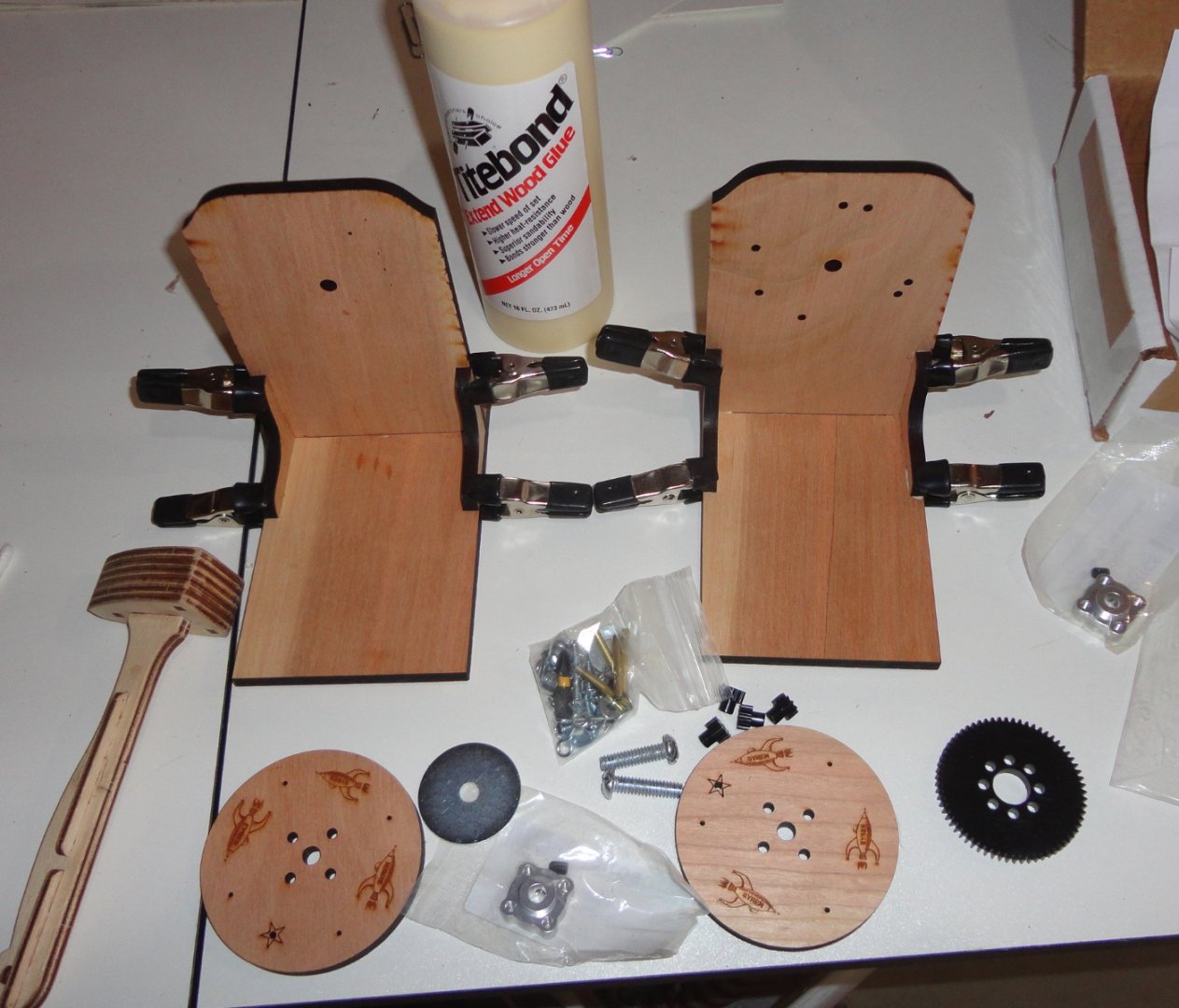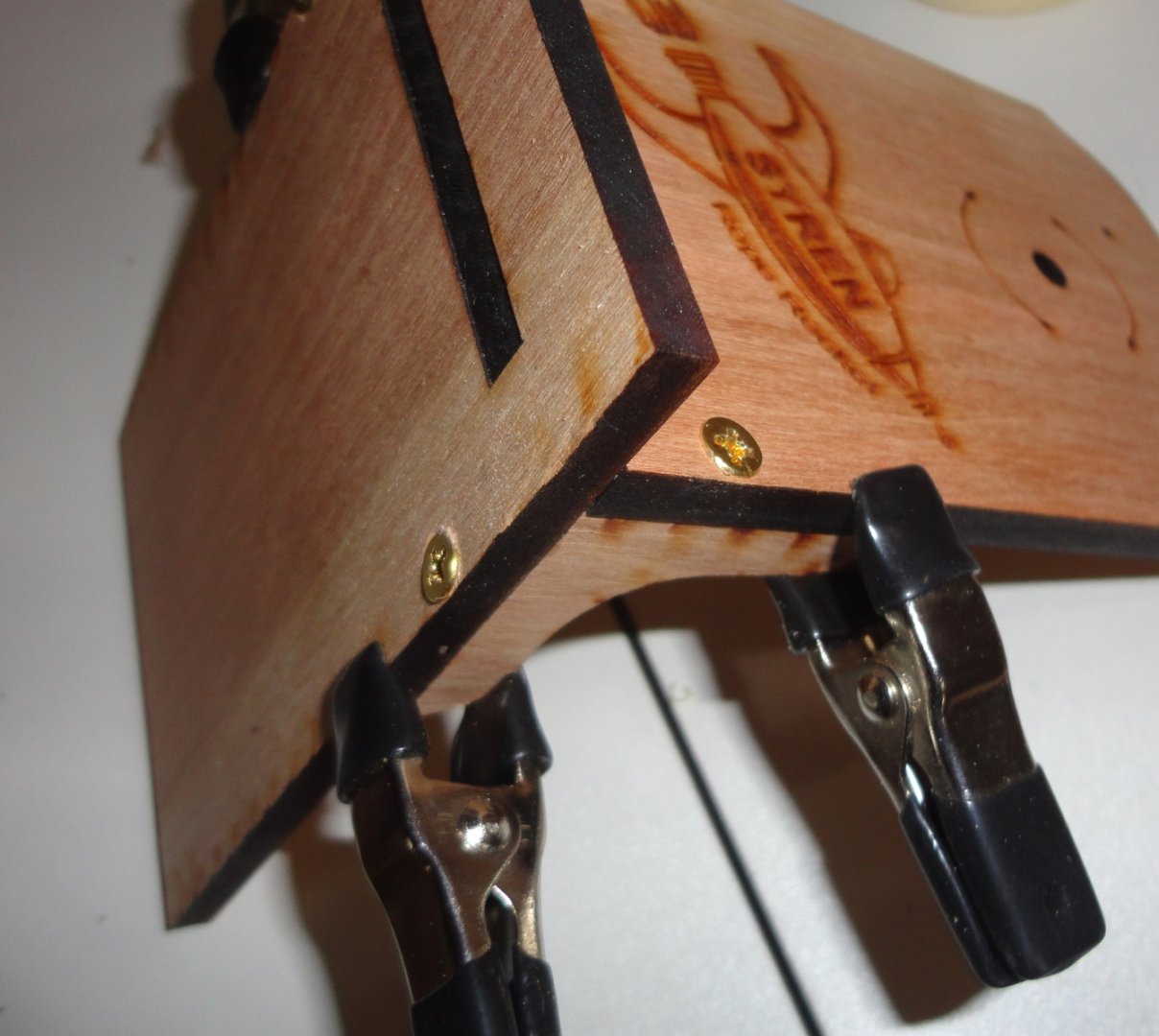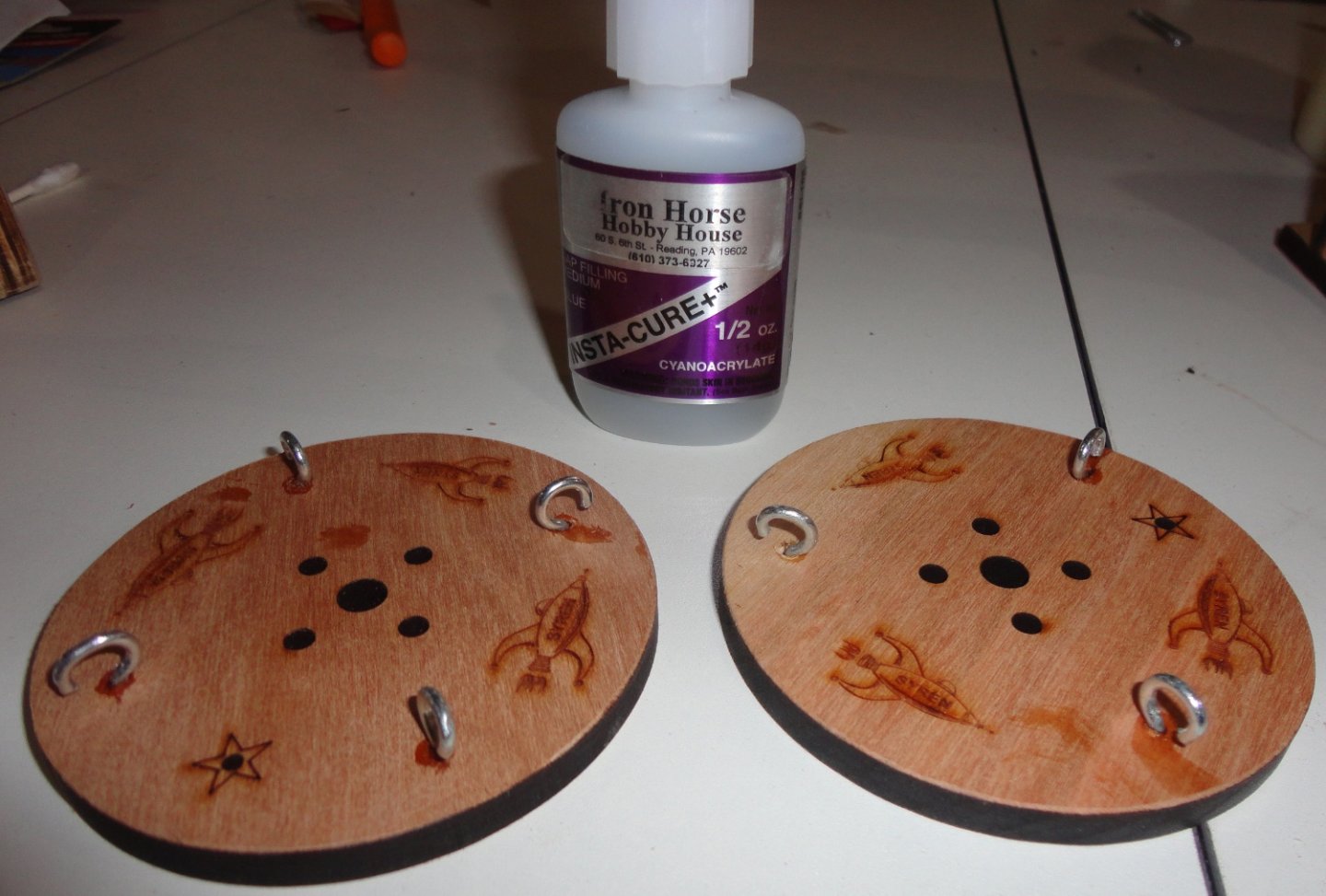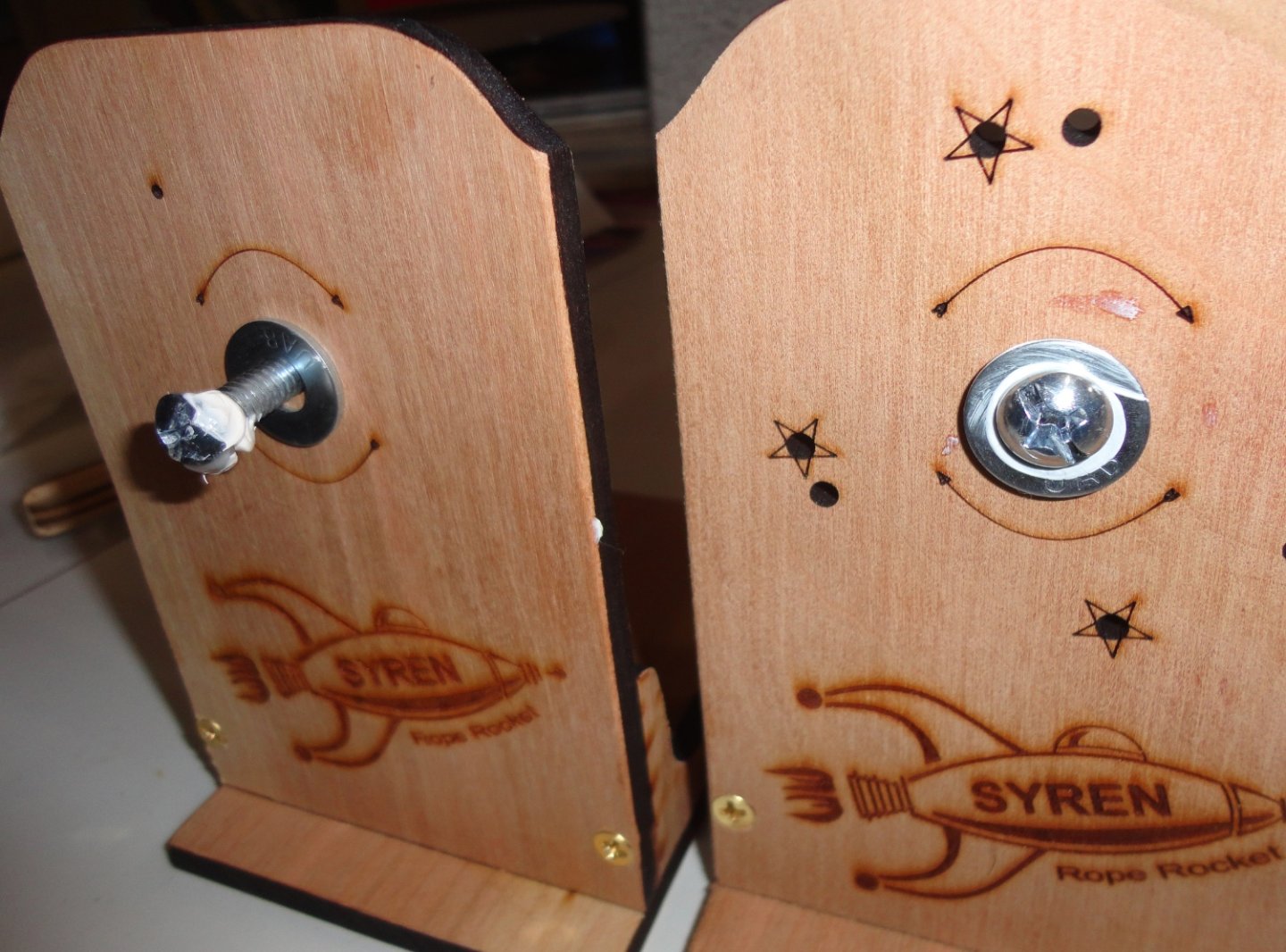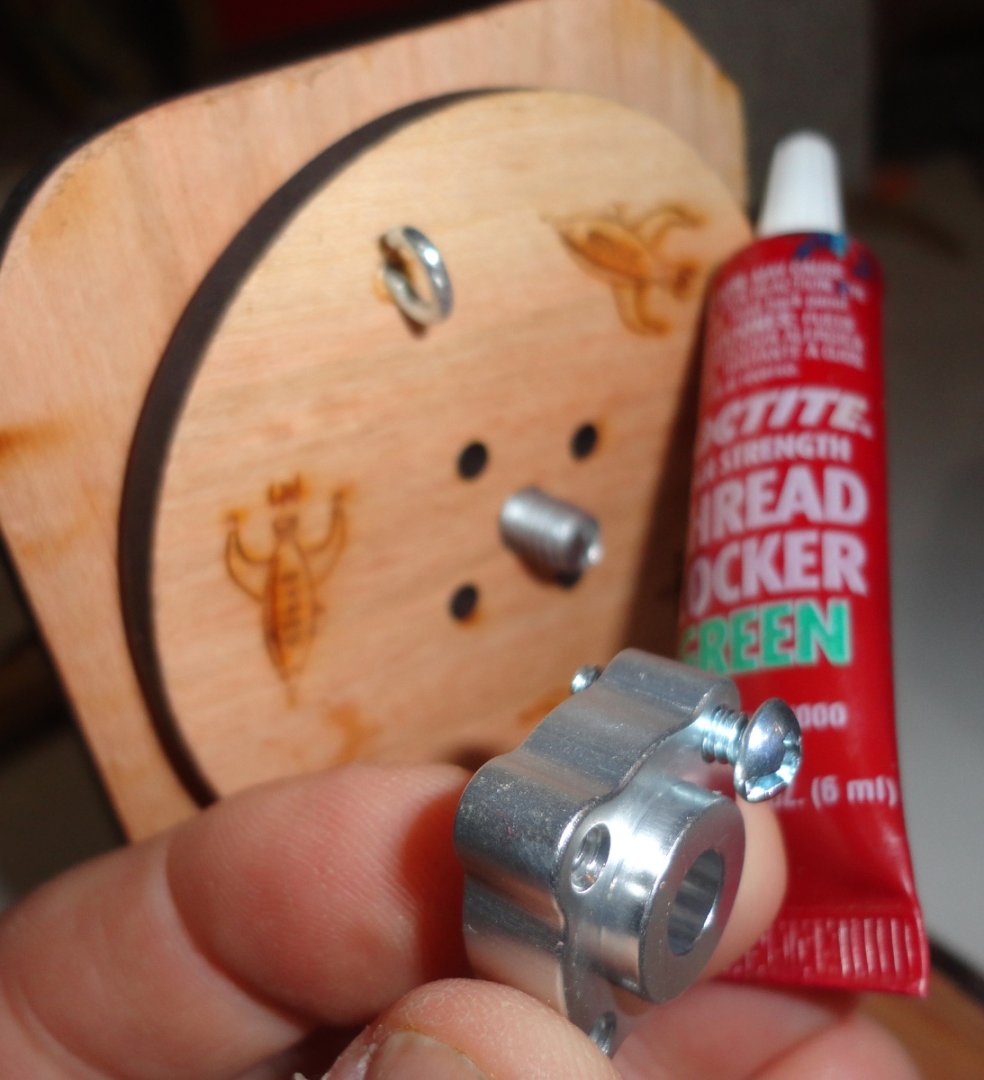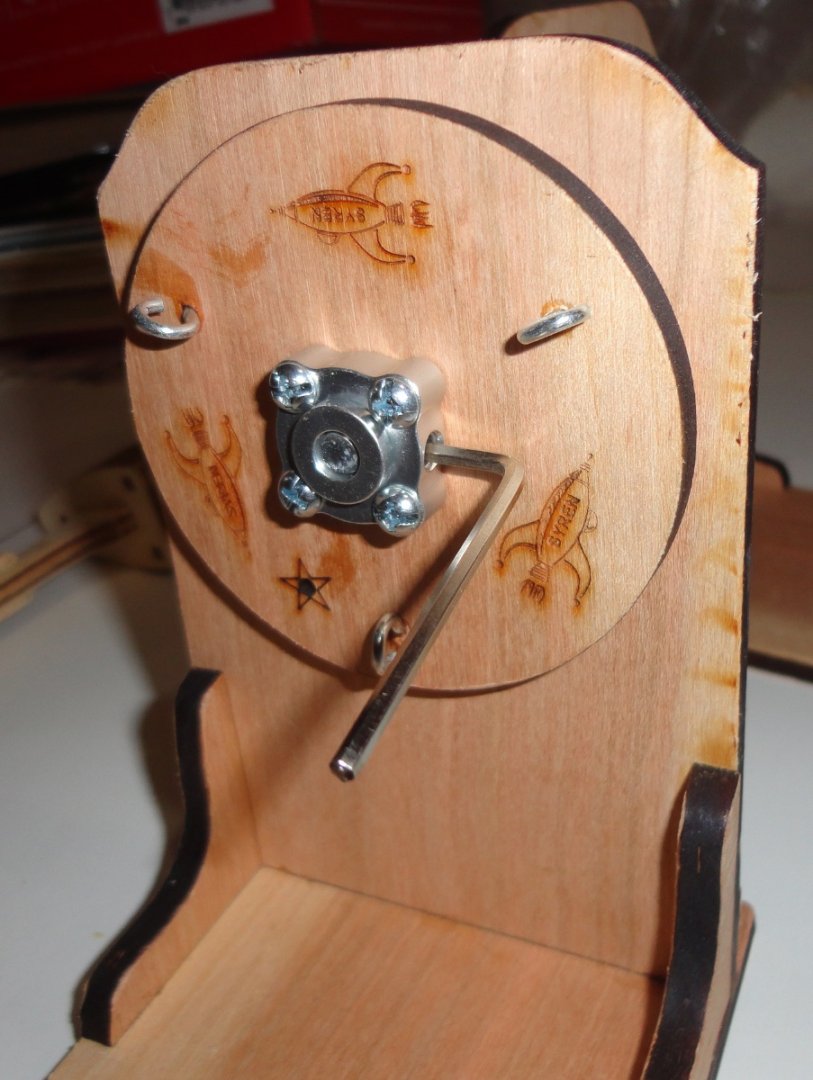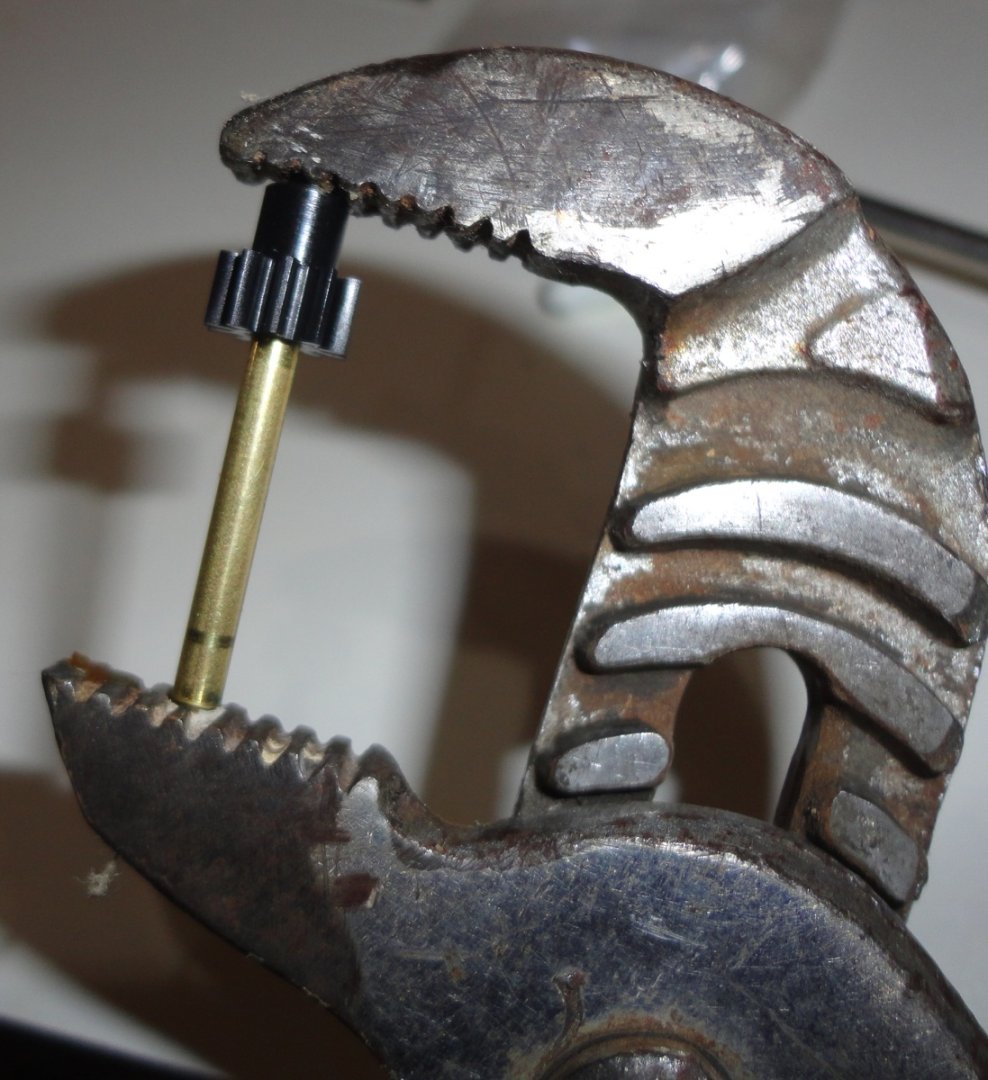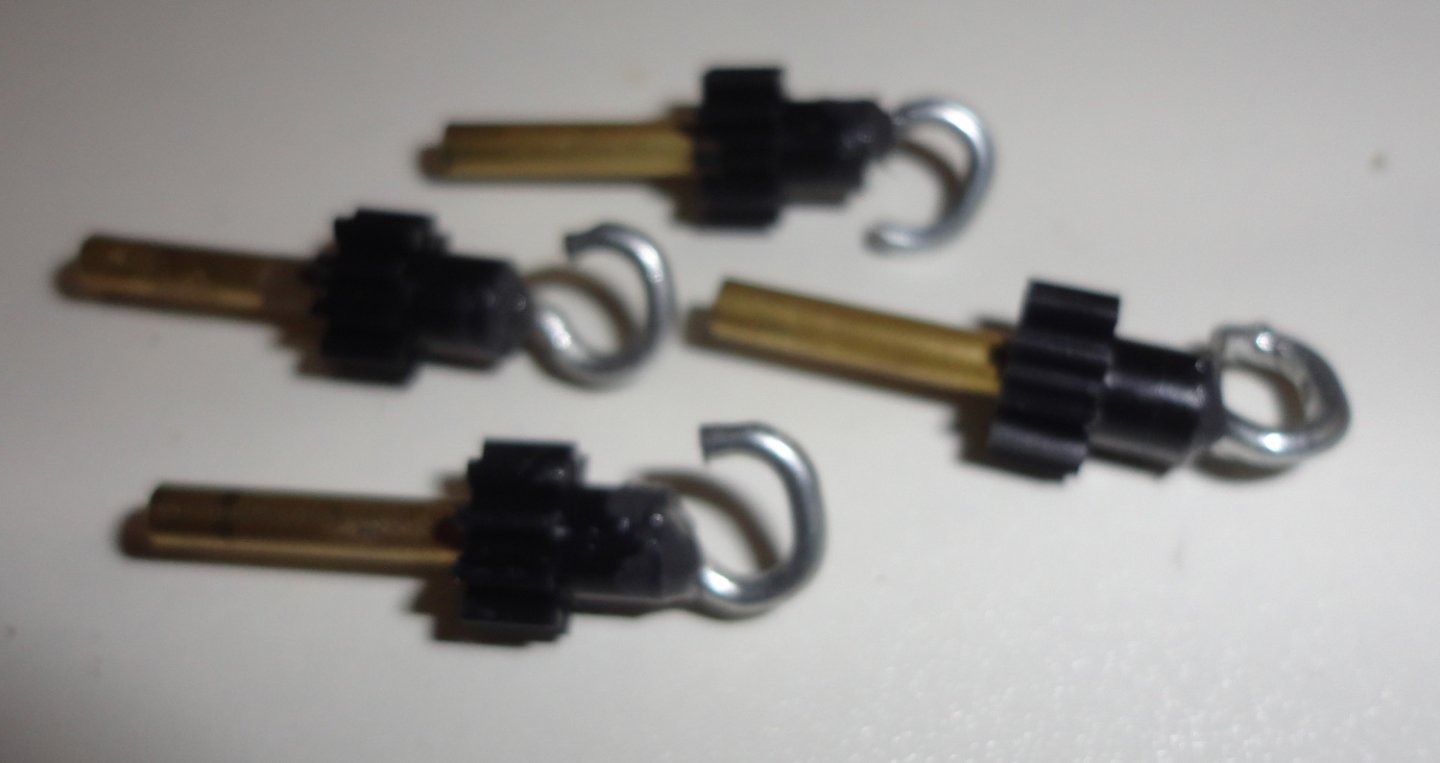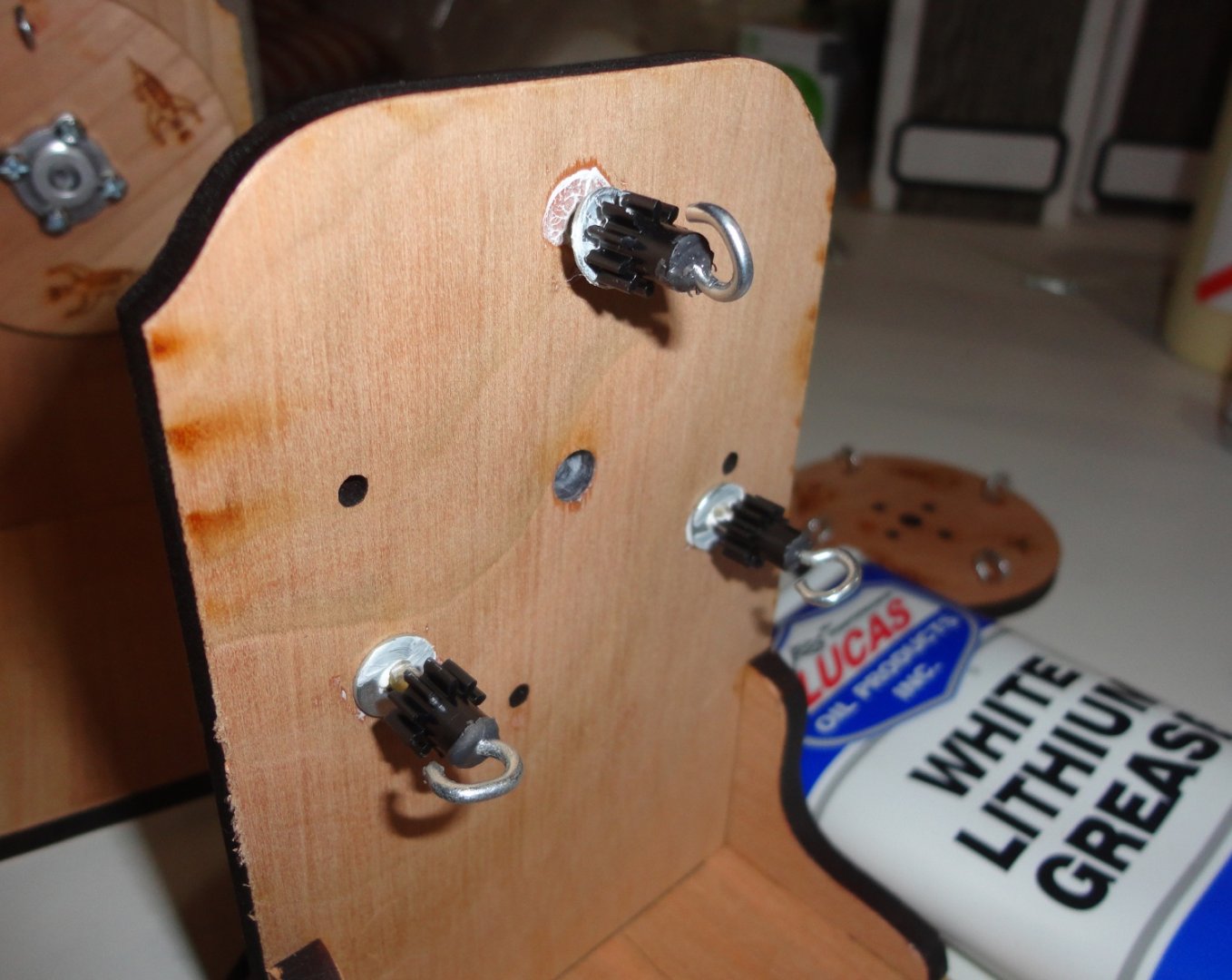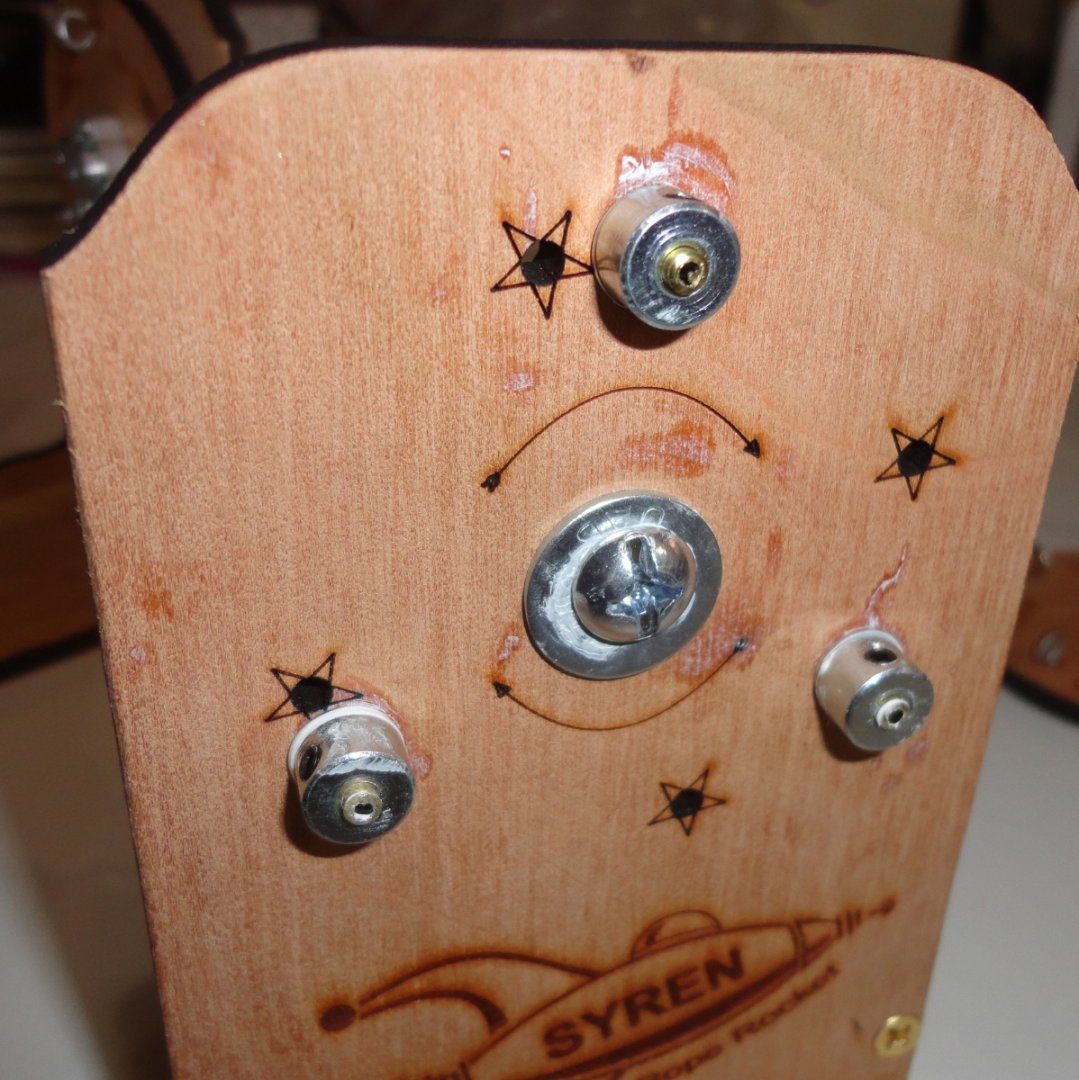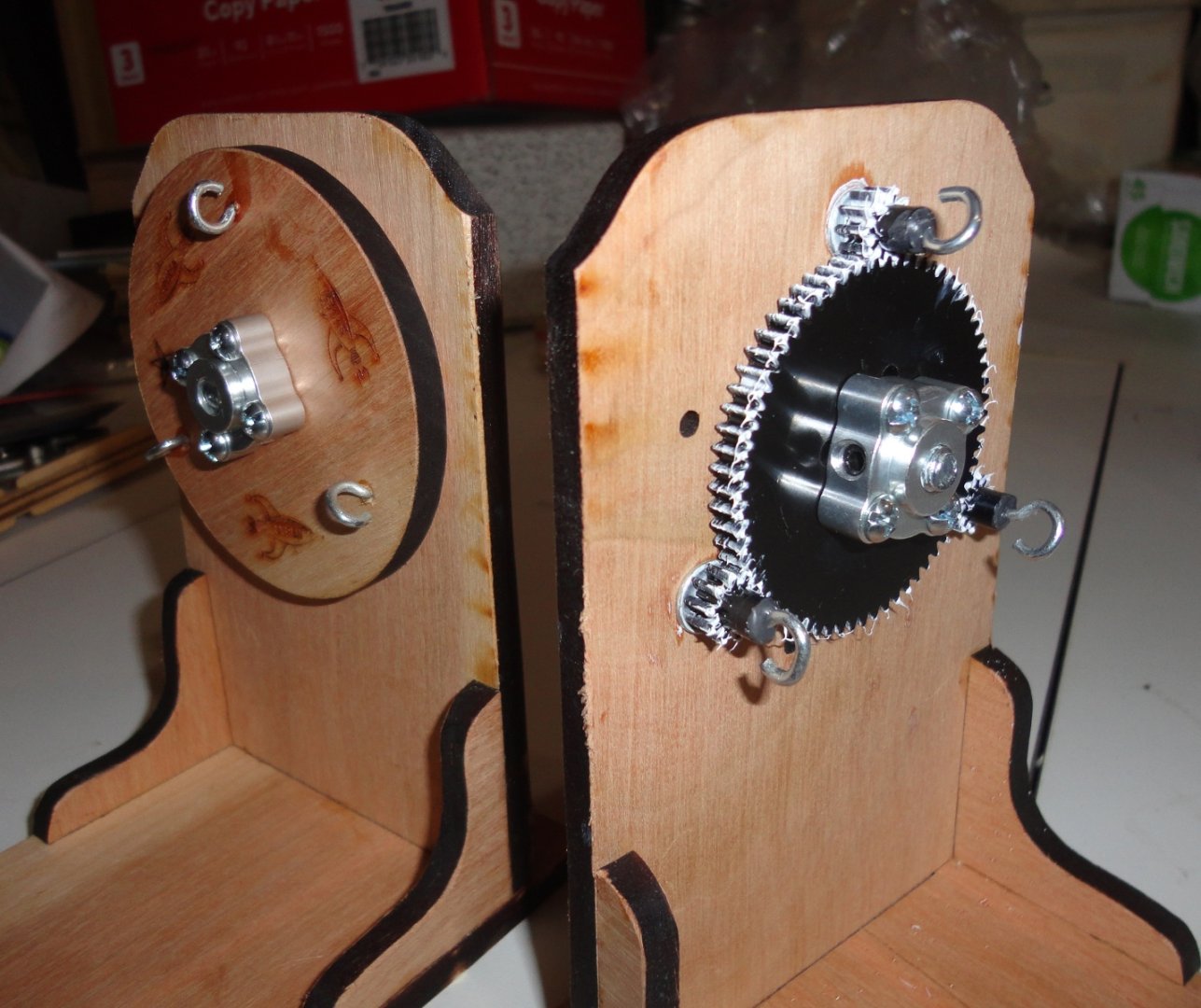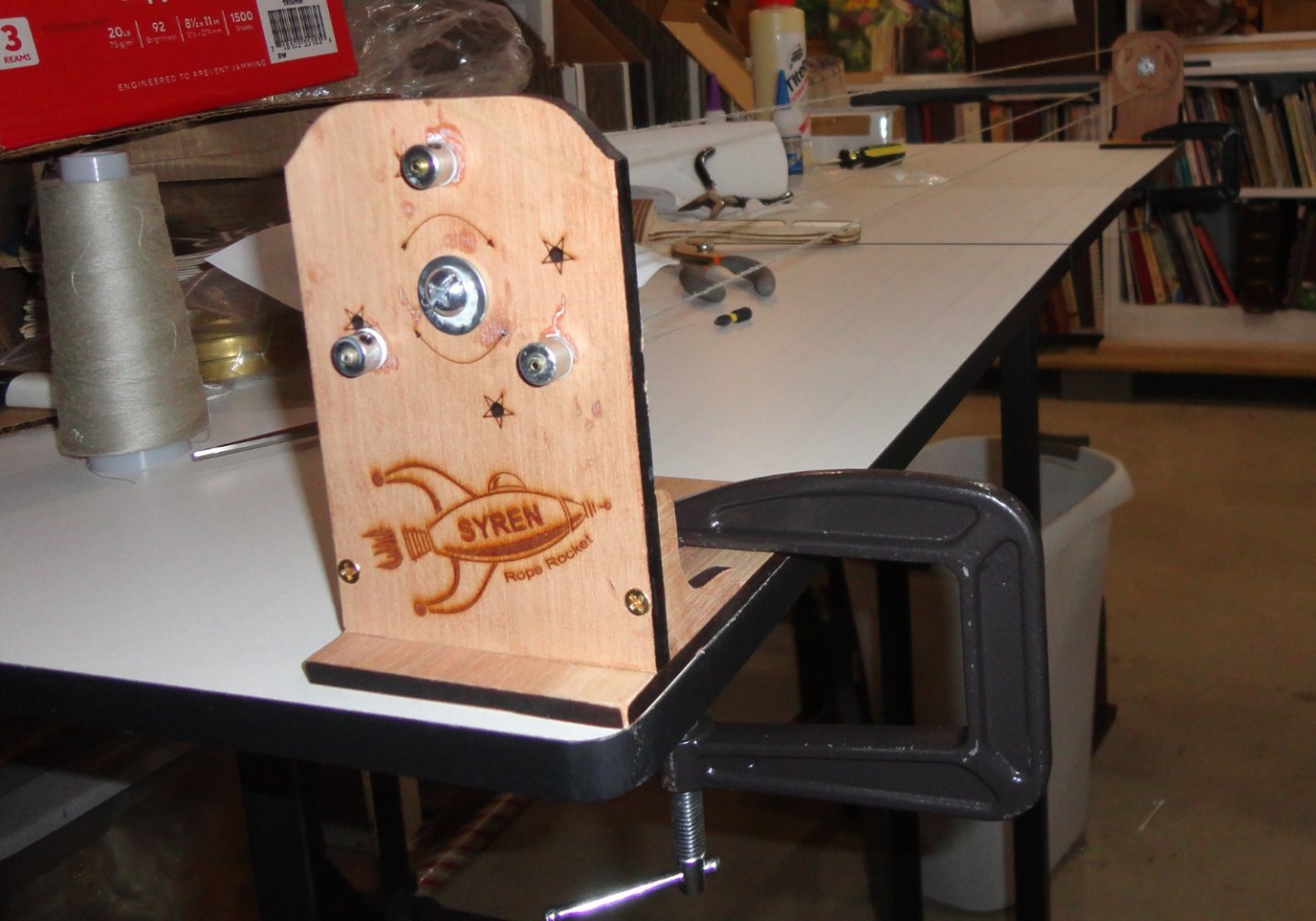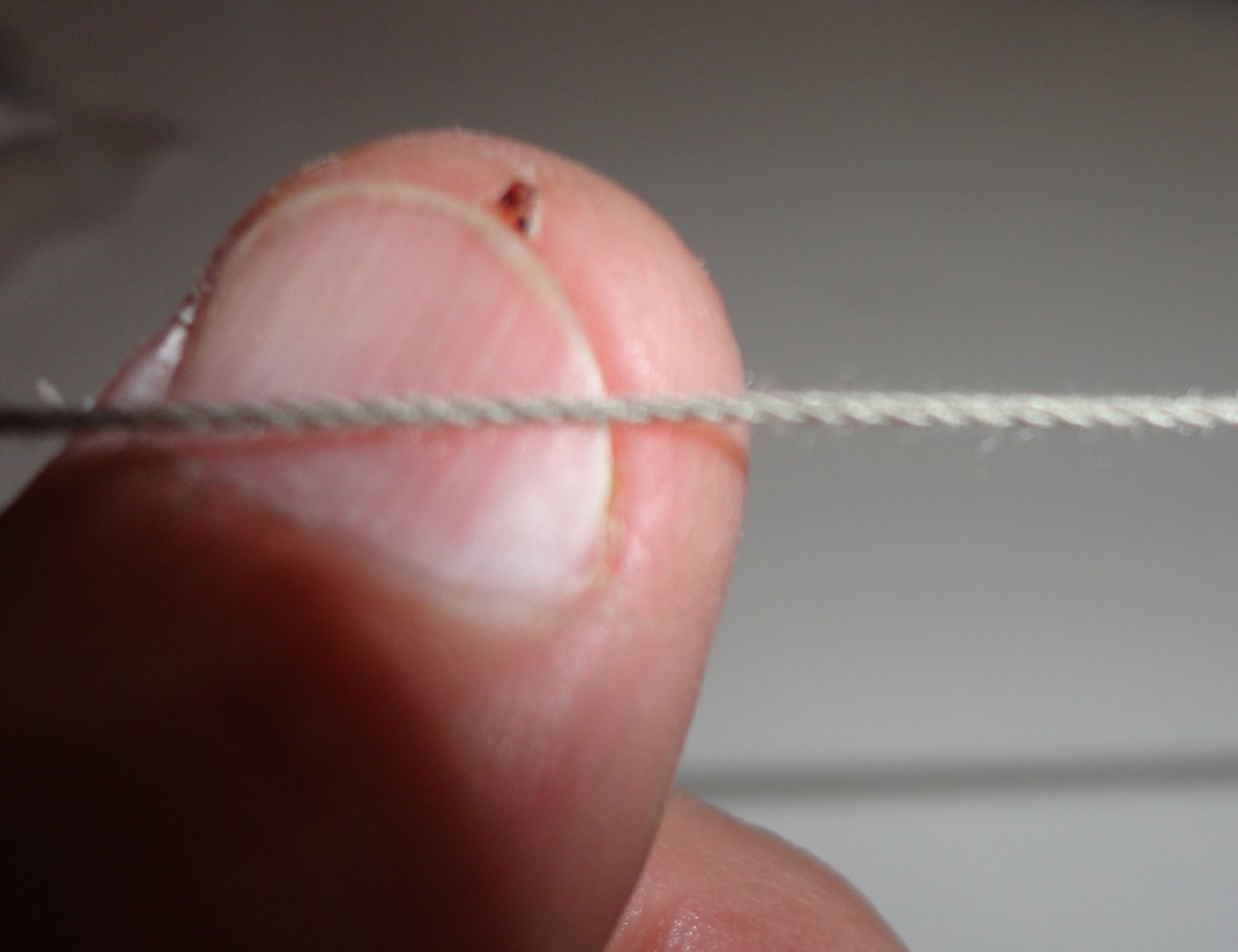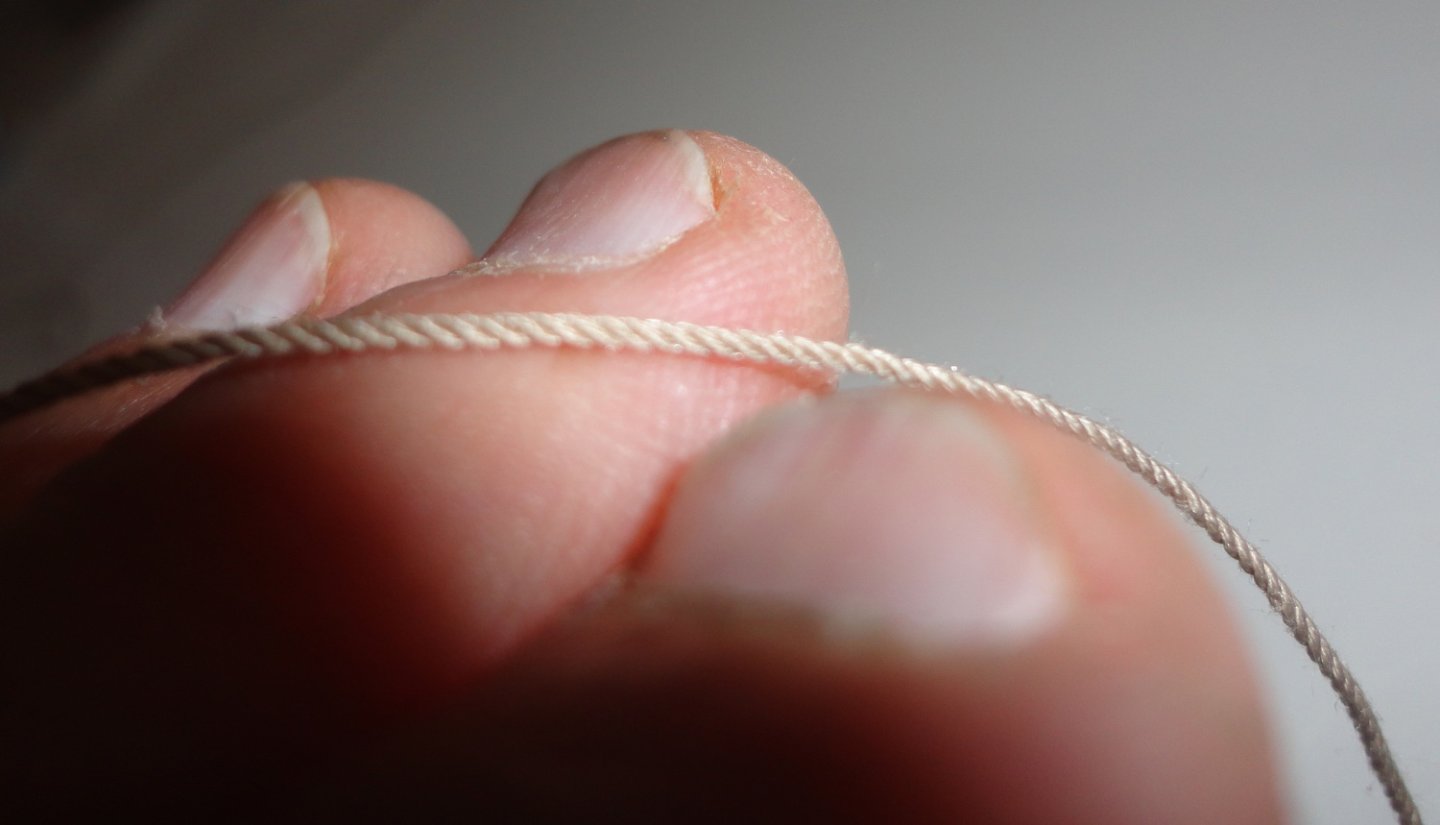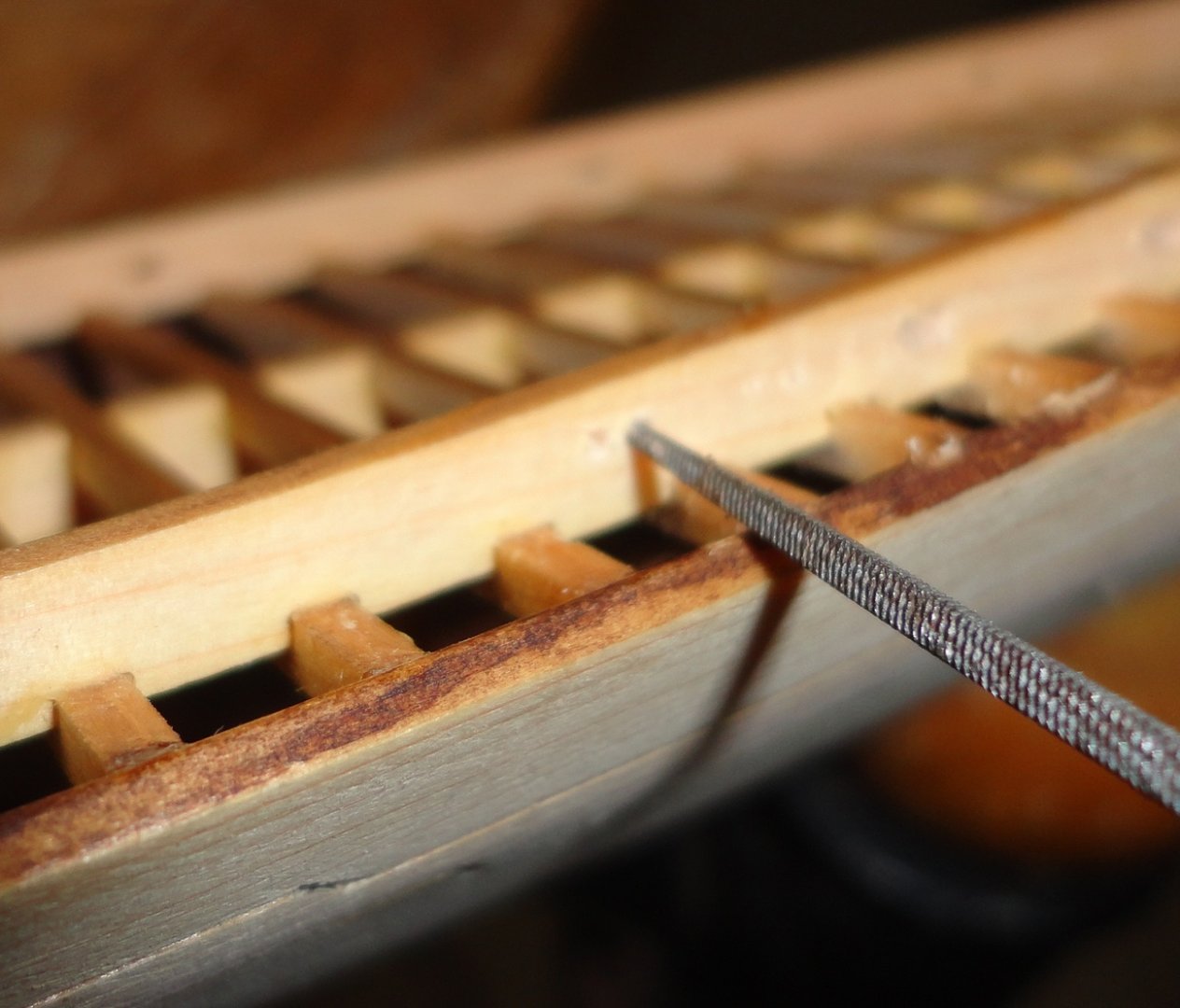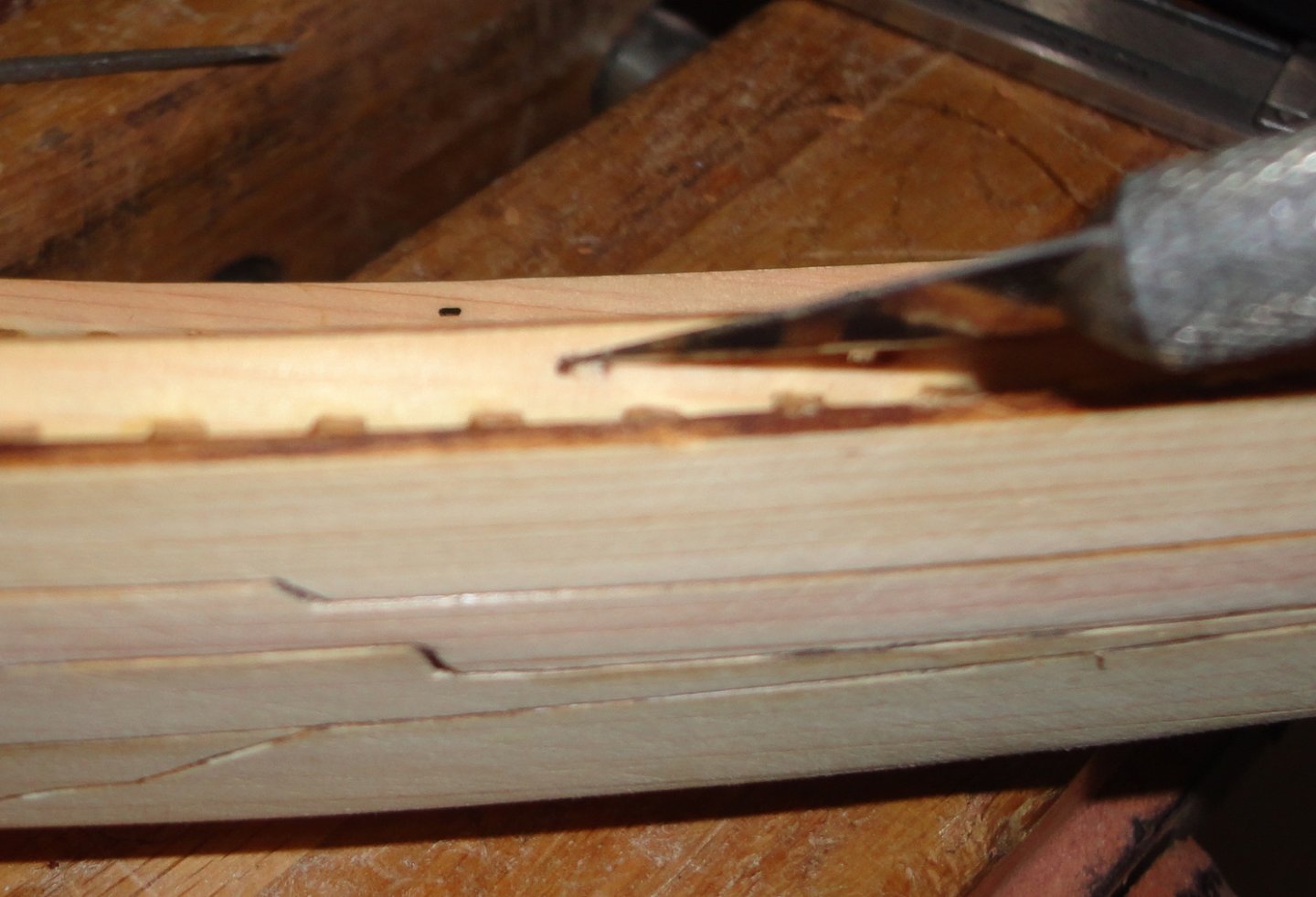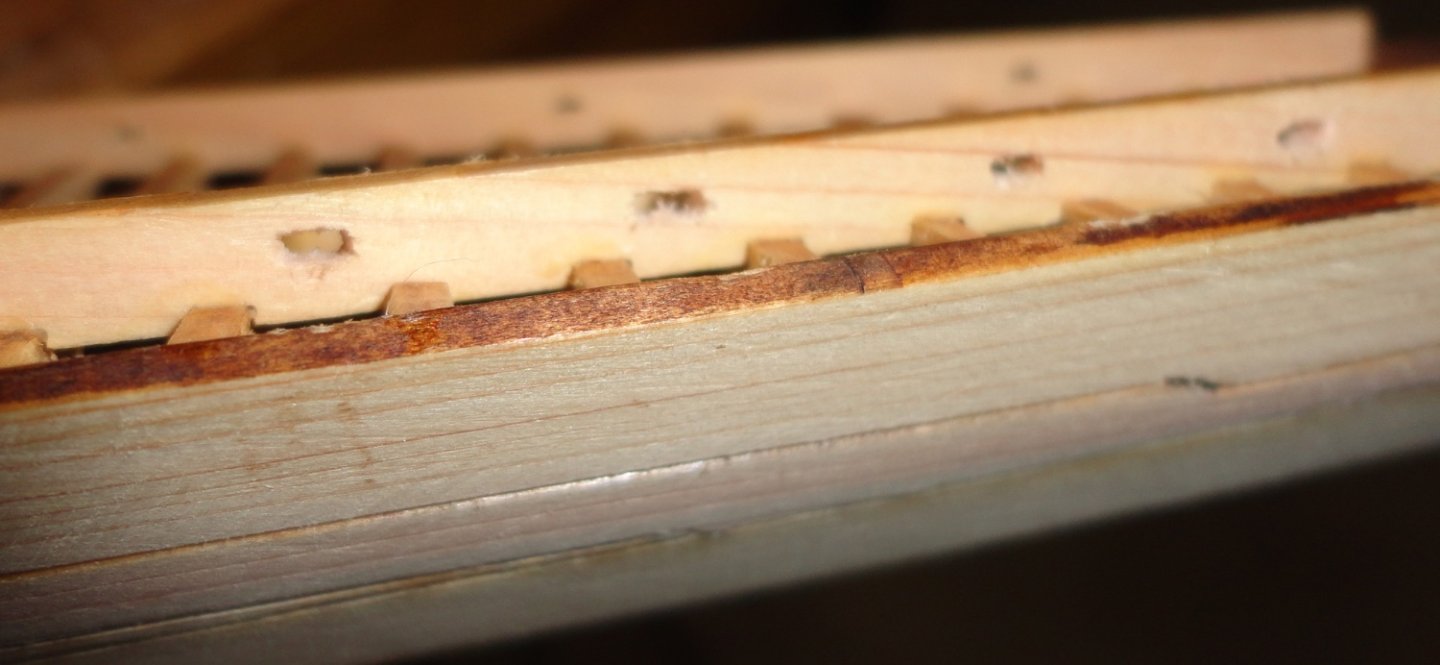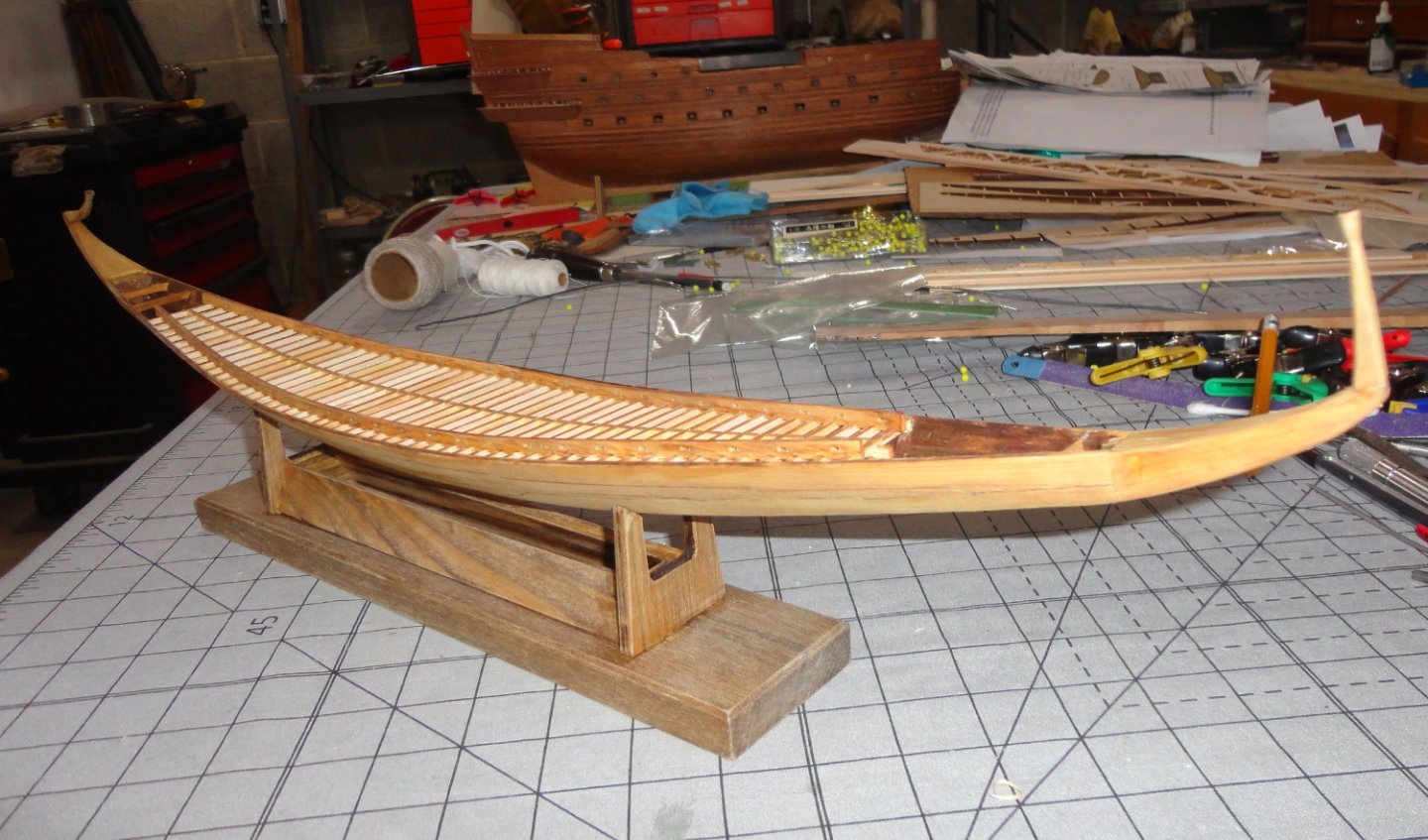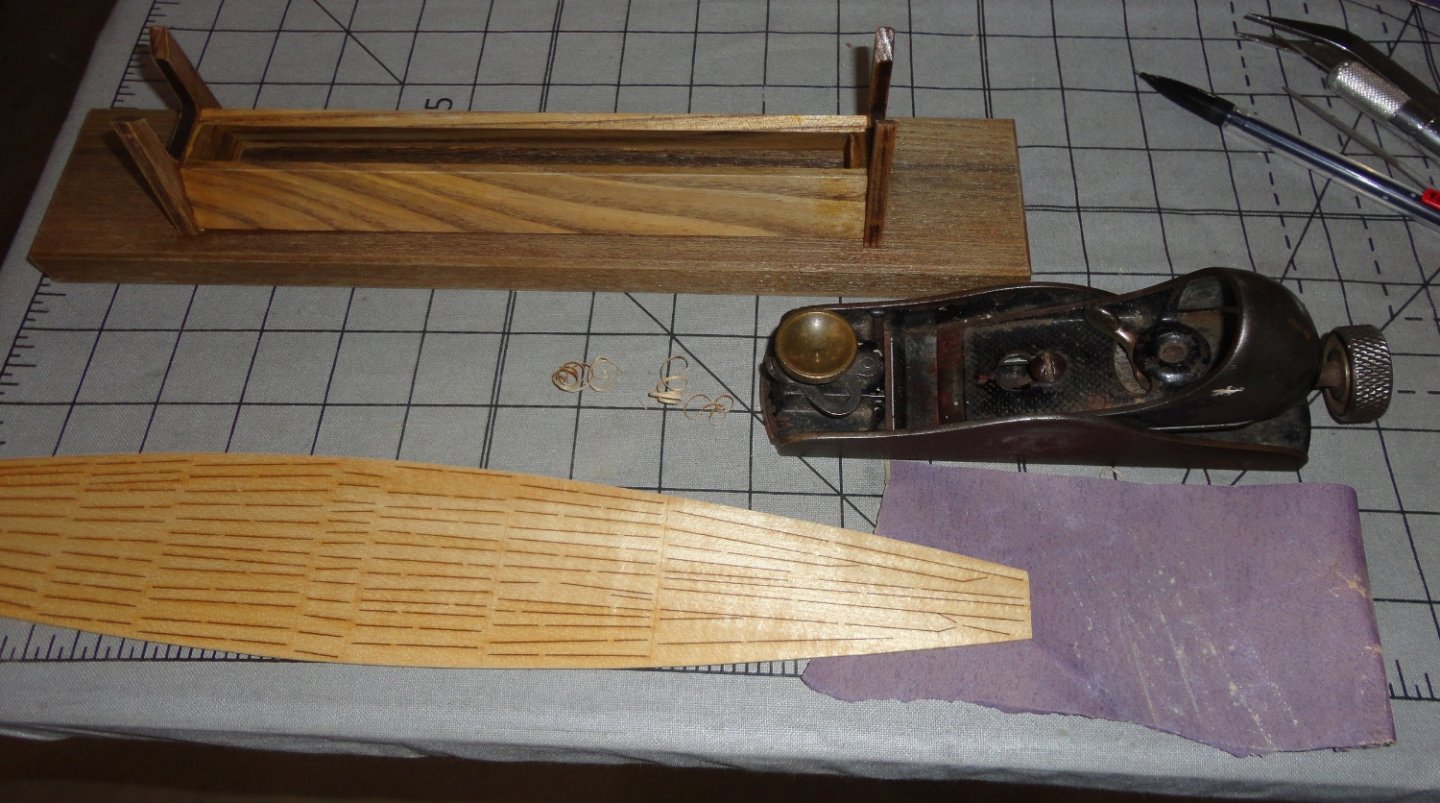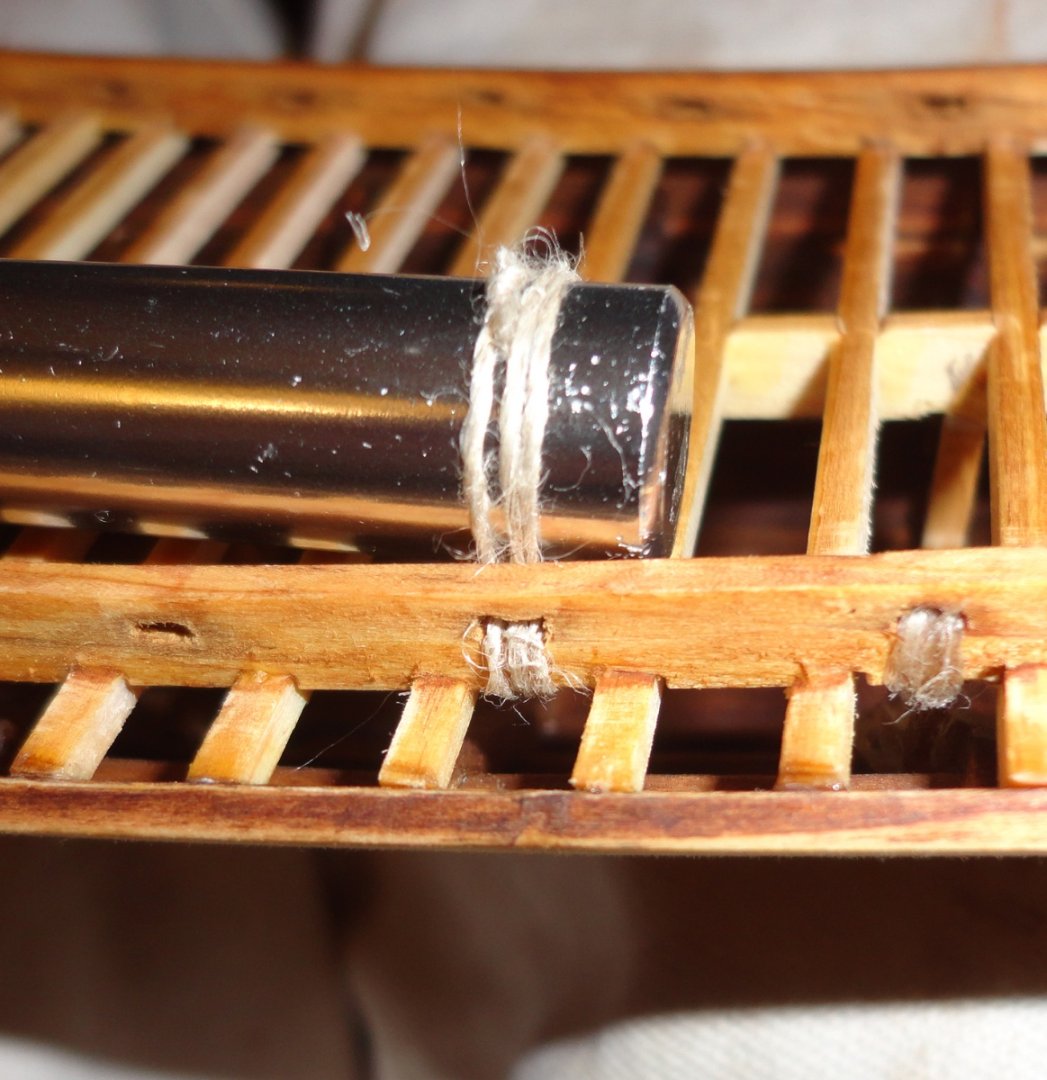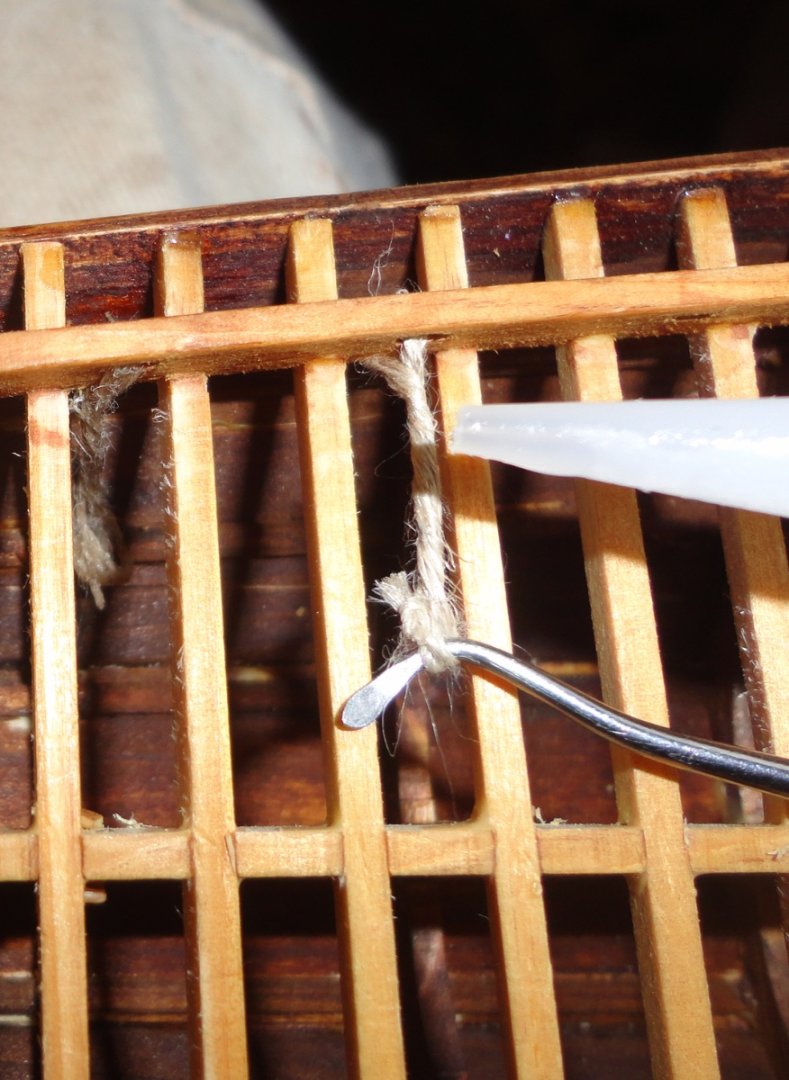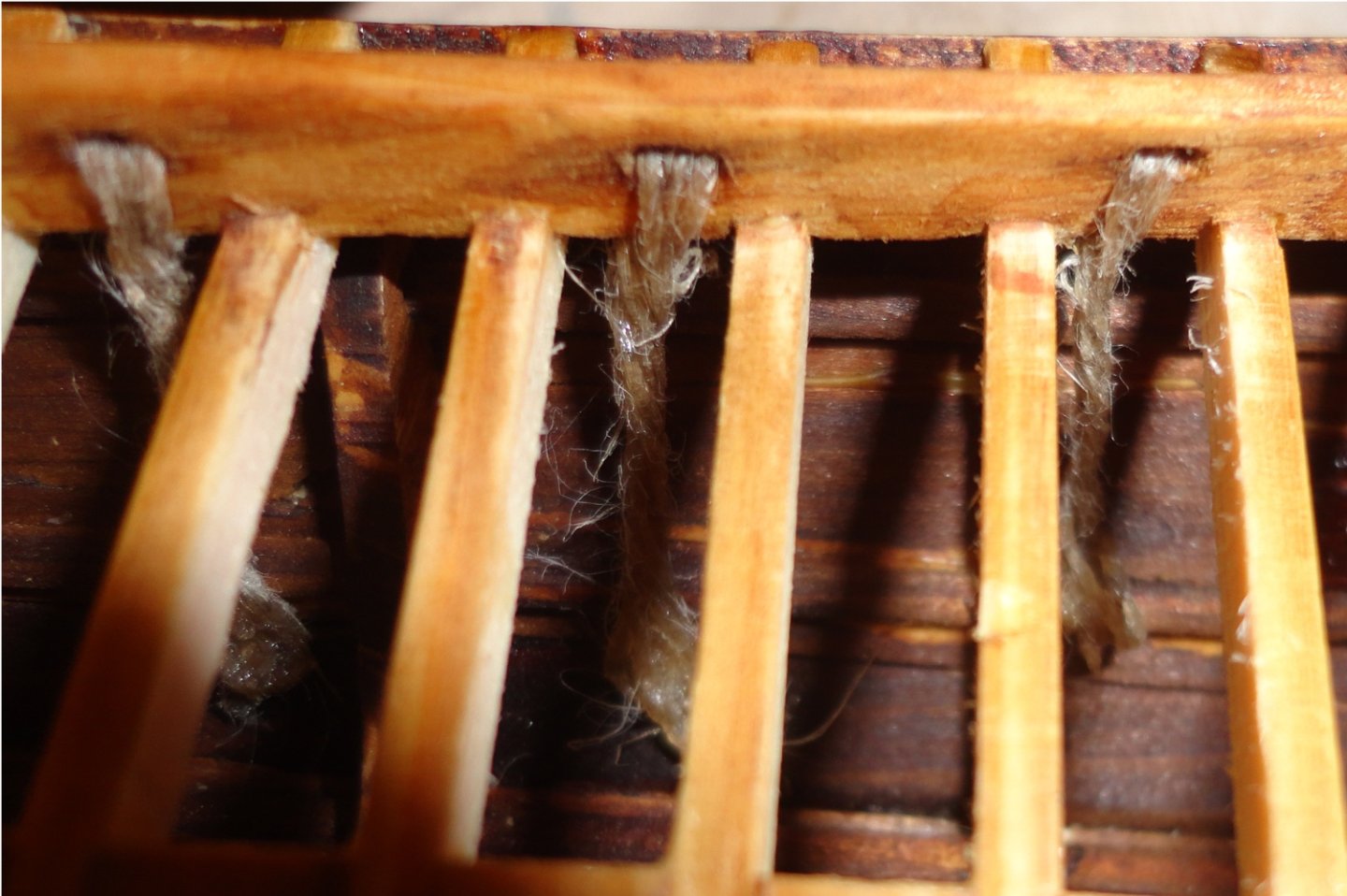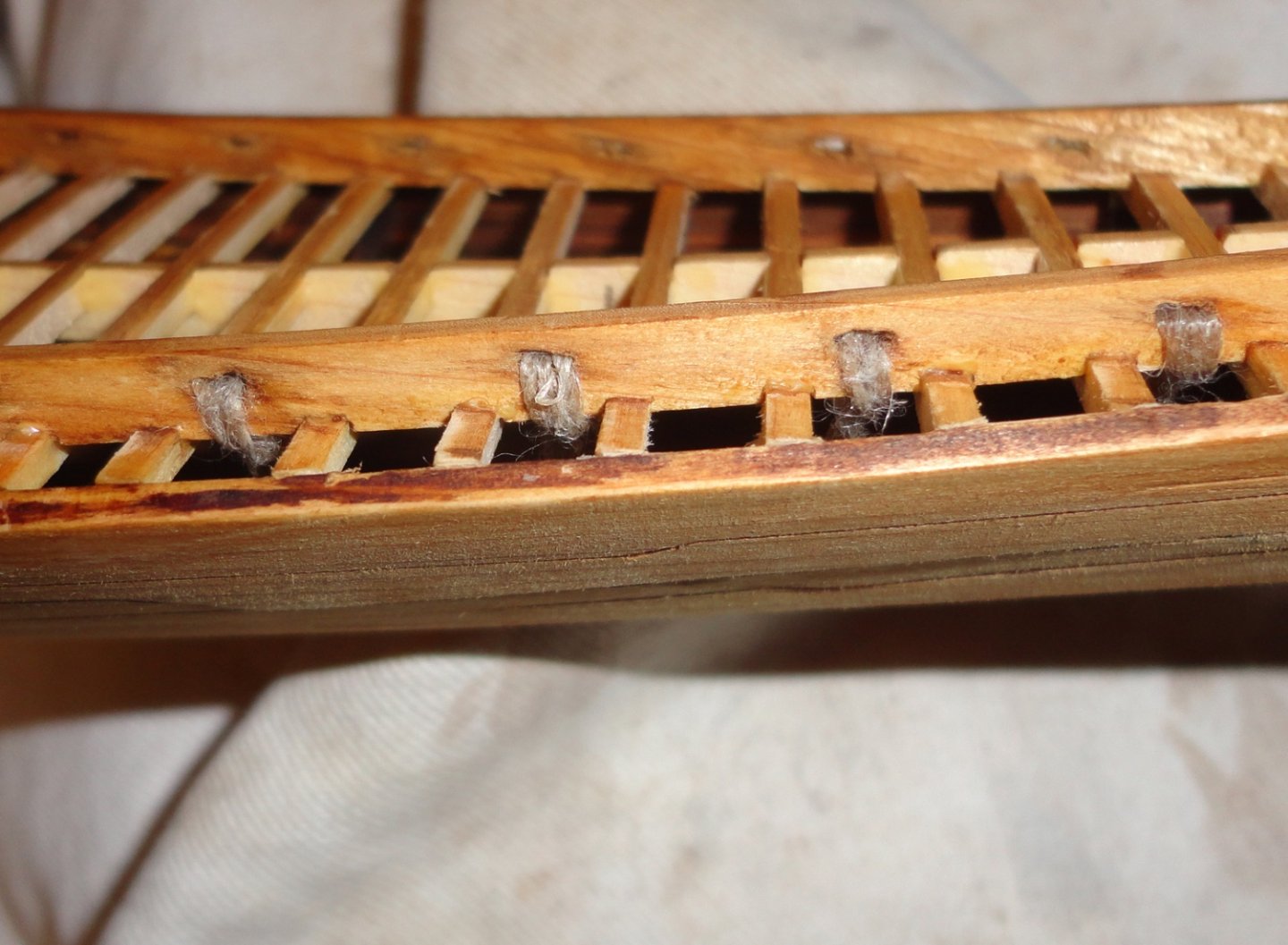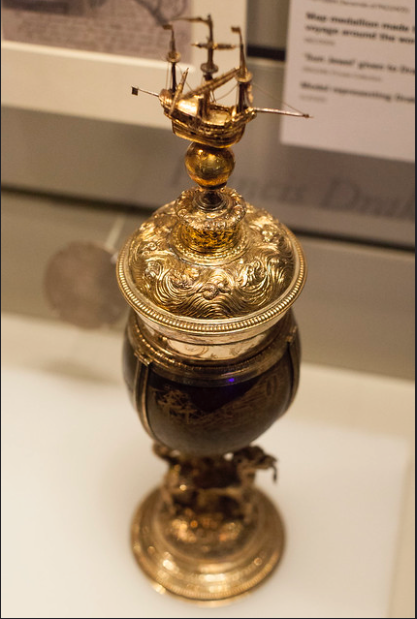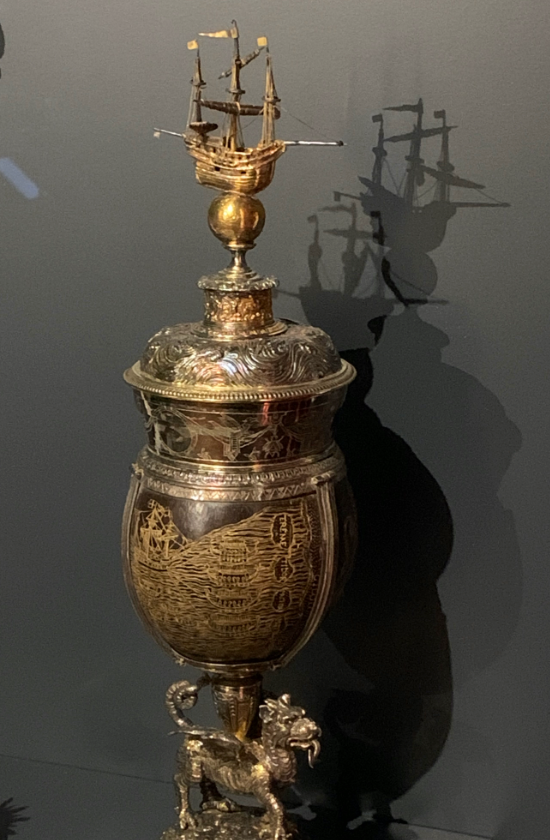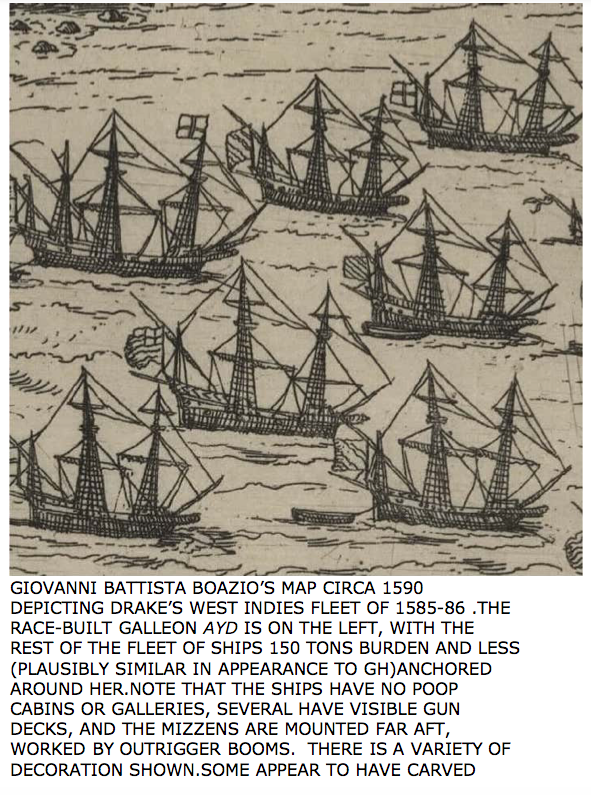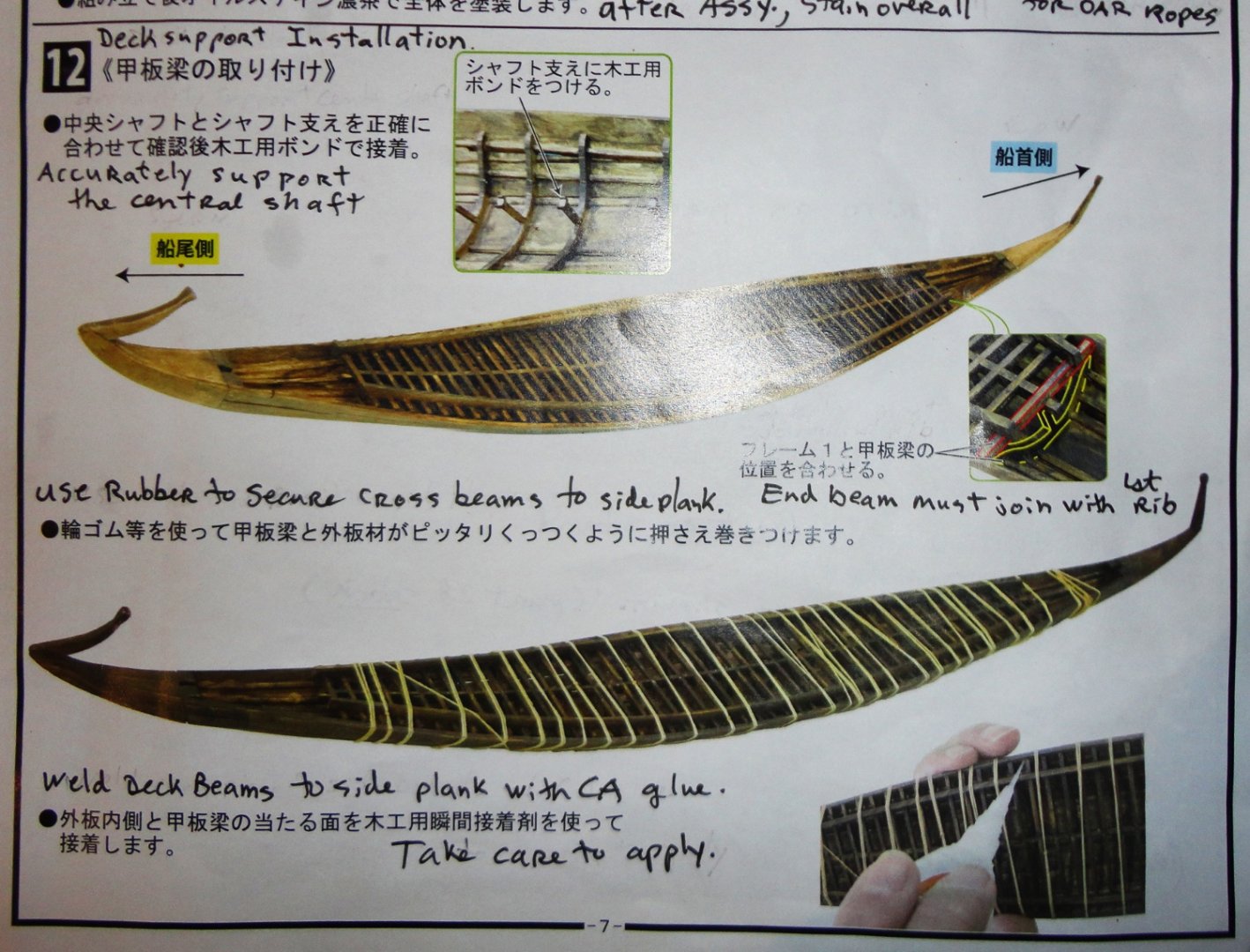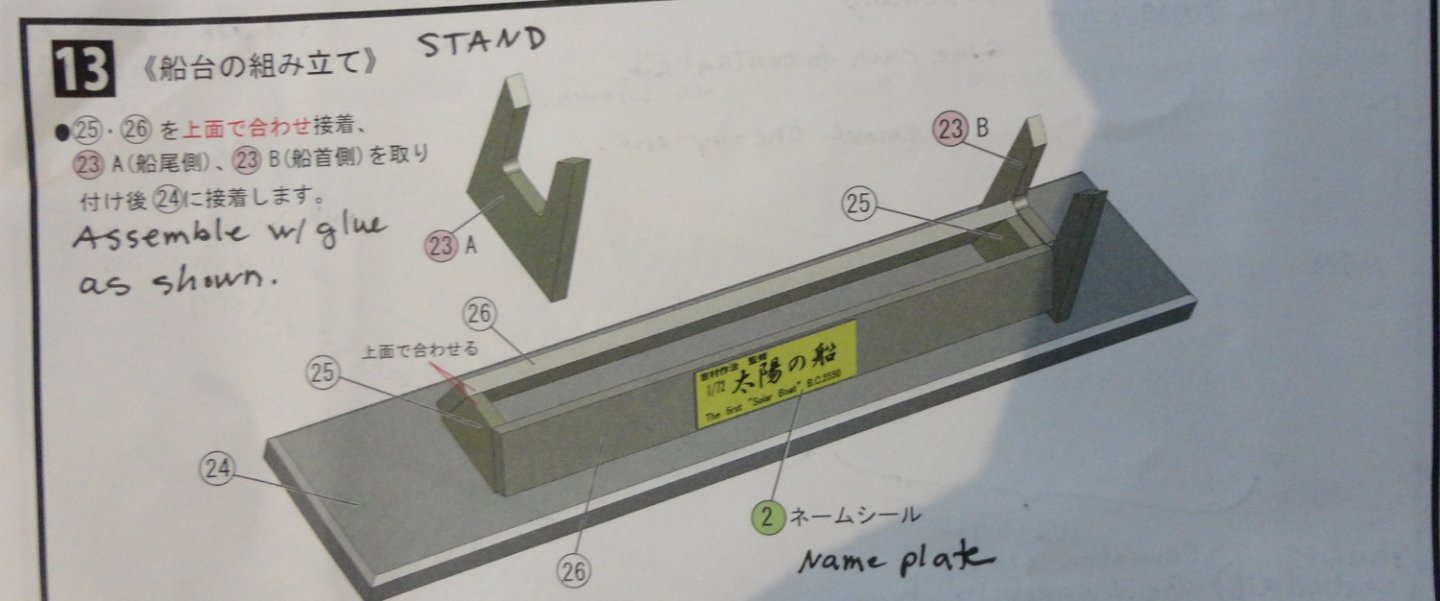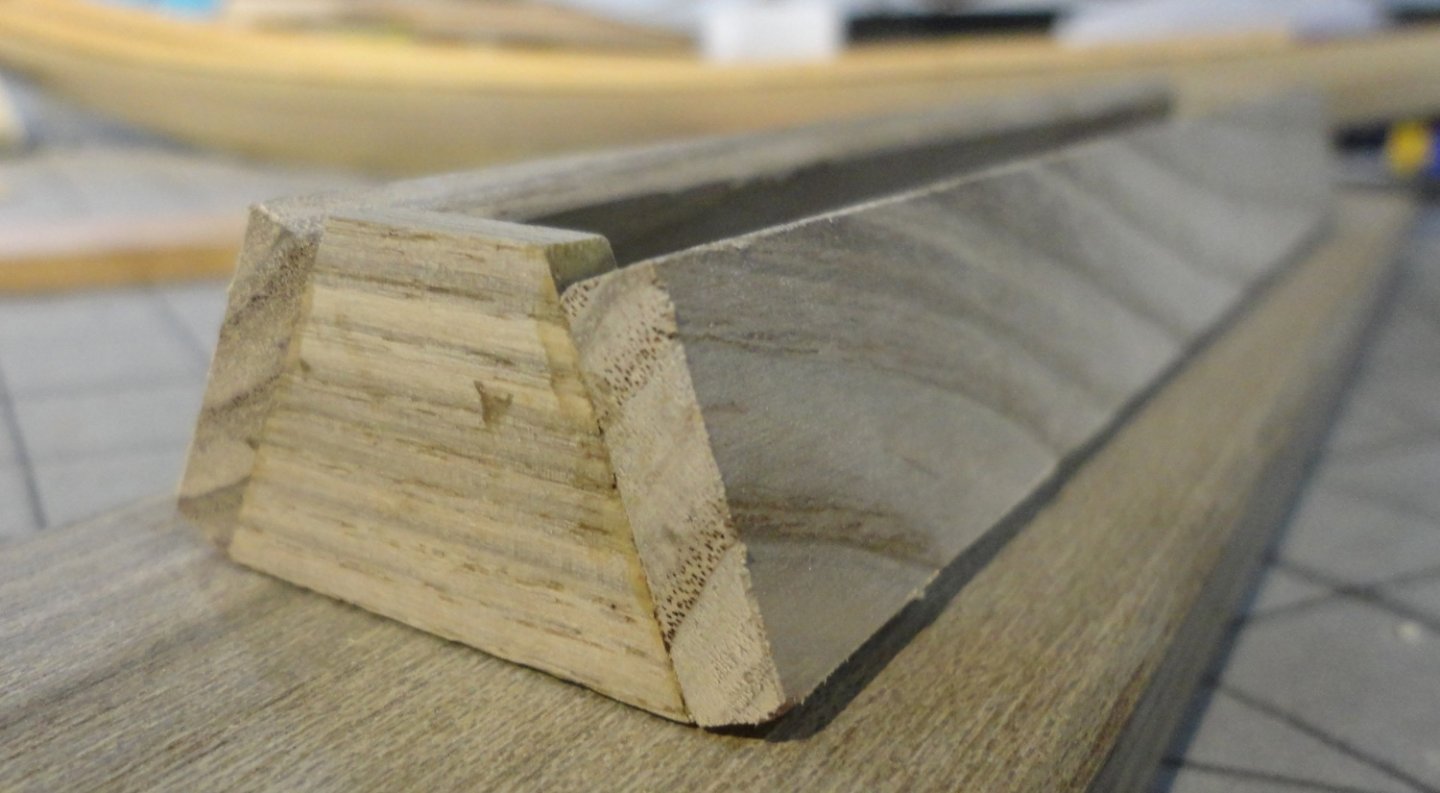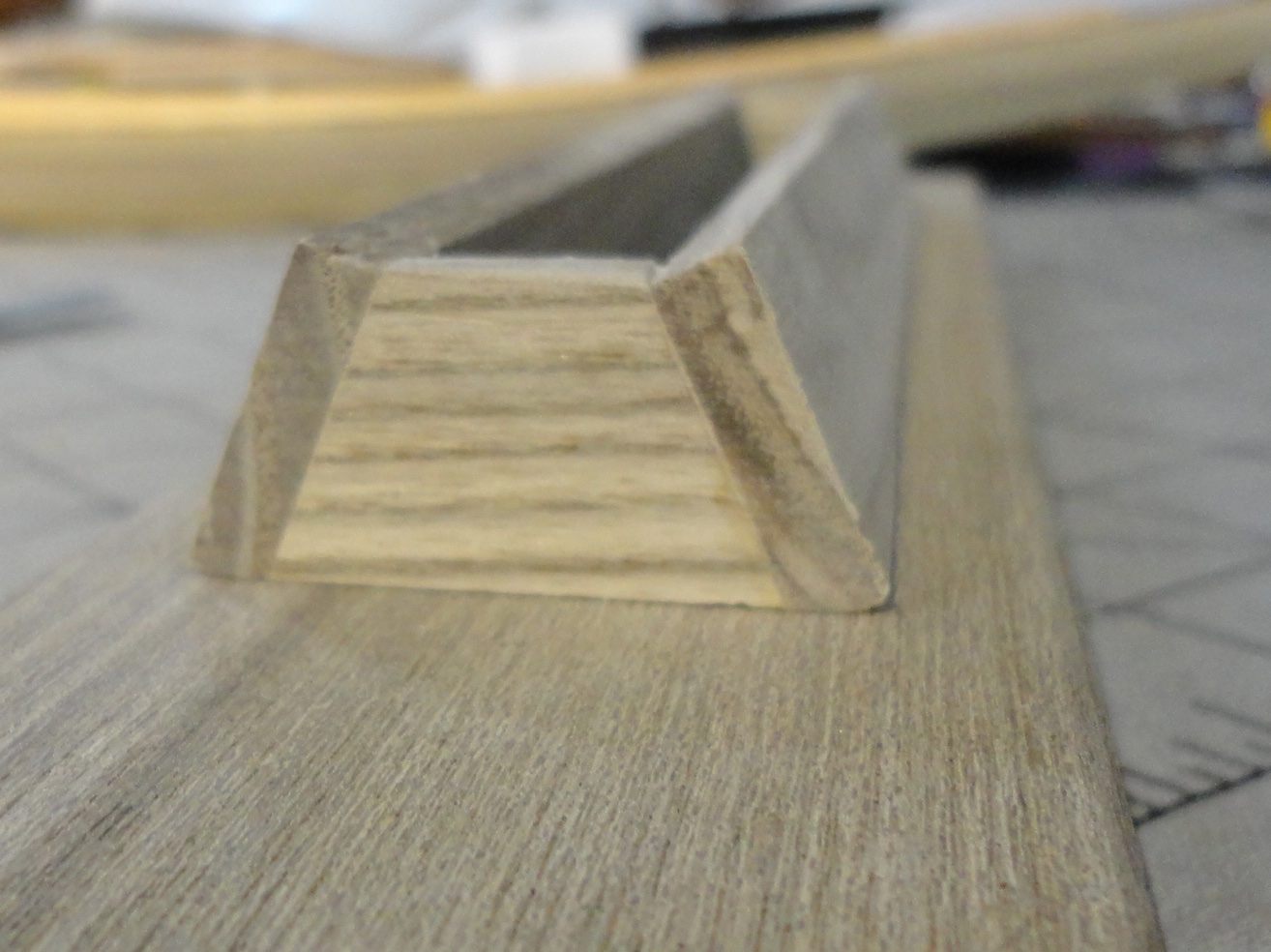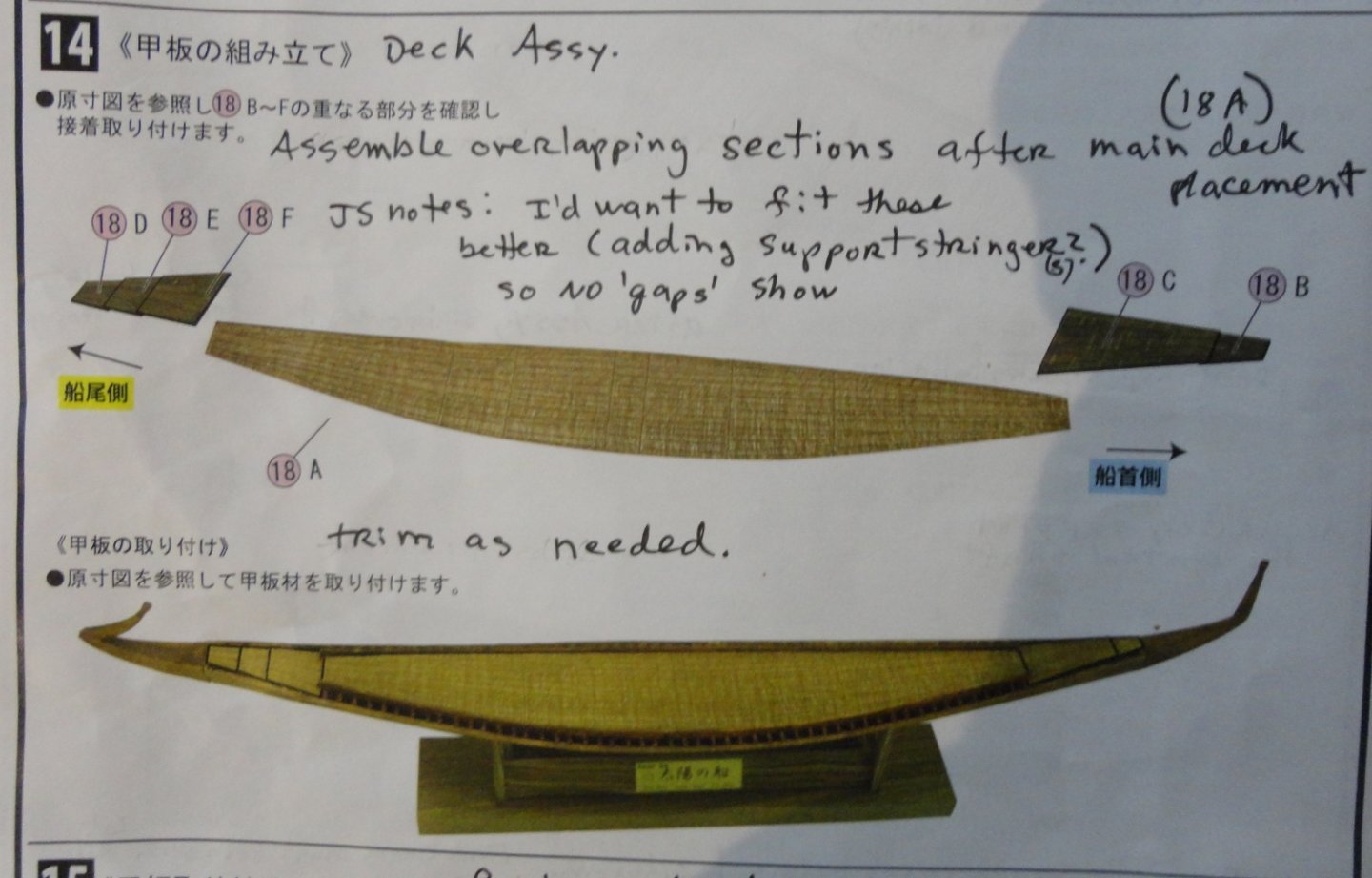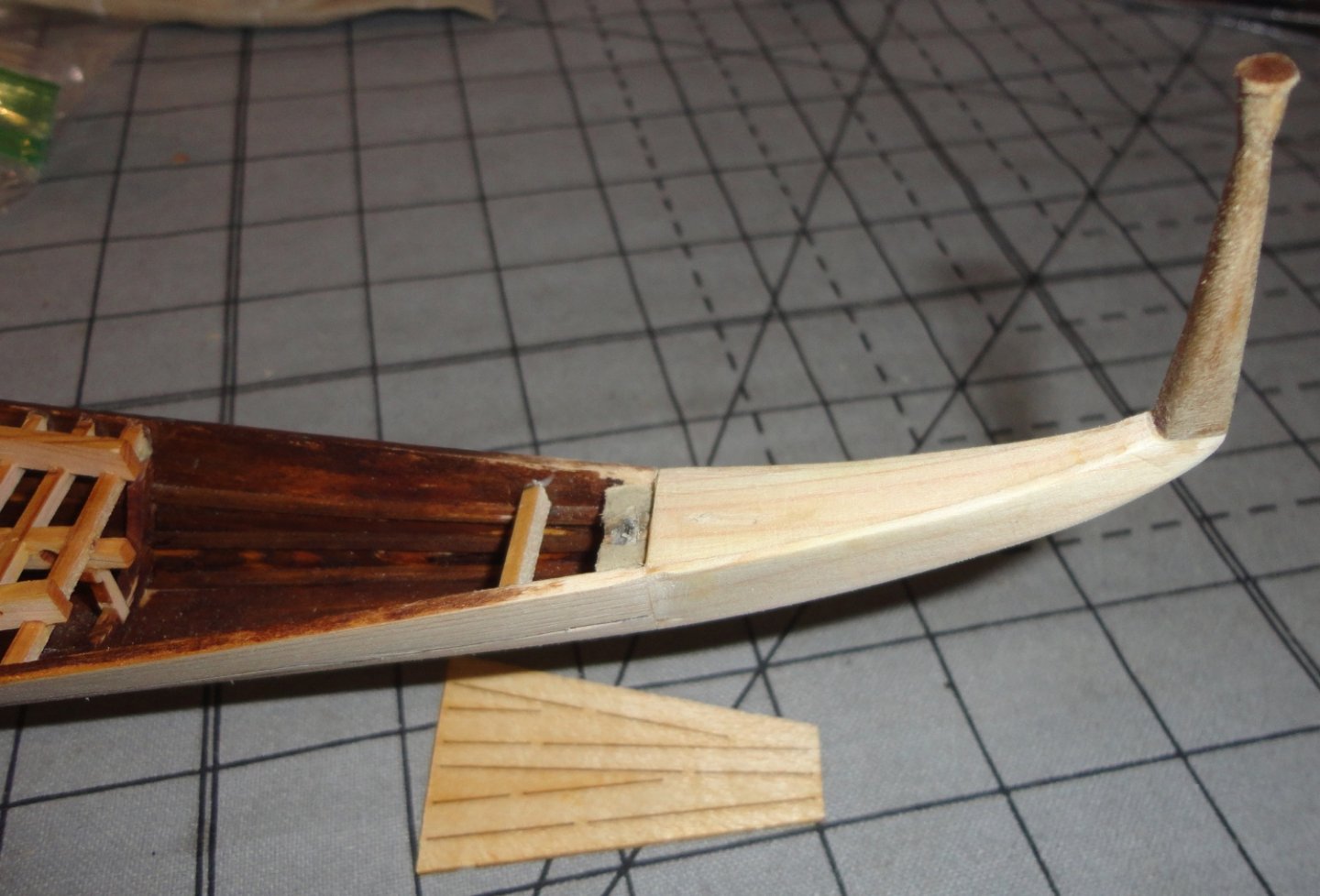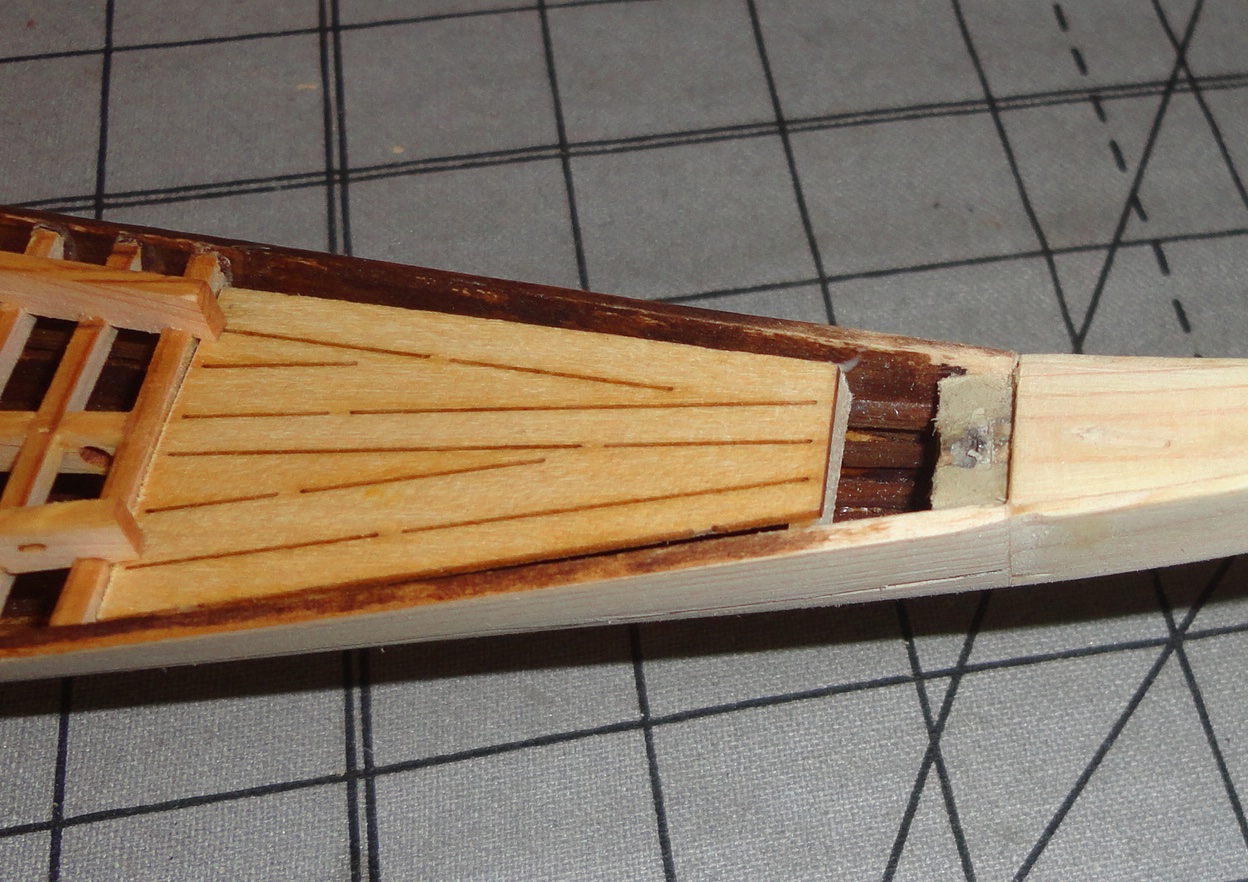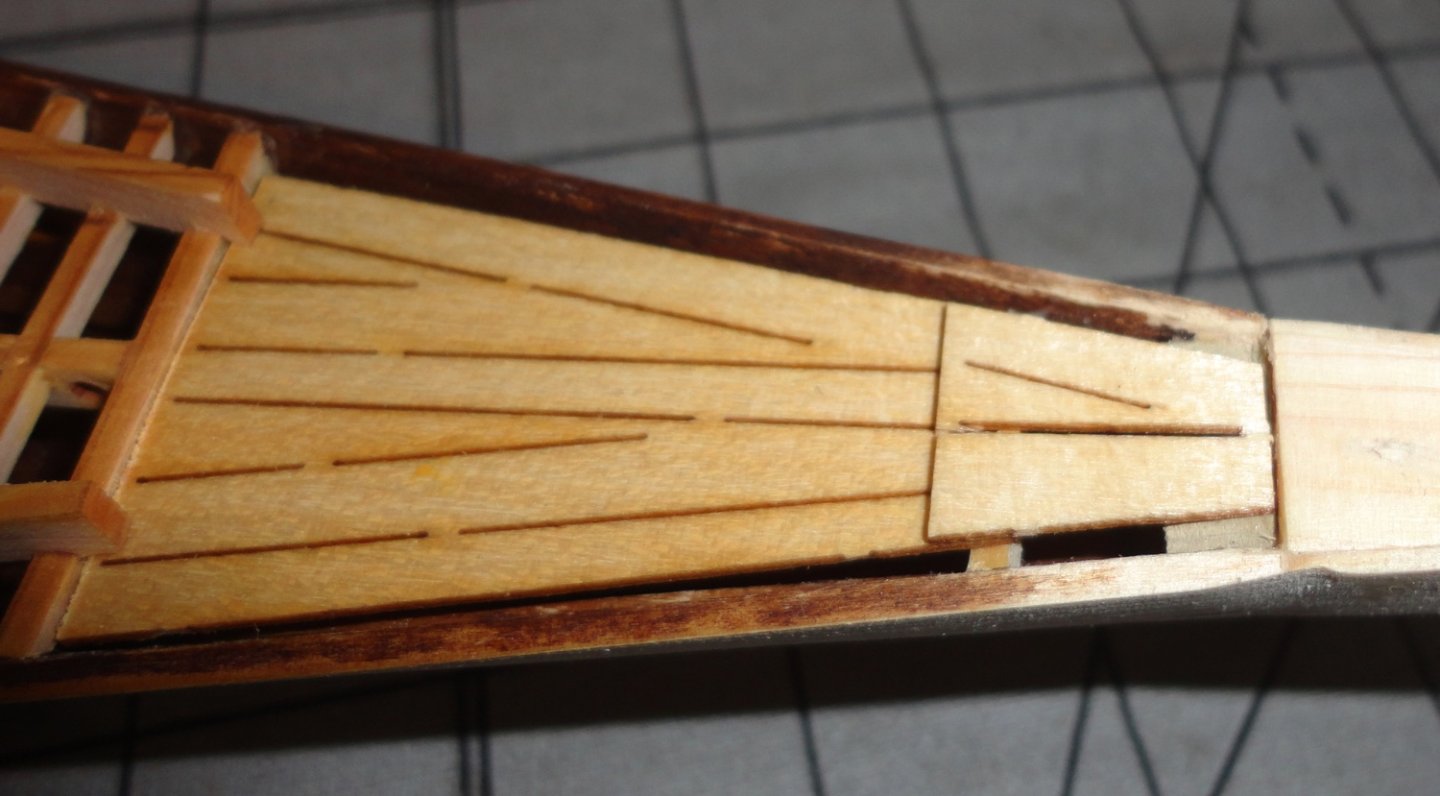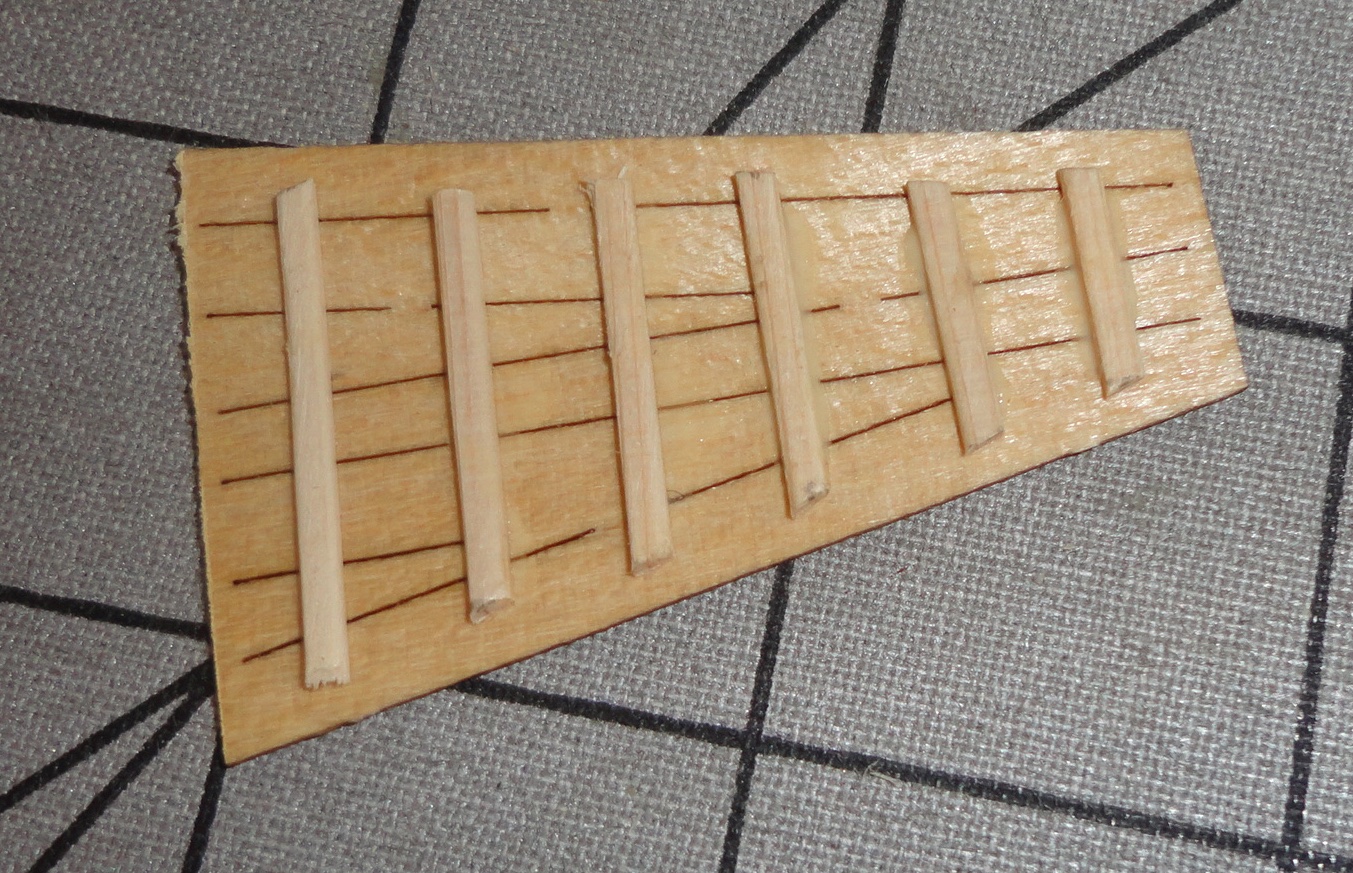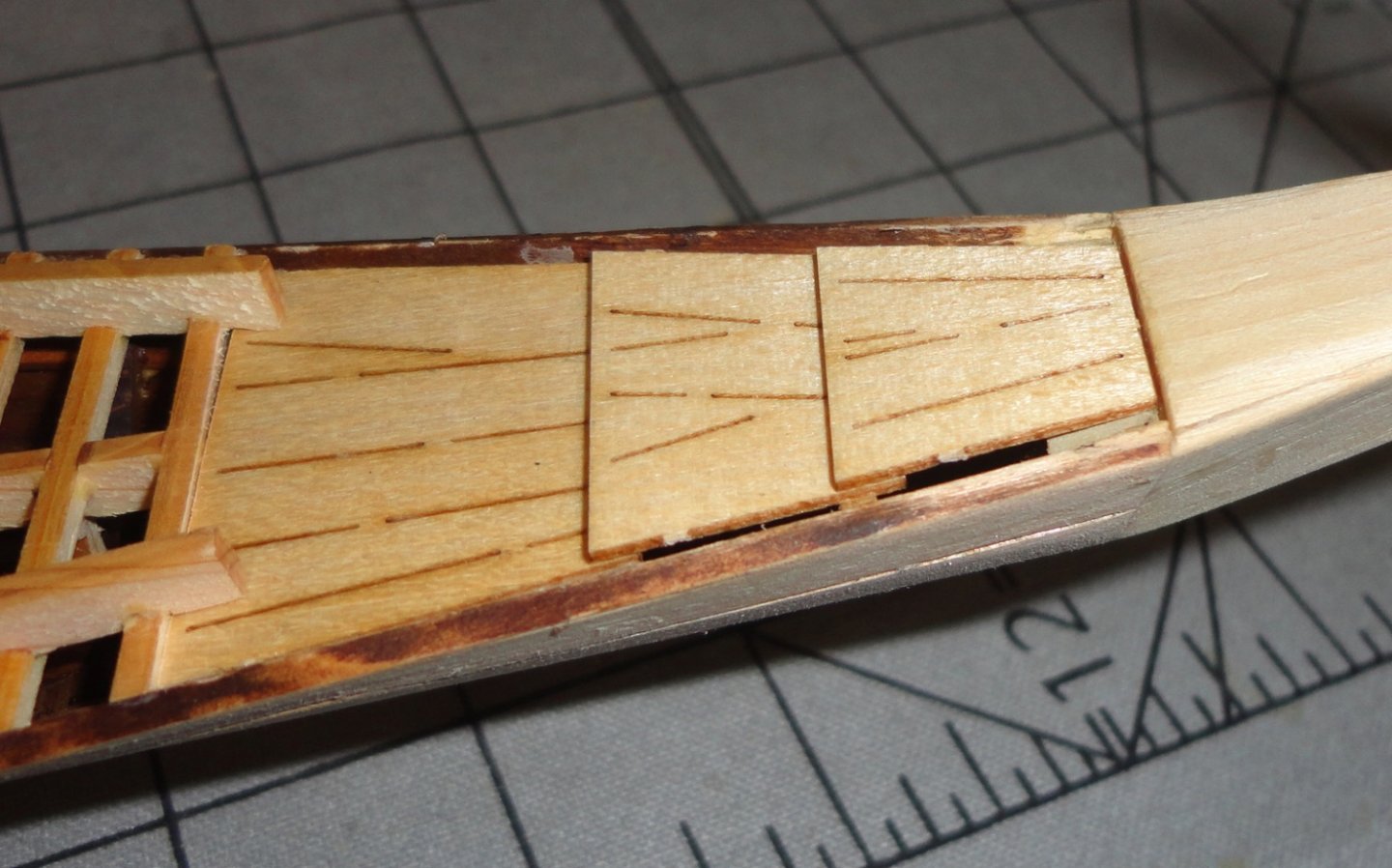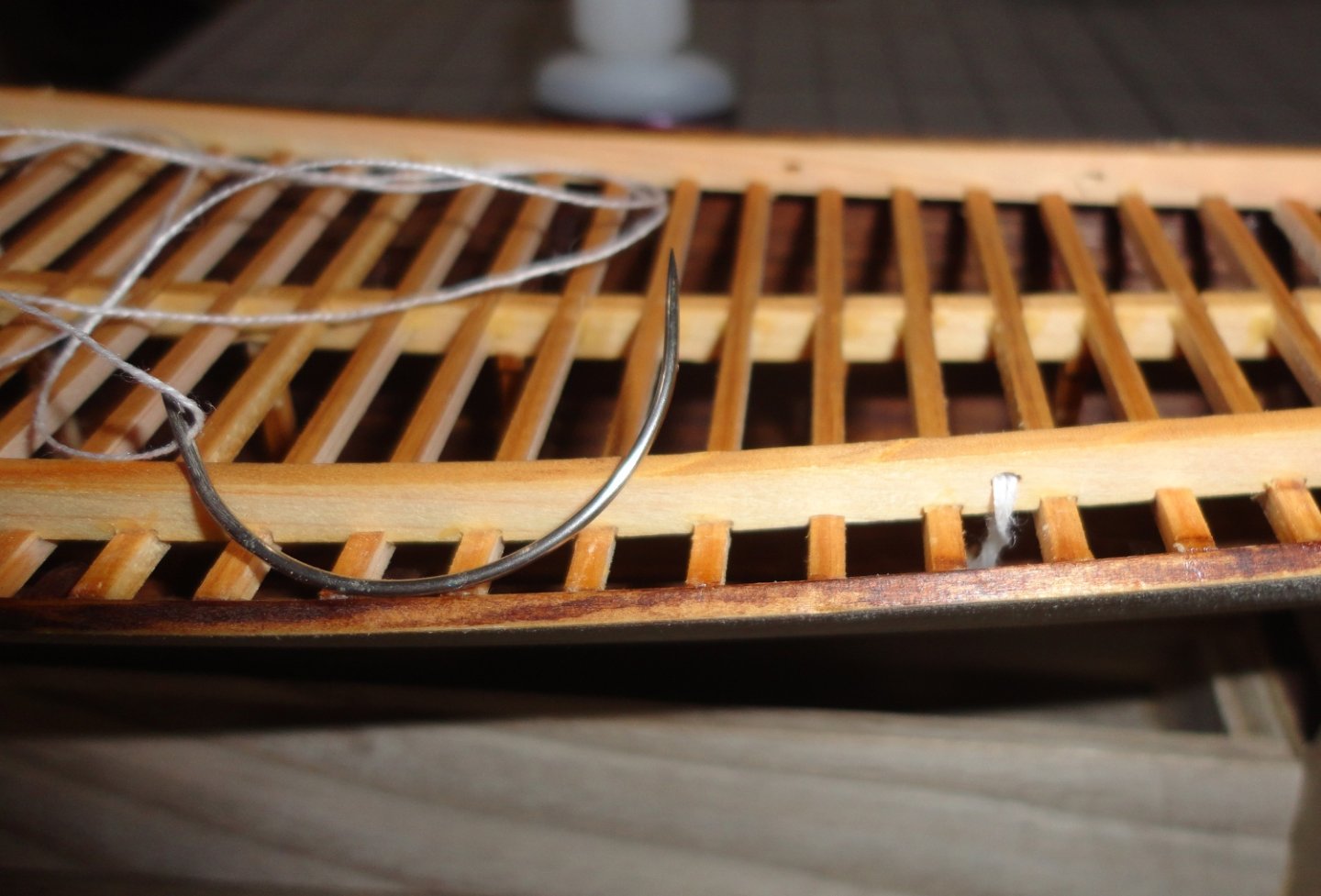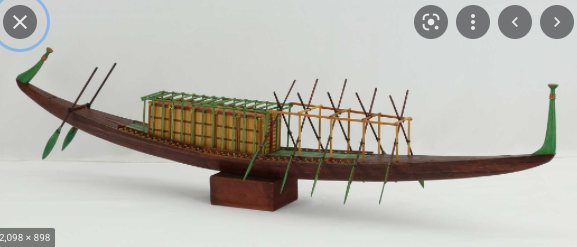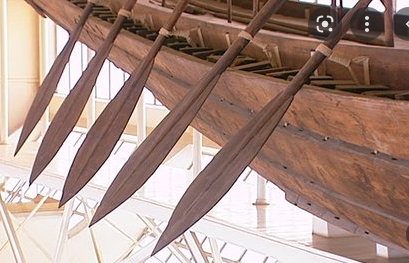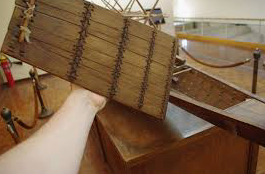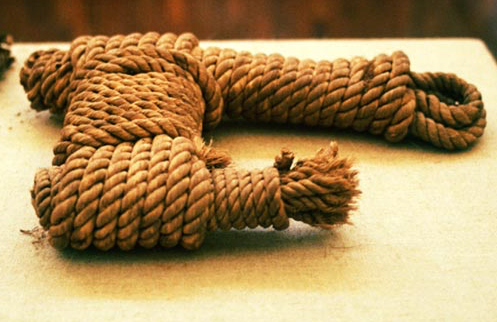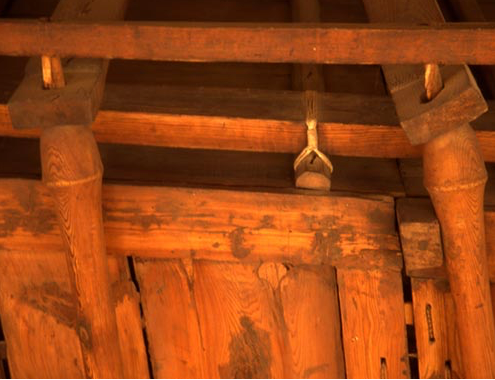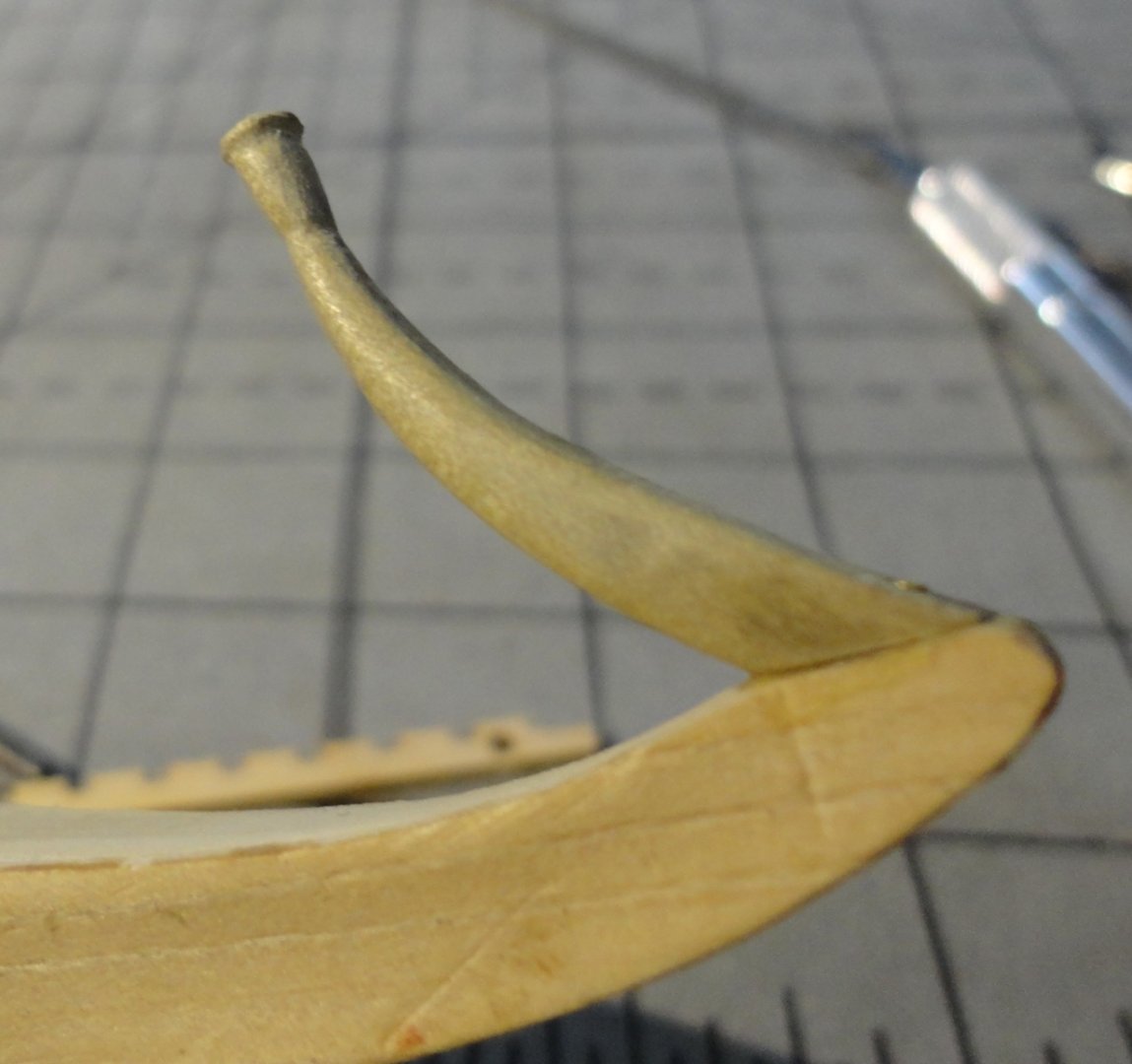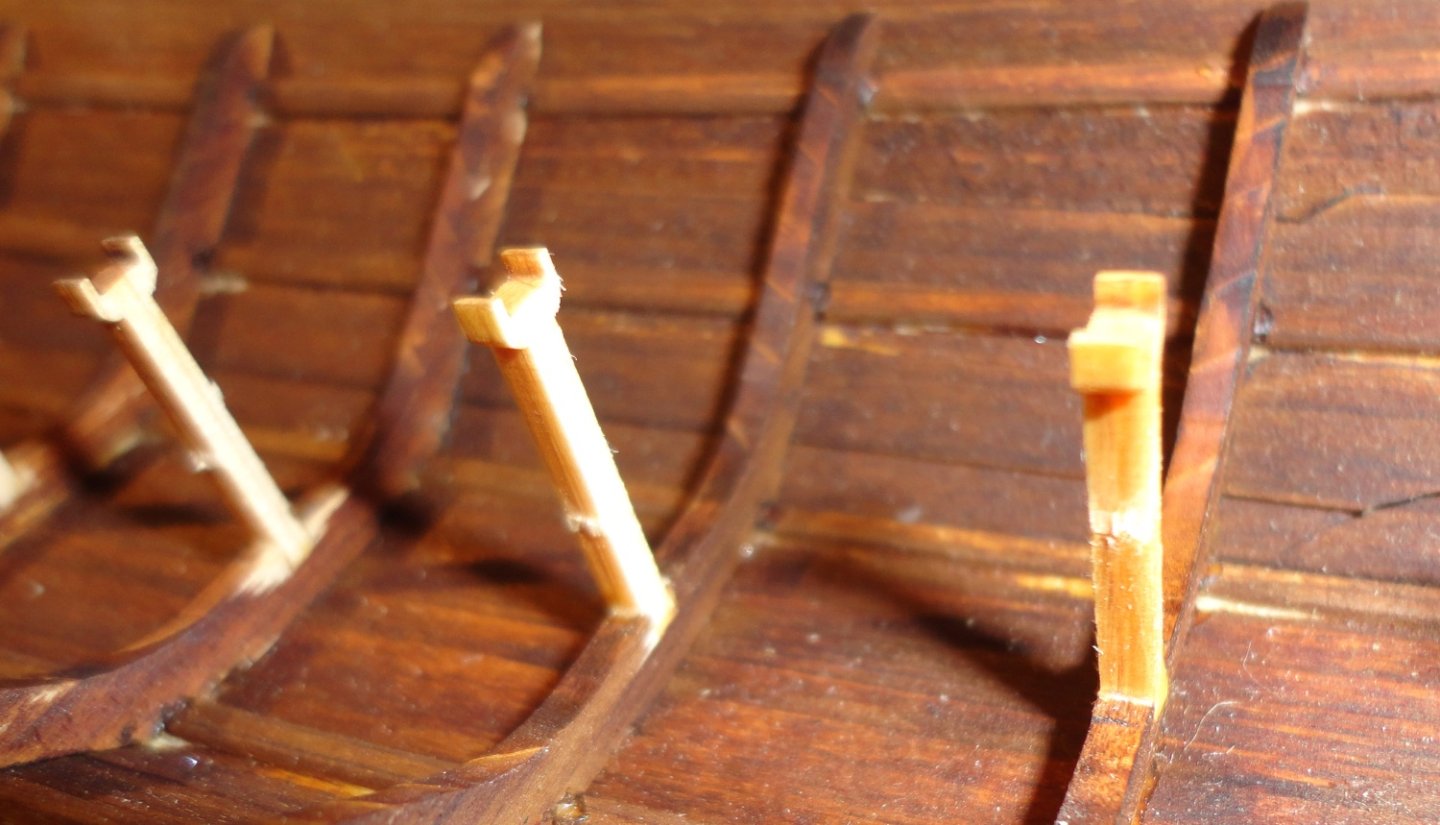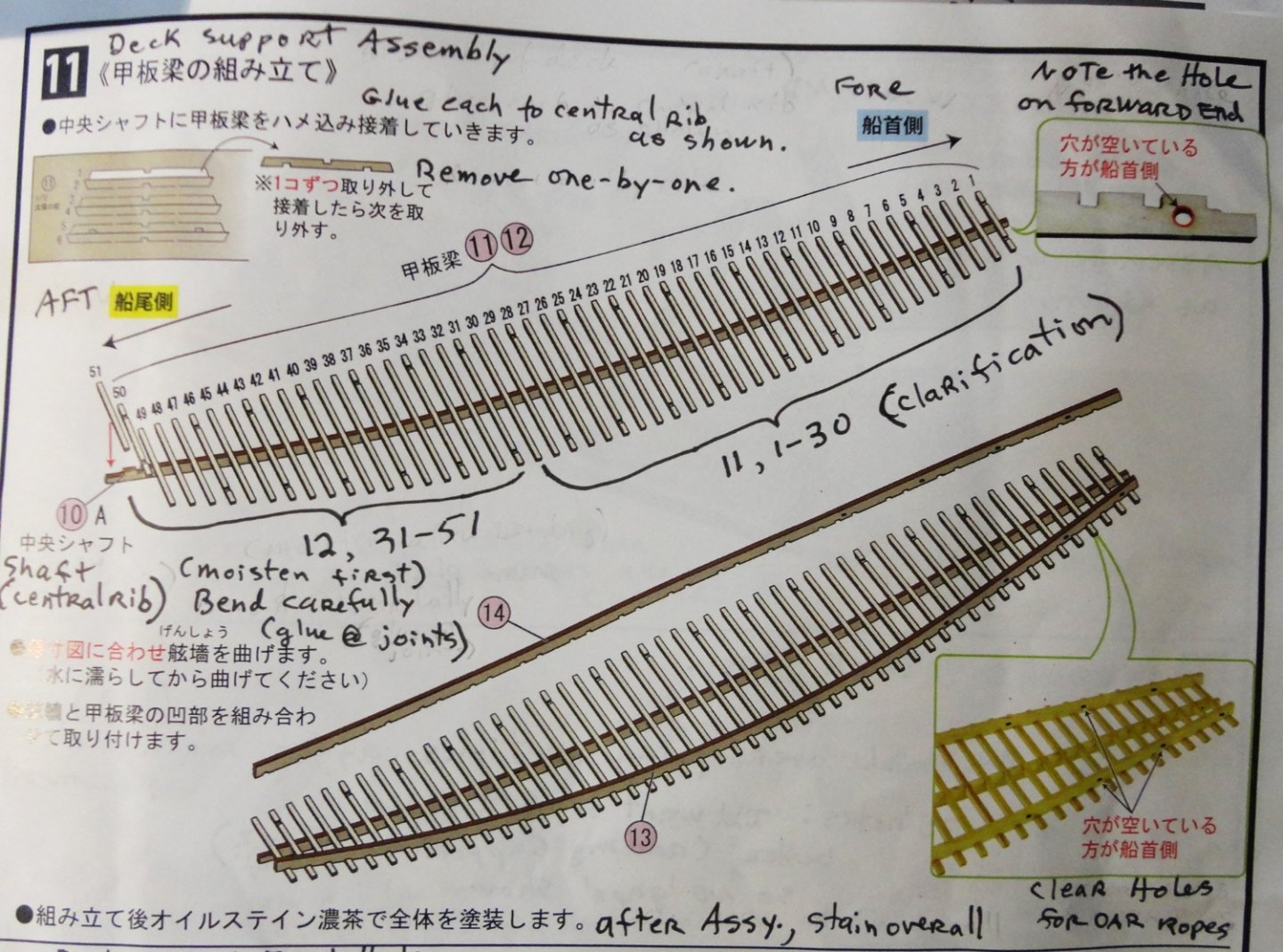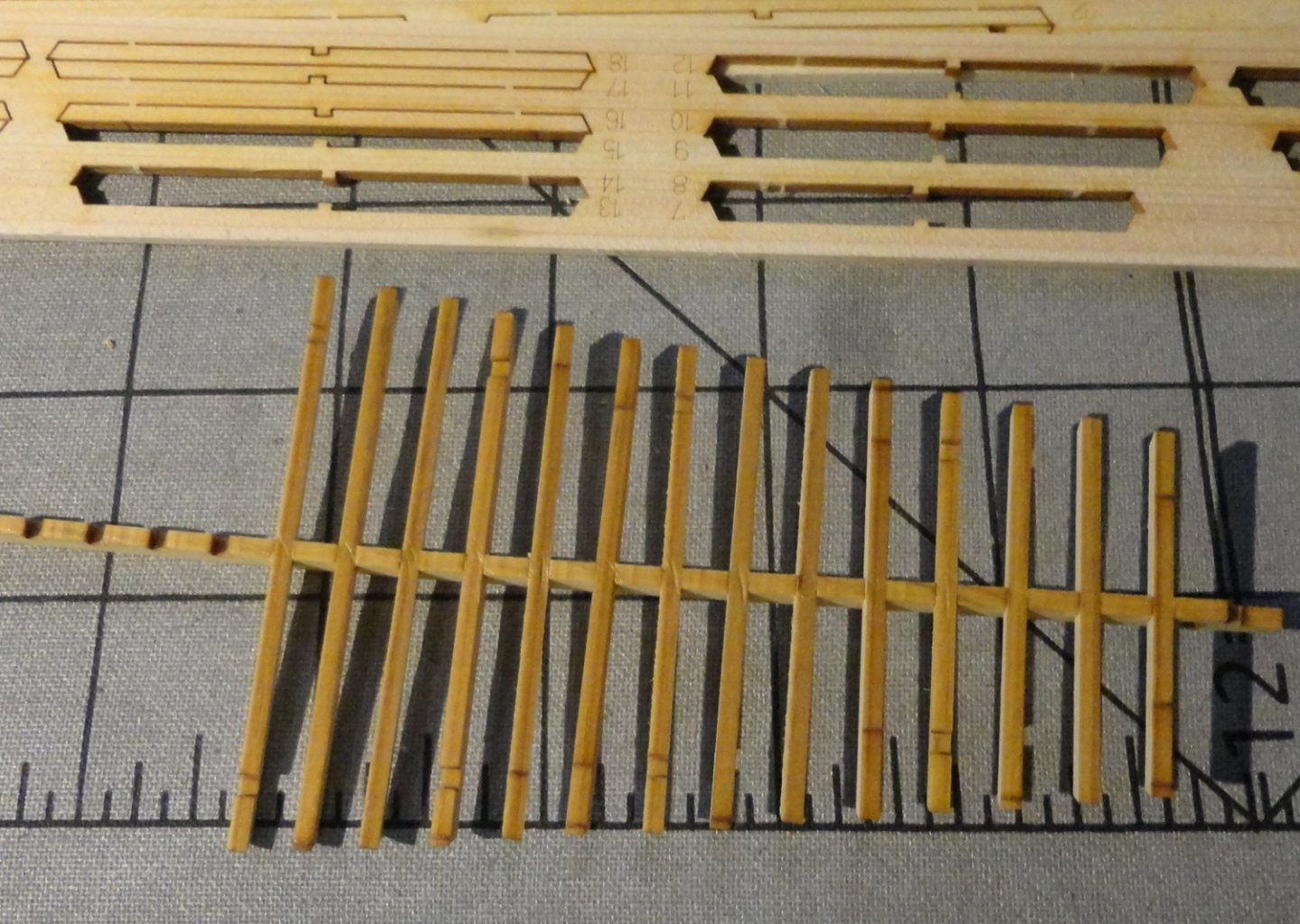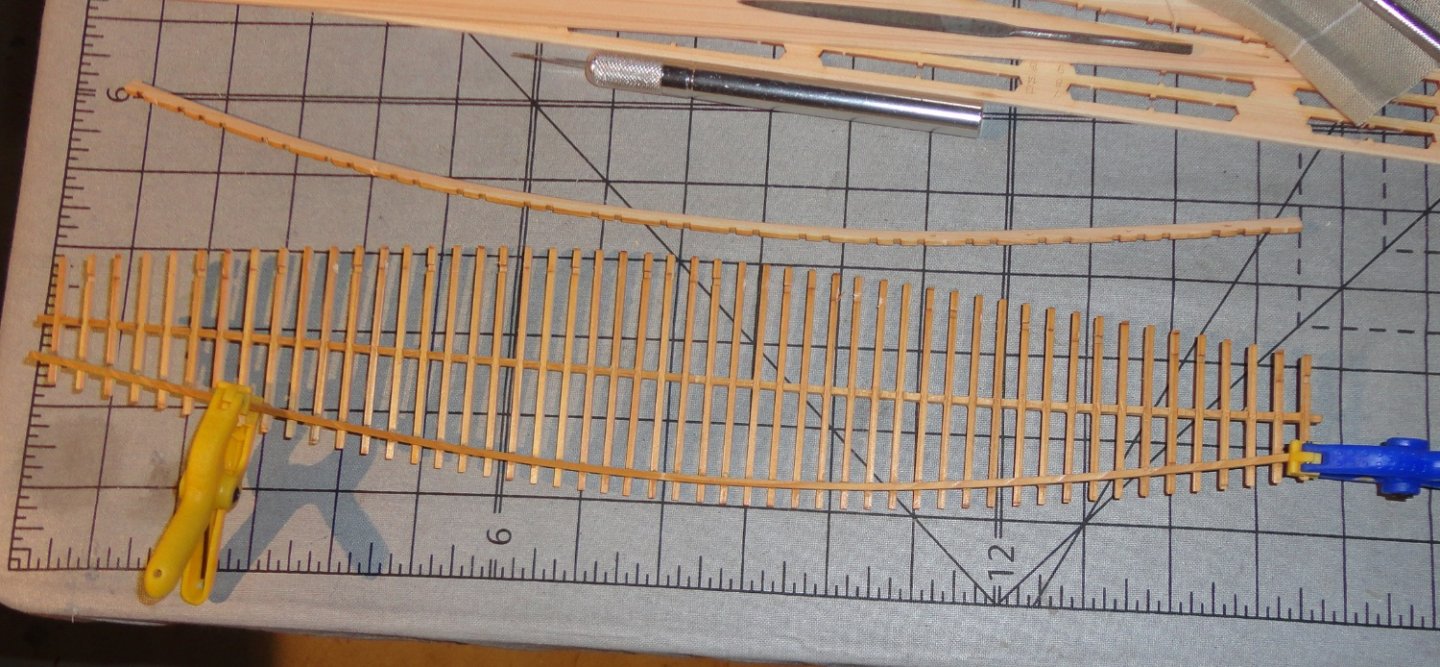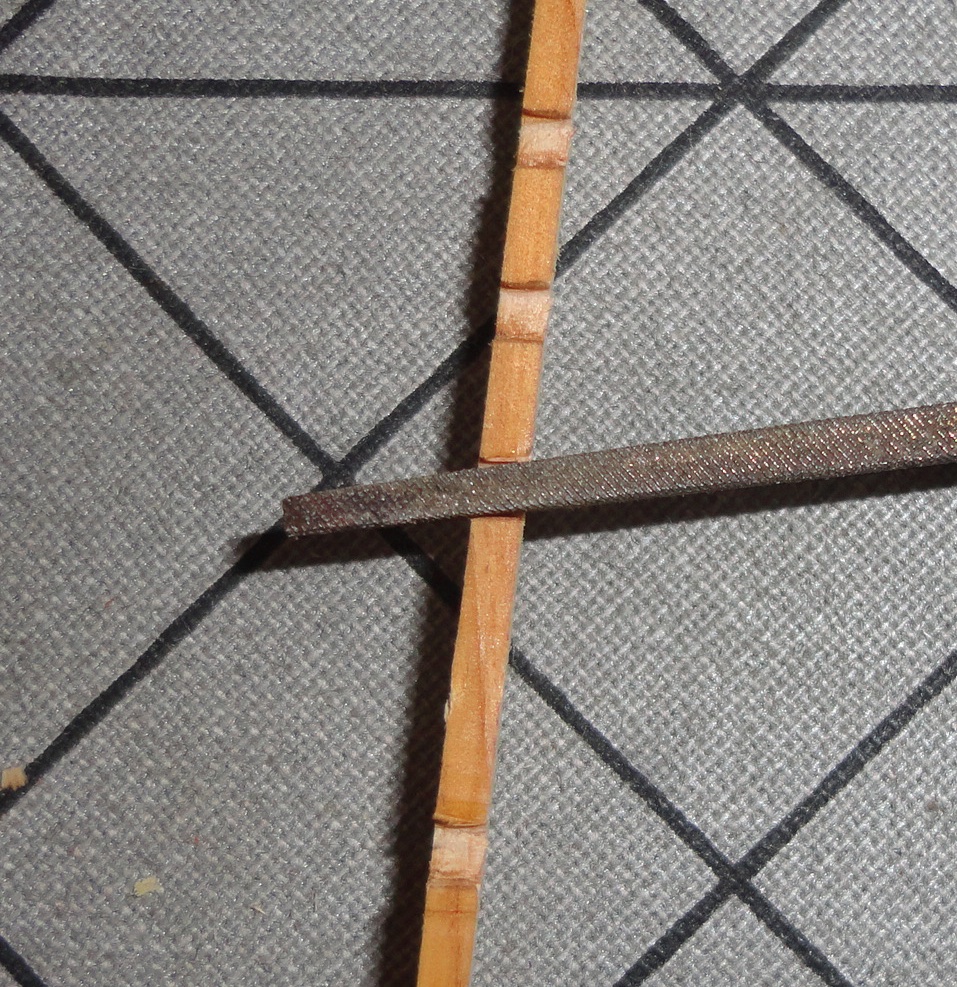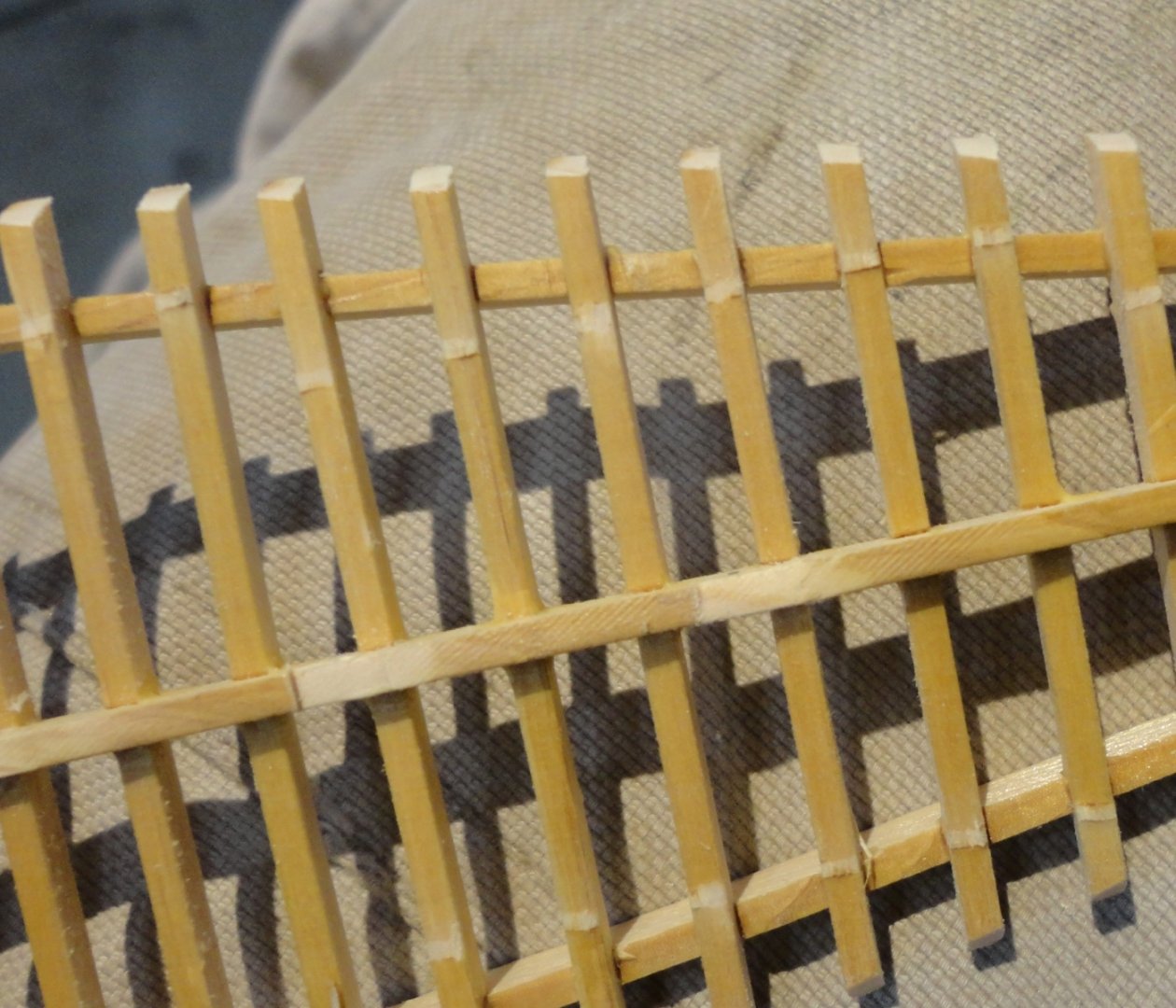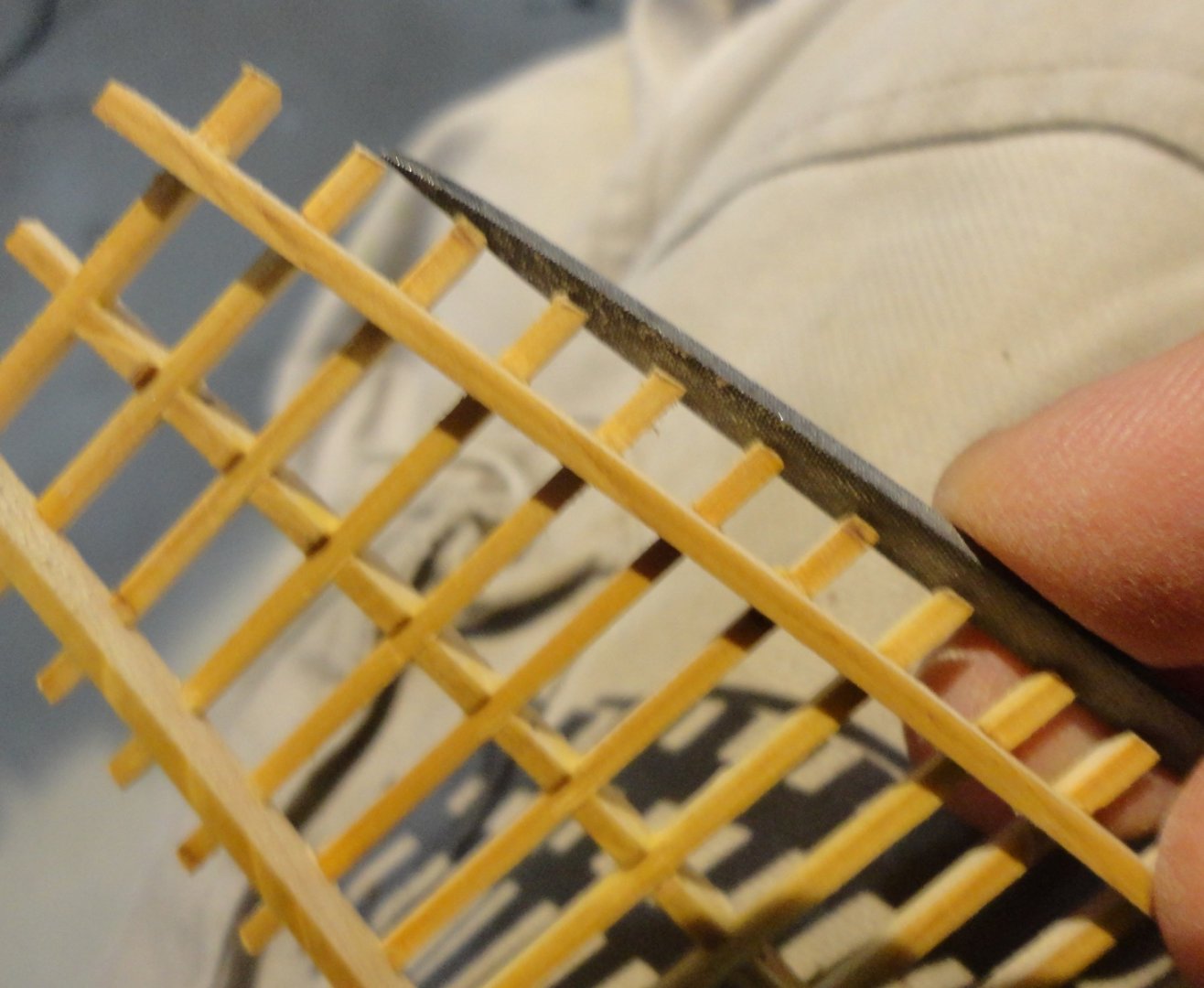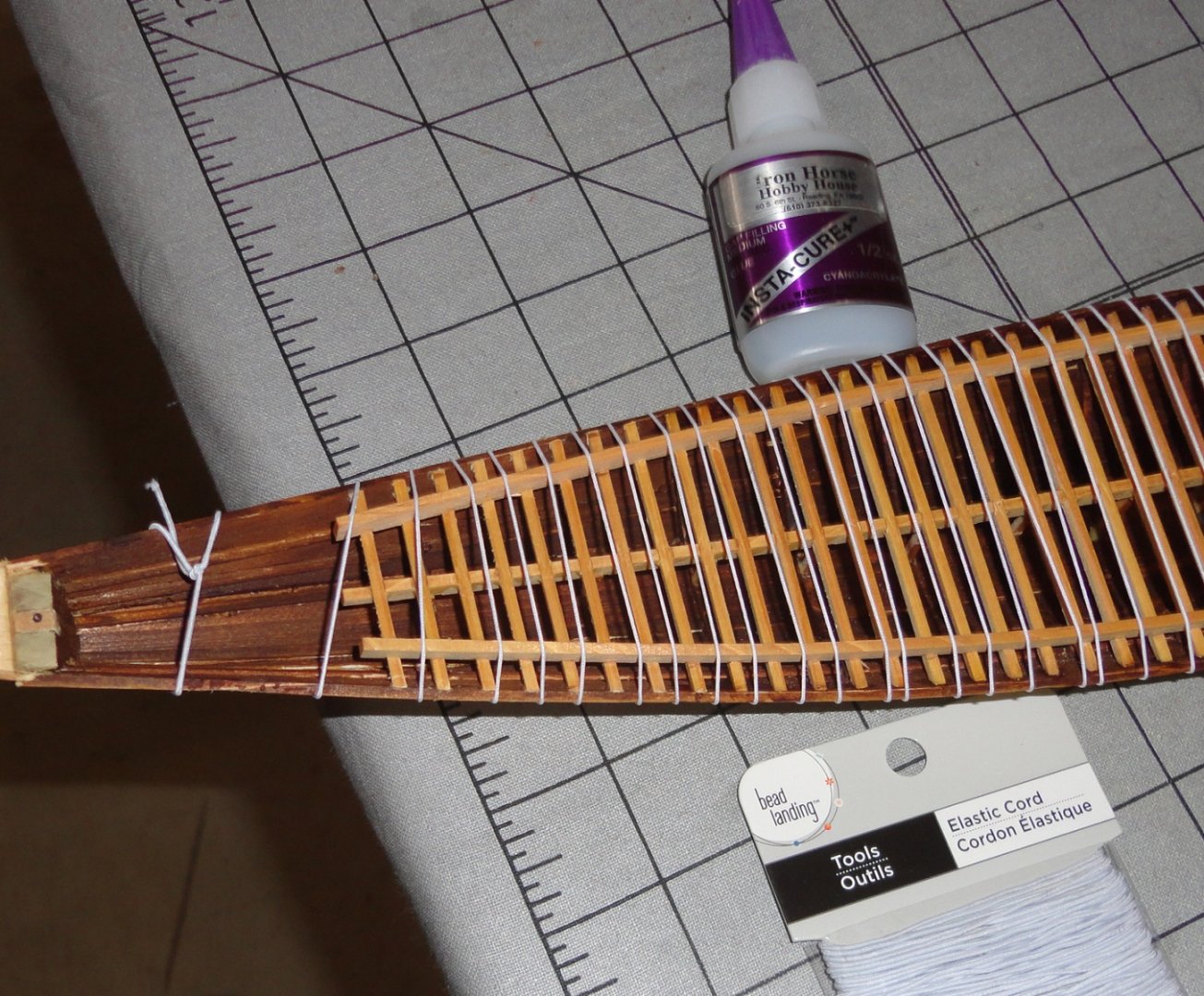-
Posts
1,453 -
Joined
-
Last visited
Content Type
Profiles
Forums
Gallery
Events
Everything posted by Snug Harbor Johnny
-
Hola! Welcome aboard, mate! You'll find many helpful builds in the forum, often showing several ways of completing something suitable for different skill levels. Many use Google translator, and it works pretty well ... I had to use my cell phone to manually translate Japanese characters in the Woody Joe instructions for the kit I'm building. Some languages are handled better than other by the translator, but Spanish should be OK. Fair sailing, Johnny.
-
How beautiful ! You got the lines perfectly.
- 63 replies
-
- Finished
- Khufus Solar Boat
-
(and 1 more)
Tagged with:
-
Now all the decking is done and toned, plus two places to mount stern rudder oars. The kit shows 4 cross ties, other models copy the museum exhibit and show one just behind the last access 'hatch' (movable piece of decking). I compromised with 2 so the access hatches are left free (seems logical) and will mount 2 pairs of steering oars - one pair for each cross tie. The next step per the instructions is to build the deck cabin. This has been ingeniously engineered by the kit designers. With close attention to the correct parts and orientation, it should go together without too much trouble. I plan to use differing shades of color so the various 'layers' of the deck structure will be easy to see. The cabin wall planks will be lightest, with medium brown for the battens, and a darker brown for the surrounding shade frame. Hmmmm, or maybe I should make the battens darker and the shade frame medium ... can't finally decide just yet. What delays construction on just about anything I do, is thinking about how to proceed. Hopefully (as with any forum build) any else who decides to do this kit will get the benefit of seeing a prior build, heeding caveats found in the build and getting ideas of how to do it differently - perhaps better. A friend showed me a few models she inherited from her Dad's estate, which I found to be good intermediate kit builds. On one, a fife rail had popped loose ... a recurring problem at times when things glued to a deck can be subject to rigging stress (whether when rigged or later with atmospherically induces shrinkage). Gluing end grain makes for a weak join ... something that made it easier for me to fix the angle of the lotus as previously posted. But this is an exception to the rule. Some kits have 'sub decks' which the builder planks-over separate from the hull before gluing the whole thing in place. This presents a great opportunity to pre-mount deck eyes with the end of the wire going right through all the decking material to be bent-over underneath and fixed with a blob of epoxy for good measure. Drilling holes in such a deck and squaring with a file to match the dimensions of the fife rail leg (or other thing to be attached) will provide a socket to accept the wood (the legs have to be longer by the amount they will go into the deck). I might be inclined to mount things at that time so the legs can go right through and be pinned on the underside ... no way they'd come loose. Now if the above is not an option, a hole might be drilled from above. If not able to be 'squared' from above, then the piece to fit in might be whittled round on the end. Pin rails present their own challenges. All food for thought.
- 63 replies
-
- Finished
- Khufus Solar Boat
-
(and 1 more)
Tagged with:
-
Steven, I totally get the pain of repairing things that come loose. 'Seems fixing problems (as well as mistakes) is something inherent in most craft/hobby endeavors. Many times I've wished better foresight in predicting future difficulties - "If only I did it this other way ..." Since there are future projects queued-up in my head (and kits are on the shelf), I'll try to figure ways to make fife rails, deck eyes and pin rails (etc.) as secure as possible. Your work on this build is amazing ... if only your 'younger self' could see what you're doing now. Johnny
- 740 replies
-
- Tudor
- restoration
-
(and 4 more)
Tagged with:
-
Once past the optional step of installing 50 rope tie-downs, the main deck was easily bent ... Rather than go upstairs to get some water, I ended up just licking the underside then using both hands to flex the piece some. Since the rope form the tie-downs takes a little space inside the deck rails, more shavings were made on the sides of the deck to allow for this - and it was trial fitted several times before bending. The shape of the deck is not symmetrical fore-and-aft (but close) - so I should have marked on the underside of the deck "bow" and "stern", since I was careful enough to mark other parts earlier in the build. Everything looks similar and one can't be too careful since a mixup can occur. Note that the planks are laser cut into many boards with different shapes that correspond to the actual planks used on the original. Builders didn't want to waste good planking wood and made use of irregular shapes. ( ... 'Calls to mind Inca masonry that incorporates all sorts of irregular blocks cleverly dressed to fit together well.) There are small attachment points that are not cut by the laser ... obviously so the whole thing does not fall apart. I suppose someone OCD enough (not me) might try separating all the pieces and gluing them individually. I have used the plastic clamps shown below in a number pf applications, since they have swiveling jaws that adapt to odd angles sometimes encountered on workpieces. Other clamping aids have included clothespins (large and miniature), lengths of elastic, rubber bands, painters' tape and sometimes 'finger clamps' . I often sport one or more bandaids due to 'boos'. "No, no - Not the boo box!" ... from the movie Hook. OK, mates ... what is wrong with the picture below? The bow is to the right. (Hint, note the slight gapping on the left between the deck and the side rails on what had been a carefully pre-fitted component.) That's right, class - I flipped the deck when gluing ! I didn't take my own advice and mark the underside "bow" and "stern" respectively. Now that the glue is dry, it would be madness to try and tear it out - something not possible without damaging everything. Not to worry, only an expert on the subject vessel who was closely scrutinizing the model would perceive that the unique deck planking is reversed ... and even then might miss it. When applying glue to the deck beams and along the edges go the underside of the deck, it somehow got dis-oriented. No wonder I had trouble fitting it in place (Duh, another clue to look out for - if something is not fitting right, check it out.) The bow taper is slightly narrower than toward the stern, so the fit was snug enough to require some forcing with a smooth tool. BTW, the picture was taken after I grooved over the connection points in the laser cut deck, and filled in the grooves with a little graphite using a mechanical pencil. The look is good, however - and I'm going to stay with it. Below is a closer shot of the deck after tooling to make the planking have the proper appearance. Ok, now I discovered another goof that I decided had to be fixed. The "assumption" (ooh, there's that word - 'assume') was that the kit was engineered with uniform precision, but that turned out not to be the case with the bow projection assembly done earlier. I knew that the cheek pieces were too thin, so sanded the hull planks near the join to compensate after gluing. BUT, the angle of the bow hull bulkhead 'as-assembled' needed adjustment. It would have been a good idea to check it against the full-sized drawing BEFORE gluing the bow projection on. (Note to self: Try checking the drawing occasionally while building ... it can save some headaches - as well as expletives.) The picture below shows that the angle discrepancy was magnified going out to the lotus vertical member (a distinctive stylistic on these ships seen in contemporary artwork) tilted inward when held against the drawing. I checked the stern, and it was OK, but something had to be done to fix the bow. Trying to alter the angle of the bow projection was going to be a real problem and fraught with difficulty. So the decision was to change the angle for the lotus. It was winkled off the brass pin after breaking the glue bond (well, it was on end grain after all). A flat file was used to dress the angle of the lotus base and also the mounting point at the extreme bow. Then I re-assembled the piece and used 'finger clamping' since nothing else would do. After holding it down for about 15 minutes (I didn't want to trust CA, nor did I want to mix epoxy), every held OK and comparing to the drawing after re-gluing showed an acceptable result. Lessons learned (hopefully).
- 63 replies
-
- Finished
- Khufus Solar Boat
-
(and 1 more)
Tagged with:
-
Speaking of floor games, I used to play Avalon Hill's game of the battle of Jutland in a large living room. One maneuvered cardboard pieces of the British and German fleets with a ruler (and a radius piece for turning ships) - rolled dice for hits and damage according to results tables. A game would take hours.
- 132 replies
-
- charles martel
- battleship
-
(and 1 more)
Tagged with:
-
'Back from a long weekend of service, and safely home to putter about. Making 6 thread rope (two threads each on the three strand spun on the Rocket) from high quality cotton thread #80 (the thinnest I found, ergo easy to break a single thread by hand as some quilters do rather than to trouble themselves with scissors), and the result was mini rope .0125" thick. That size will be great to represent thin rope at 1:100 projects (easier math than the actual scale of 1:96), but seemed just a little thin for where I want to use it on the Khufu barge at about 1:70. Going to three threads per strand (that makes better rope - and is how a lot of full-size rope is produced), I made mini rope .016" thick - representing just over an inch at 1:70 scale. It looked good for my application and could still be threaded through the curved needle I'm using. The cotton rope has little 'stretch' and does not unravel much. Polyester mini rope has more 'stretch' and is can unravel more on an untreated end. Rope making threads on the forum talk about tempering poly rope by careful baking to lessen unraveling. I found that just a tiny bit of thin CA applied to the end of a polyester rope secured it well. One has to use rope diameters that can pass through the block or deadeye holes, and many builders re-work said holes somewhat before use. There is a step in mini rope making I haven't seen mentioned that is used when making full size rope. That is 'pulling' on the rope after spinning to 'set' the twist. Doing this with poly mini-rope takes out much of the 'stretch', lengthens it slightly and makes for a better rope. The cotton rope was also pulled. I did this by holding on one section at a time with both hands and tugging on it. One can also tie an end to something solid and mere ly pull on the other end to 'set' the twist. Before using my new rope, I decided to apply a light coat of amber shellac to the hull and deck side beams to enhance the color slightly - as well as to protect the water-based colorant from any accidental water spotting, as well as to seal the grain. This will keep dust from getting into the surface, as dust is the long-term enemy of unpainted wooden ship models. In wood working where an oil finish is not going to be used, a light coat of shellac is referred to as a 'spit coat'. Zinsser is a good commercially available shellac, and I let the contents settle for at least a few weeks - so a top level is formed of a clearer amber ... some of the solids settle into the lower half - so don't stir it up. The cedar in the kit is very light, and (per prior posting) was darkened with thinned water-based colorant. But the surface still seemed dull as a flat brown. Many think that shellac is high gloss - but not with a single application. Carefully brushing small amounts (keeping a 'wet edge' as you go) will have it soak into the wood. Any that might remain on the surface in places needs to be immediately wiped off. What you get is a semi-gloss effect. If no alteration in the color is needed, then clear shellac can be used. One can alway lightly sand with a very fine sandpaper to make the surface matte. There is some photo flash shine in the picture below. I took a side view - the linen threads tie-downs are seen on the near side, and the next step will be to use the new mini rope in the empty slots on the other side. OK, so I used the new rope and it is definitely an improvement over the first side as seen below. Its just a tad out of focus, but you can clearly see the twist in the rope ... almost no fuzz, either. I love it! BTW, the look I went for was a new ship - versus the very dark 4,000+ year old ship. The interior was colored darker so that what little will show through will help make the deck beams stand out. Doing the side rail tie-downs was a PITA, as mentioned before, but definitely add something to the project. The picture below was taken on the spinet, which had many coats of shellac to make a high-gloss finish. There is also a hurdy-gurdy (wheel fiddle) from a U-Gears kit (busted quite a bit to make a playable instrument) where different colorations were used by either the case wood (mahogany on the sides) or water color toner (on the very light plywood top) or the absence of toner ... where everything got either an amber shellac overcoat or clear shellac where I wanted a nearly white wood. Yes, I'm a fan of shellac - but many other wood projects of mine were finished with a 50-50 'boiled' linseed oil and turpentine mix. Off the the left is some papers I marbled at a workshop - nice material to have for bookbinding. There was an old saying: Give someone a fish and they have a meal. Teach someone to fish and they have food for life.
- 63 replies
-
- Finished
- Khufus Solar Boat
-
(and 1 more)
Tagged with:
-
The version Chuck sells today is easier to build than previously supplied ... within my present build log of the Khufu ship, there is a step-by-step rendition of putting the Rope Rocket together ... really not hard and is done with a couple simple tools. Now I have experience making demo rope at historic craft fairs, so I was able to get decent sample miniature rope on the first try. Others have reported that after one or two tries (and looking at the videos) they succeeded. Much thicker anchor rope is made by setting up the rig with mini rope already made that will get twisted together.
- 89 replies
-
- Enterprise
- first build
-
(and 2 more)
Tagged with:
-
Ahoy, Manic ... Great first build ever! - in spite of challenges presented by this kit. You did a very nice job on the ratlines, using dark thread (all standing rigging was tarred) and avoiding thread ends projecting beyond the outer shrouds - presumably with a cow hitch at those places. On your next build consider dark thread for the lacing of the deadeyes, since those are part of the standing rigging and were tarred as well. As for running out of thread, consider investing in a Syren 'Rope Rocket' - and you can make your own miniature rope that will look better than most anything supplied by a kit, as well as never running out of rigging rope made to any thickness you need to stay close to scale. This option (once you have experimented a little) will be less expensive in the long run. As for sails, OcCre kits include a set of sails - certainly serviceable for those sewing challenged - and are reasonably priced intermediate level kits that can be improved in some respects ... or simply built as supplied. I can recommend the Endurance (no guns or coppering to bother with), which has a completed build on the Forum, a build underway as well as a kit review in the Review section of the Forum. Some other OcCre offerings have build logs. Fair Sailing ! Johnny
- 89 replies
-
- Enterprise
- first build
-
(and 2 more)
Tagged with:
-
No pictures today - 'been (and will be thru the weekend) involved with a re-enactment. But I made a test piece of mini rope with two Mettler threads on each of the 3 strands on the Rope Rocket (six threads in all). The thread size seems to be 100 ... 80 being finer, which I'll try next. The 6-thread rope measures about .023" in diameter, while the 9-thread rope measured .030". The size that the 6-thread rope represents depends on the scale: at 1:100 that would be 2.3" diameter rope. 1.6" at 1:70 and 1.15" at 1:50. So at 1:100, 1" rope (say, for buntlines) would require .01 dia. mini-rope on the model to be 'spot -on' ... pretty thin - which may explain why models at that scale (or those 1:125) have slightly 'out of scale' ropes and blocks (belaying pins as well). 'Guess sometimes one has to compromise a little for practicalities sake. It could be a reason to model at 1:70 scale (or 1:50) ... then the size of the project (not to mention the display case needed) goes up for larger vessels. Everything seems to require trade-offs. Working with slightly thicker ropes than needed can be tolerated (perhaps by a third) - if the quality of the rope is as good as what can be had from miniature rope made on a ropewalk. This also seems reasonable for nice looking blocks. I saw some old fishing reels in an antique shop recently - one of which had what I took for 'Old Cuttyhunk' fishing line (twisted linen made in the 1930s & 40s), since it looks like excellent miniature rope ... but was nearly white (bleached linen). There may have been natural or black available, but what I've seen on-line is very pricy and mostly of 'larger' line thicknesses. The long lengths on a single spool were produced by a special machine - not unlike the machines in a factory where I used to work that made stainless steel wire rope for use on aircraft. Decent affordable miniature rope for our purposes today can be bought or made at home on a rope walk.
- 63 replies
-
- Finished
- Khufus Solar Boat
-
(and 1 more)
Tagged with:
-
I came to the same conclusion ... When asked what the first thing was I reply, "I don't remember.".
- 179 replies
-
- Second Build
- Pinta
-
(and 2 more)
Tagged with:
-
Well, the box the Syren Rope Rocket came in has sat unopened for weeks (actually months), but per my last post I have a reason to make better rope. After all, I do rope demos making 1/2" three strand rope from jute twine at historical craft demos ... I'll have to get the Admiral to send me a photo or two of me making full-size rope - but only 30 to 50 feet at a time so the demo doesn't take too long. The Syren rig uses a slightly different approach - one that does not require a rope maker's "top" ... a round tapered wooden plug with guide grooves to help the rope 'lay' properly, and it makes rope from the tailstock moving forward all by itself to the winding position. The Syren mini rope maker firsts tensions the (typically) three strands (of three threads each), then spins the tailstock so the rope lays from the middle of the run going out to BOTH ends simultaneously. This is actually very clever. Sooooo, I figured some assembly would be required. Below is a picture of whats in the box as it came. No instructions, mates - but I found on-line under "Assembling the Syren rope maker" (or something like that). Shown were the original instructions where a bit of drilling was needed to fit the hubs. However, the kit has been improved by incorporating laser cut holes EVERYWHERE needed - so assembly is easier than it used to be. Still, the instructions I found were applicable. Hmmmm, 'seems this is a 'build within a build', as putting the rope maker together is within my Khufu build log. 'Kind of like a 'play within a play' that Shakespeare used to employ ... "The plays the thing, that will catch the conscious of the King." So step one is to use wood glue to assemble the beautiful Northern red cedar parts together. Mostly heartwood, it has wider growth rings that the very fine grain Japanese cedar used in the Khufu kit. The wooden assembly hammer is from a U-Gears kit I made some time ago. For a little extra strength (and also as extra clamping pressure, I drilled and countersunk brass flat head screws as shown - strictly optional. A little filing made them flush, and the edges of the wood were lightly sanded. I didn't bother with any shellac or finish as suggested by the on line instructions. Next, a little medium 'gap filling' CA was put into the holes of the discs (one for three strand rope, and the other for 4 strand rope). The screw eyes were twisted in and needle nose pliers were used to bend the ends open as shown to make stringing the rig easier. Building this is a one-time affair, after which it will be used to make all thicknesses of miniature rope. I added the 1/4 inch threaded bolts with washers ad shown below, with the addition of a little white lithium grease. The bolts had been 'worked' dry a bit beforehand in their respective holes. I considered using brass tubing (optional) as bushings for these holes - but unless there is excessive wear at there wood-to-metal point, I won't bother ... just a future mod that may never be needed. A little 'green' (removable, with force) locktite was used on the 4 peripheral drive bolts that fit right into the pre-made holes in the wooden disc. If 'red' locktite was used, it would be considered a 'permanent' bond. Then the hub is retained by a set screw on the side. Operating tip: REMOVE the hex key (Allen wrench) before attempting to use the rope maker. The planetary gear had to be forced (interference fit) onto the brass axels - and I used a Stillsen wrench (AKA channel lock). I suppose an arbor press can be used, but the plastic yields and it is not too hard to get them on. BUT, the orientation needs to be as shown - doing it the other way will result in a SNAFU. That is something short of FUBAR, but a PITA nevertheless. Eyes were loosely screwed into the hollow brass axels, so I used JB weld epoxy on the threads for strength. When making rope, there is tension (but not all that much), yet one does not want one of the hooks to fly out at an inopportune moment. The planetary gears with washers were put into the 'three strand' locations (designated WITHOUT stars etched into the other side of the base plate. The star locations are for 4- strand use.) White lithium grease was applied. Collars with set screws retain the planetarium from the back side. The central gear was assembled as shown before, and the teeth were lubricated with grease. The Admiral agrees that a little lubrication can work wonders. OK, I'm ready to go ... so I grabbed the nearest cotton thread (it does have a little 'fuzz') and ran three threads between each of the three pairs of hooks (opposite each other.). There is a retention nail to prevent rotation of the far side until the second phase of rope making. There are videos of the process (check the Syren website), so I won't go into it ... it is easy to learn. Below is the setup for the first time. The very first attempt made rope superior to what I was using, although the cheap cotton thread exhibited just a little fuzz ... but much less than what I was using, and what is supplied in many kits. Sorry that this shot is out of focus, but you can see that it is indeed miniature rope. So I got some better thread ... Metrosene - which I use in hat making, a good poly produce. The rope produced came out very nice with almost no fuzz. I'm very happy with the results so far, and now will be making my own rope from here out. I can heartily recommend this to fellow modelers. Of course, you can buy this pre-made from Syren or Ropes of Scale in a variety of thicknesses in at least two colors. My second length of rope is shown below. Sure, the test rig was only 5 feet long on a single table - but that was just as a test of the process. I'll set-up a longer rope walk to go into production. 'Having a blast learning new things all the time ! Fair sailing, Johnny
- 63 replies
-
- Finished
- Khufus Solar Boat
-
(and 1 more)
Tagged with:
-
Since the side rail tie-downs are so clearly seen on the original, I went ahead with their installation even at this stage. Obviously I could've made neater slots on the rails when they were flat. There are some irregularities in this 'seat of the pants' backfill method - but close-ups emphasize defects, and are not noticed so much when observing in-person. My camera skills are rough, and the focus is not always sharp - but often I'm holding the camera with one hand while holding a tool in the other with the model balanced in some way. Step one was to make divots ('spot drill') with a miniature square file so the #60 drill would be less likely to 'walk'. Then I drilled the pair of holes. Next was to cut parallel lines with an X-Acto between the tops of the holes, so the chunk in the middle could be winkled out. There are 25 slots on each side to make. The kit maker could have laser cut these precisely - but that would have added effort to the kit in general (putting in the side rail tie-downs). A light brown color was applied to the hull (it looks a little darker in person) and looks OK to me in-person. Many models seen have light to medium exteriors - like relatively fresh heartwood cedar. The dark tea-stain suggested by the kit seems too dark, but perhaps that is because the 4,000 year old wood is on the dark side. The stand was given a coat of amber shellac and lightly sanded. The main deck was trimmed on the edges as needed with a lot angle plane and the edge was lightly sanded during trial fitting between the side rails (to allow a slight clearance for the ropes to be installed.) A large X-Acto handle was used to sew some 2-ply linen thread (made by a crafter I saw at a demo) with a curved needle as previously shown. There is some 'fuzz' to this stuff that really shows in the close ups. Hmmmm, its time I set-up the Syren Rope Rocket and try and make better miniature rope to use on the other side. On the other hand, it doesn't look bad when looking at the project - which is also true when seeing small defects in close-ups on other builds. Still, the better one can do, the better the model. A dental tool twisted the wrap on the other side, and I put a little CA to 'lock' this twist in place. Remember, the rope would have been far easier to do BEFORE gluing the deck support system into the hull. Well, building is a little like a 'chess game' of sorts - one has to think a few moves ahead before 'painting oneself into a corner'. The dental tool was used to pull the twist beneath the deck beams for attachment to the hull with a little more CA. From the outside (the inside will be covered by decking and won't be visible) it doesn't look too bad. Well, mates, I'll send some time learning to make my own rope for the other side. Lessons learned that will benefit other work down the line. I said at the outside that this was a 'palette cleanser' project ... one that can be accomplished in FAR less time than doing something like the Victory. I never 'time' myself on how long is spent doing any project - partly because I work slowly and could never 'make a living' at it. My guess of the time spent so far on Khufu's ship is something like 25 hours - not counting drying time when I can be off doing something else ... like Admiralty projects.
- 63 replies
-
- Finished
- Khufus Solar Boat
-
(and 1 more)
Tagged with:
-
Don't overlook the silver miniature of the GH commissioned by Queen Elizabeth and presented to Drake once atop the mounted coconut (Drake gave to Elizabeth after his circumnavigation) she had engraved and made into a silver-mounted cup. The Queen KNEW what the GH looked like, knighted Drake on the deck of the GH and had the ship moored on the Thames as the first 'museum ship' ... So the silver miniature is both contemporary to the GH and must have (with a jeweler's simplifications) had the key features of the vessel. Per the photo below, one can just see openings on the weather deck (no guns at this scale, but they'd have gone there), stern pole for managing the mizzen lateen (mizzen mast towards the stern), sail configuration (sans yards on fore mast and bowsprit - can't say why) and the absence of a 'captain's walk' around the stern. From another angle. Note the engraving of the GH (consistent with he silver miniature) being towed by native canoes at a Pacific isle. A contemporary depiction of Drake's 'Caribbean Fleet' And there are the depositions of DiSilva (one of them to the Inquisition - were his life and soul depended on his truthfulness), where the expert Portuguese navigator (a 'guest' of Drake from the Caribbean, around the Horn and to the West coast of Mexico) who states that the GH was 220 (Old Portuguese) tons. This works out to 175 contemporary tons. The length on deck of the GH replica moored on the Thames would be about right, but the builder's target of 150 tons kept the beam too narrow. Instability forced the addition of 'side bulges' (thereafter the ship was stable and sailed the oceans of the world) that brought the beam (if originally built that wide) to a size appropriate for about 175 tons (220 Old Portuguese tons). The beam on the weather deck (had the build lines conformed to the wider beam at the waterline ) would then have been wide enough for guns on the weather deck with allowance for recoil (25 feet instead of the 19 as built. BTW, the gun deck below the weather deck on the replica ship is 25 feet). DiSilva also noted that the broadside gunnery was 7 per side (5 main cannon per side plus 2 lesser guns per side, most likely on the quarterdeck as seen in contemporary illustrations) plus 2 stern guns and two at the bow. 2 guns pointing directly astern (one each side of the sternpost) are seen in almost all contemporary illustrations. It is not known whether the two bow guns were on the forecastle deck (for greater range) or mounted towards the bow on the gun deck at something like a 45 degree angle ... take your pick.
-
There are a number of beading tools that come in handy and are not expensive. After seeing the Admiral's set of beadwork tools, I got a few for myself and includes the above flush cutter ... works very well. Johnny
-
'Nice job on the ship's boats, mate ... about as good as can be done with the materials provided in the kit. I have the same kit awaiting build (there are two builds in progress that must be completed first) and have watched the first posted build log (by Hake Zou) through completion - and will now follow yours. The idea is to learn as much from others as I can from my own research before embarking on the venture. I added a few comments on the review of the kit (in the Review section of the forum) on likely ideas to improve the model without adding too much expense or deviation from what is a decent intermediate kit. Hake did a few, and has some excellent tips to do that will save trouble as you go further into the build. One idea I got from Rob's Glory of the Seas log concerned pre-rigging masts before finally gluing them into the hull, and that would be if one choose to install a circular pin rail near the bottom of the Endurance's masts and adding extra belaying pins (instead of relying on deck eyes as suggested by the kit). Hake did make sure his deck eyes were installed with a bent end under the decking before gluing the planked deck down - that way they could not pull out at a most inconvenient time later. Ropes (of sufficient length) were pre-attached to these eyes and pulled up for use later (rigging from the 'bottom up'), since having to tie them off from above offers substantial challenges if put off 'til later. But if circular pin rails are installed on the masts (this is also true to the original), then a lot of spar rigging can be done separate from the ship (like Rob did for the Glory) since it can be tied-off on the pin rail before installing the mast. Just a thought. Another opportunity is to create space beneath the forecastle deck (as per the original) by modifying the appropriate bulkhead and extending the decking beneath the forecastle deck. The provided sails (while adequate) could simply be duplicated in lighter material and they would look better. There are many railings, to be sure, and I went to the expense of getting 3-D stanchions from the aftermarket. Yet I may save them for another project I want to do at some point, and likely will make a mock-up jig for the various railing sections to mount the PE stanchions provided in the kit. Then brass wire can be threaded through and bent as needed before soldering in place with either a very fine propane nozzle on a mini torch or a decent soldering iron plus a touch of fine, rosin-core electrical solder. One used to get this at Radio Shack (I have a lifetime supply), but there must be other sources. Once cooled, the soldering point will have become 3-D and the railings should look much better than rope railings (after painting). Using metal chainplate (rather than pinned rigging rope per the kit) would be a plus (one can bend one's own wire), and perhaps slightly smaller (darker) deadeyes that would be closer to scale. Making rope or buying scale rope (from Siren Ships or Ropes of Scale) could be another plus, as it looks much better and has very little 'fuzz'. Better blocks are optional, as are better belaying pins. Whatever you choose to do, have fun doing it! Johnny
-
Rob, I was antiquing with the Admiral recently and came by a turn-of-the-century clothes wringer ... just the sort that can be used in your ingenious method of embossing copper strips for ship hulls below the water line (shown in detail in your Great Republic log). It had clamps for attaching to most table edges, a wooden frame with adjustable pressure leaf springs and the rollers were in good shape. The price was $125 - which I thought reasonable ... but as I was examining the wringer closely, the Admiral thought I didn't need anything like that. Whatever, these things are not 'fast movers' ...
- 3,560 replies
-
- clipper
- hull model
-
(and 2 more)
Tagged with:
-
'Looks to me (after scrolling up for the close shot of the windows) that a diagonal grid was scratched onto the surface of the clear plastic material - presumably prior to cutting the window to size from the scribed stock. One could apply black (or dark grey) color into the scribing with a fine tipped 'Micron' marker (from Pigma) - available at many craft stores.
-
Ahoy! So there has been a little progress since the last post. First, are catch-up shots of the instructions. As mentioned before, wood glue was used only on a few places fore and aft, with CA applied to secure the ends of all the cross beams. I'm surprised how sturdy the assembly is (and also how light). The original was painstakingly roped (sewn) together, and the cumulative bonding force of all the ropes together made for a strong yet light craft. Put in the water, the seams would swell tight and leakage would be minimal. That reminds me of an oak water barrel I used to take on re-enactment weekends. Prior to the trip I'd run a slow hose into it from the side bung, and at first it leaked a lot. But after a couple hours the leakage slowed and eventually stopped entirely. I could rely on the barrel to hold water without leaking thereafter. Much later, when the barrel was emptied to dry - the wood shark back a bit and cracks opened up ... until the next time. Assembly of the stand is simple ... but a little sanding and a couple refinements are needed. Note the angle of the side pieces when placed on the platform. So it was rubbed on a piece of sandpaper to mostly flatten the bottom, and the end pieces were trimmed. The next instructional step refers to the decking. Heeding my own note, I put in a support for the first small deck piece near the bow. This supported the triangular deck piece at the desired angle. Then the smaller piece fit on top just as I wanted. These parts are delicate since besides being thin, they are almost completely layered into planks - and the smaller piece broke at the tiny connecting points during handling. The solution is to glue battens below (just as on the original ship) with trimmings of the stock used for the hull stringers. Then the connecting points can be scribed (as was done on the hull) to make the planking look continuous when viewed from above. SO dar, so good - so I repeated the fitting process at the stern. Now I've been thinking a lot about the side rail ropes that should be visible ... an optional step that would have been much easier to do before this point. That is, making the needed slots in the side rails while they are still flat, and installing ropes prior to gluing the deck into the hull. Why is it that I sometimes make things harder for myself? I could just go forward and forget about the side ropes ... but ... then I figured that with care, I could still make additional slots - then use a curved needle to get roping through the deck members. CA could secure some twisting of the rope that is adjusted to defend into the hull, that could then be tacked with CA. I did a trial on one of the existing slots and found that with care I could proceed. A post will me made after the process is complete, showing the steps involved. A minor 'bust', but one that will enhance the model.
- 63 replies
-
- Finished
- Khufus Solar Boat
-
(and 1 more)
Tagged with:
-
While thinking quite a bit about certain configurations, I did exterior sanding and 'connected' the un-lasered points among the planks (needed to keep multi plank pieces from falling apart before assembly) with fine X-Acto knife cutting. A mechanical pencil was used to darken those places, as elsewhere there is laser induced darkening on the edges. Next will come coloring, but not as dark as the interior. I looked for pictures of how other models were colored (some variation there according to taste), as well as shots of how the original was tied together for display. First, a sample model - using green in places and varying shades of brown, likely to make some of the structures more clear. The oars are in pairs - as they seem to be everywhere ... EXCEPT on the Woody Joe model, where they are alternating - as racing sculls have rowers offset from one another (reason being the narrowness of the scull). The oars on the original ship are displayed with them 'tied up' jutting right through the framework that likely supported shade cloth! Hmmmm, seems odd to my eye. Also, there is a lot of shallow water on the banks of the Nile, so when used the oars would be shipped out a bit - with enough of the oar shaft still inboard to counter-balance. THAT necessity would make for interference with the oarsmen IF the oars were in even pairs as shown above. Ah HA ... so 'offset' oars as designed into the Woody Joe model would allow for sufficient counter-balance without interfering with other rowers. Also, the oars are place more forward on the ship in the Woody Joe configuration NOT under any canopy (with its support structure that would only get in the way). I've looked at the museum reconstruction (which has an extended forward canopy structure), and the upper side pieces of the canopy top are lashed together to get the length shown ... with no canopy framework in back of the cabin. Woody Joe has some canopy frame forward - leaving enough room for uncovered oar positions, and the remainder of the canopy framework assembled behind the cabin. That makes sense from a standpoint of symmetry. Who would get to be under the canopy? ... Why obviously the Pharo, as well as his couriers/retainers, etc. NOT sweaty oarsmen. And why wouldn't there be a rear canopy for the notables? Woody Joe makes the rear canopy framework longer than needed, as the steersmen with their more vertical steering oars would be in the open. The kit incorporates 4 steering oars (possibly to make there kit unique, thus make outright piracy easier to spot), as two are seen everywhere else. I have to decide exactly how to proceed, so have busied myself with other things while mulling over the situation. Note also that there is a series of ropes going all the way down the side deck rails on the original - in order to secure to battens below deck on the hull. The removable hatches fore and aft allowed access so everything could be tied-off under the deck by a worker. I though a long time if I should try to make a series of slots going down the side rails for those ropes, but was stumped on how they could be tied on a small model. Note how the oars are secured using the same slots as the deck ropes ... so there is no indication exactly WHERE the oars positions were on the original. Hence my thoughts that the practicality of staggered oar positions is just as plausible (if not more so for ergonomic reasons) than any other. The jumble of parts found at the base of the Great Pyramid happened to be a 'full-size kit' ... with NO instructions. Obviously many things have to go together as mating parts, but other aspects of configuration (e.g. oar positions and canopy frame assembly) are open to interpretation. Above shows how the decking was tied underneath with battens as shown on this hatch from a large-scale model. A lot of the construction rope isn't visible from the outside, although some of the rope and attachments are seen. For reasons of sanity (and considering to keep this model kit in the beginner class) I've decided not to try and incorporate ropes other than to secure the oars. A sample of original rope made from some kind of twisted reed material. I want to re-visit a PBS NOVA show (first aired some years ago) called 'Building Pharos Boat'. It doesn't seem to be available for free streaming now, but those with a PBS subscription can access just about everything in the PBS library. One series never shown since the 70s (and I haven't seen anywhere) is 'The Fortunes of Nigel' - about intrigue in the English Court of James the First. I found a detail of part of the cabin, and it shows that the tops of the canopy supports have a flared head with tapered ends that peg the canopy cross members and side rails. 'Seems that everything else was tied together. I suppose they could have turned the round verticals on a foot treadle lathe, often referred to as a spring-pole lathe. The kit kit instructs to 'round' pieces of square stock for these, but that seems a bit laborious. I may end up turning them on a miniature lathe (Unimat). I've found my Dad's old Unimat that he gave me quite some time ago very useful on occasion as it has a 4-jaw independent chuck, a 3 jaw 'universal' chuck and a cross table. It lacks a live center, but I've improvised as needed. It doesn't have the power to take anything but light cuts on aluminum and brass - or a VERY light cut on mild steel.
- 63 replies
-
- Finished
- Khufus Solar Boat
-
(and 1 more)
Tagged with:
-
Its back and forth between sundries at this time of year, but I try to do at least something on the Khufu boat at least every other day. A few things concerning this Woody Joe kit: The Japanese cedar wood is pretty pliable once moistened - and that does not mean soaked, although the thicker planks were wet a fair amount and held over steam or a gas flame to be pliable enough to bend 'width-wise' (versus the 'easy' way). The wood is very light and can be 'dented' (especially when wet) and is easy to carve (so a little care is needed not to over-carve ... easy to take off - hard to put back). I do like working with it (easier than some hardwoods) and the original was made of wood in the same family (Lebanese cedar). In my kit review I noted that ideally the stock would have been all heartwood ... but what was supplied is acceptable. Those following this log can see that the translated instructions (while helpful enough) are a little light in some respects. My additions should fill-in a lot of the gaps. However, the sequence of assembly in the instructions turned out to be the one I followed. I am truly impressed by the quality of the laser cutting. The discoloration where cut is kept mostly to a minimum, and there are no 'flare burns' on the reverse side as seen in some kits - and certainly no charring. I'm amazed how fine the cutting line is on many parts - most notably on the deck cross supports that are to be assembled next. The attachment points (not laser cut) on them are only on the underside (not visible on the model) so I didn't bother to trim those points, while on other parts just a slight trim with an X-Acto is all thats needed. The design is very precise and, aside from the trial fitting and adjustments needed for any wooden model, things go together pretty well. I revisited a few photos of the original, then refined the lotus ends of the bow and stern to be a little more lotus-like ... small but significant details, so I might as well do what I can along the way. The supports were popped out of the numbered bulkheads (previously removed) and glued in the notches of the corresponding ribs with wood glue. The fit wasn't tight, and I had to fiddle a bit as there glue set up so that they would stand straight ... in hindsight small pieces of stock could have been glued to the front and back of the rib to make a 'socket' for the verticals to fit into. That would limit play fore-and-aft while the glue dried ... but as I would discover later, having some play when assembling the deck support assembly would come in handy - as it was tricky to fit everything in during the trial fit/adjustment process. Sparing use of regular Titebond did permit forward and lateral adjustment - perhaps PVA might have been appropriate in this application. Very little of the interior will be visible on the completed model, so there was no need to round the top surface of the ribs (or the verticals). The joinery on the original involved lots of reed ropes through adjoining planks, ribs and stringers ... also not visible from the outside - ergo no need to try and simulate that. I did want the interior to be a medium brown, so that was done earlier. The coloration on deck (and the hull exterior) will be lighter. As you will later see, the edges of the deck cross beams were tanned a little where they were laser cut (the edge that shows) - so I'll not add color to them and they will stand out from the darker interior. Below is the next step provided. NOTE: I first trial-fit the central beam to all the vertical supports, and found that I had to moisten the beam and alter the upward curve (fore-and-aft) ,or 'loft', a bit to get the best fit. The fit of the cross beams into the center beam was snug - 'almost considered not using glue, but then an attempt to fit the first curved side beam convinced me that gluing would be a good idea. Woody Joe offers models of traditional Japanese buildings (temples, etc.) and they likely have engineered them to fit exactly - as the cross beams fit in this instance. The side beams were laser cut with the needed loft fore-and-aft, but had to be moistened and bent sideways (not hard to do) to conform with those cross beams having notches. Getting the first one to fit required a few adjustments ... because I didn't appreciate the right-angle nature of the notch (the piece was laser cut flat), bending the rail did not alter the angle nature of the notching. After bending, they would have to be like a parallelogram. OK, so to get the right fit, the notches had to be angled slightly with a small square file as shown below. There had too be a little relief filed in the notches of those cross-beams that were notched ... harder to do once glued to the central beam. Pre filing those cross beams is another tip I learned in hindsight. Also, the amount of filing is slight the closer one is to amidships - with a little more filing as one goes fore or aft. Once the side rails were glued and cured, the strength of the deck assembly was apparent. Fitting it into the hull would also require some 'fairing' of the cross beams, as the hull form is dynamic. The photo below shows a small flat file used to fair the ends of the cross beams into a smooth curve, and there also had to be a curve filed from top to bottom of the beam ends - as the hull curves inward. 'Sounds hard, but it was done with the same file without much trouble, and you can see also a few places on the center beam where a little was filed away where some of the hull vertical supports towards bow and stern tended to elevate the center beam too much. (Yeah, they could have been pre-faired before gluing - but their delicate nature prevented further adjustment, so a little material was filed from the center beam to compensate.) The photo below shows the cross beams being faired. After enough trial fittings, there was gapping between the cross beams and the hull amidships ... as indicated in the instructions, this gap would be closed by pressure from banding before using CA sparingly at the joins along the hull. The next step showed rubber bands being used to bring in the sides of the hull a little, but I had the idea of using thread covered elastic banding (from the craft store) to just wrap around and around. Each loop maybe had an ounce or so of pressure, so 50 loops provided an aggregate of some 4 pounds of clamping force. This made everything fit together nicely. BEFORE the elastic was wrapped, wood glue was put on top of the hull verticals, the tops of the first and last rib, and on the ends of only the first 8 cross beams at either end. AFTER wrapping, all the other points of attachment were given a little 'thin' CA (note: it is easy to apply too much, the smallest amount 'wicks' into the joint - and the wood). Then, because I could see some slight gapping of the beam ends against the hull here and there, I went over the beam ends with a little medium 'gap filing' CA. Cotton swabs removed any excess. After setting, any sheen from the CA was dulled by rubbing a dental tool over the affected area. Dental tools are also useful in removing any excess Titebond. The hull was left along for a few hours as I busied myself around the house and helped the Admiral clean parrot cages. When I removed the elastic, I was surprised to see how strong the hull was when I attempted to spindle it. 'Don't know how much force any single beam end glued or CA'd to a hull plank would take before parting, but there are 51 cross beams - and with 2 ends apiece, that would be 102 times the force any single joint would take.
- 63 replies
-
- Finished
- Khufus Solar Boat
-
(and 1 more)
Tagged with:
-

Saw miter gauge slots
Snug Harbor Johnny replied to kurtvd19's topic in Modeling tools and Workshop Equipment
The 'Chicago Tool' saw sold by Harbor Freight has a slot .410 wide x .100 deep to accommodate a slide .400 wide x .080 deep. No fence, though. -

Epoxy glue
Snug Harbor Johnny replied to mtaylor's topic in Painting, finishing and weathering products and techniques
When using 5-minute epoxy (JB Weld has worked well for me) in small quantity, I'll 'finger-mix' it on the end of a door shim to incorporate it well ... actually 'whipping' it a bit. Soon I sense the temperature of the mix start to rise and the viscosity begin to thicken as it 'kicks'. I might use the index finger as an applicator in some cases, or wipe everything off and use a dental tool if convenient to the application. There will be just enough time to position whatever is being glued, and I'll leave it alone and do something else for a while.
About us
Modelshipworld - Advancing Ship Modeling through Research
SSL Secured
Your security is important for us so this Website is SSL-Secured
NRG Mailing Address
Nautical Research Guild
237 South Lincoln Street
Westmont IL, 60559-1917
Model Ship World ® and the MSW logo are Registered Trademarks, and belong to the Nautical Research Guild (United States Patent and Trademark Office: No. 6,929,264 & No. 6,929,274, registered Dec. 20, 2022)
Helpful Links
About the NRG
If you enjoy building ship models that are historically accurate as well as beautiful, then The Nautical Research Guild (NRG) is just right for you.
The Guild is a non-profit educational organization whose mission is to “Advance Ship Modeling Through Research”. We provide support to our members in their efforts to raise the quality of their model ships.
The Nautical Research Guild has published our world-renowned quarterly magazine, The Nautical Research Journal, since 1955. The pages of the Journal are full of articles by accomplished ship modelers who show you how they create those exquisite details on their models, and by maritime historians who show you the correct details to build. The Journal is available in both print and digital editions. Go to the NRG web site (www.thenrg.org) to download a complimentary digital copy of the Journal. The NRG also publishes plan sets, books and compilations of back issues of the Journal and the former Ships in Scale and Model Ship Builder magazines.



